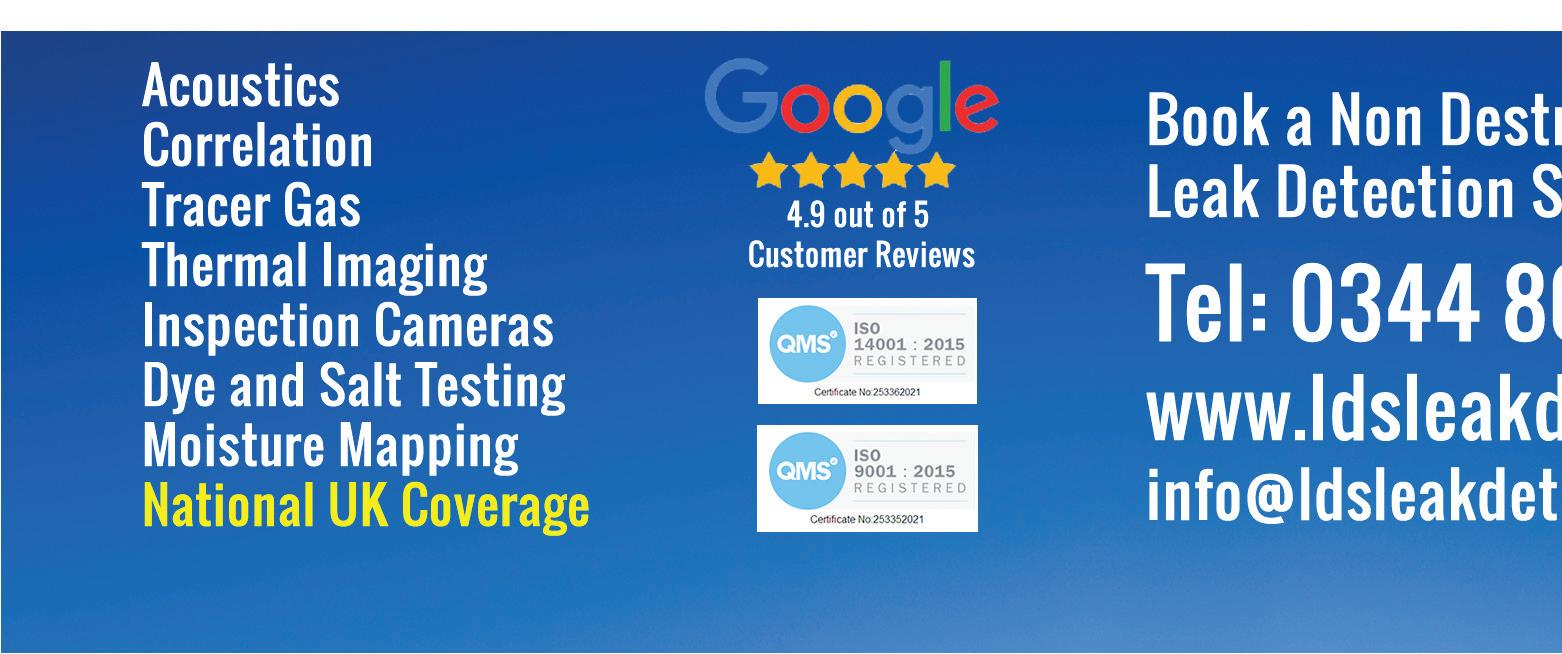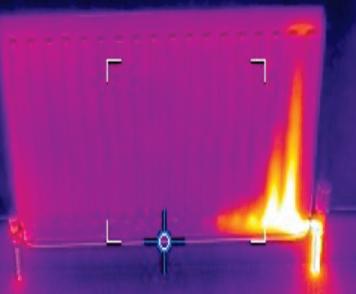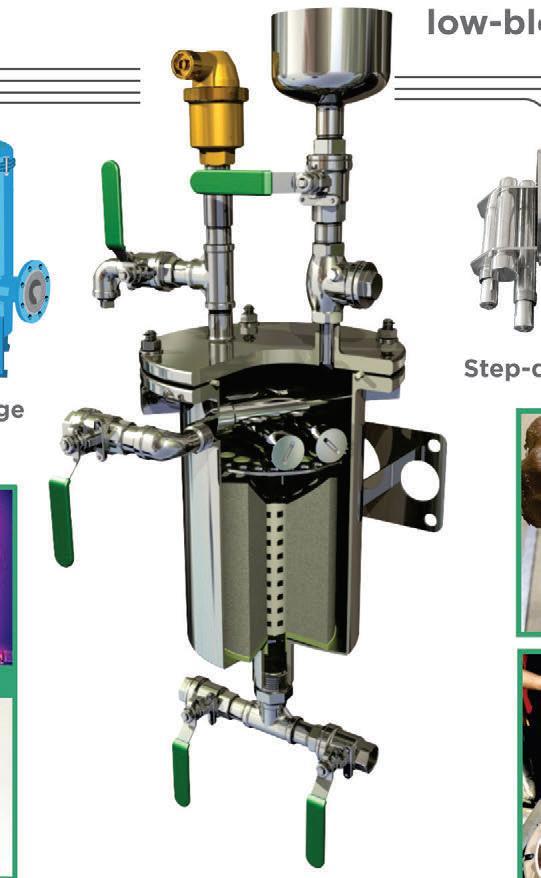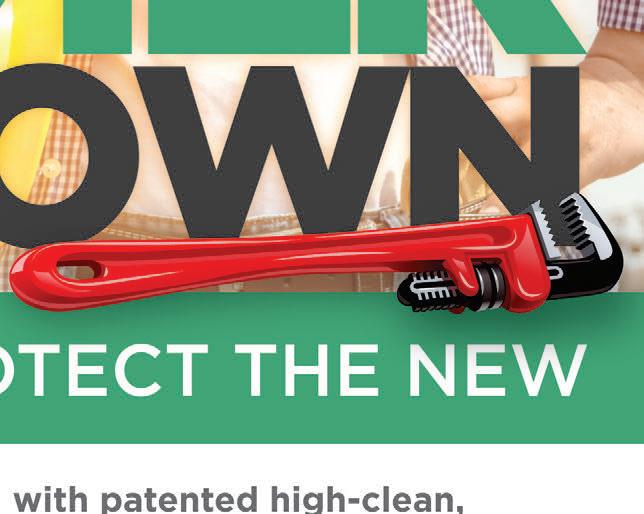

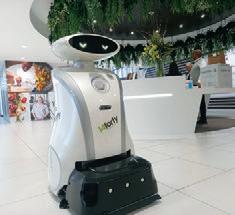




FACILITIES MANAGEMENT JOURNAL VOLUME 30 | 06 JUNE 2022 INTERVIEW
CEO INTERIORS New era of hybrid work 40 32 CLEANING How automation is revolutionising FM 28 O cial magazine FM Clinic: How can FMs manage the rising energy costs of running buildings? LIVING LANDMARK Setting a benchmark of excellence in sustainable building
Raj Krishnamurthy, Freespace
Our 5th generation HydroTap can help workplaces to achieve their sustainability goals while providing users with pure tasting instant filtered boiling, chilled and sparkling drinking water.
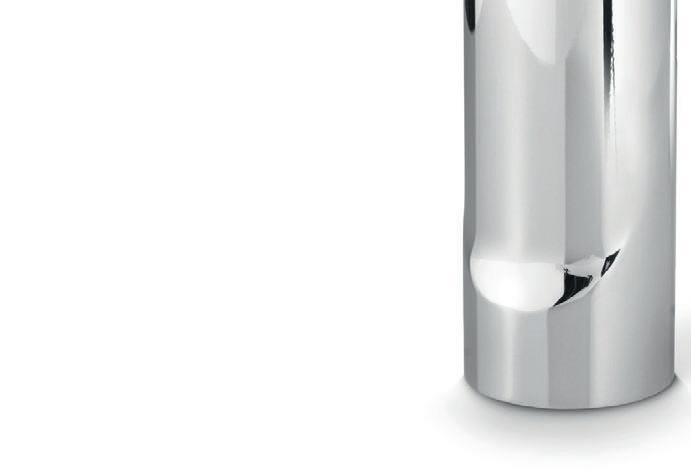
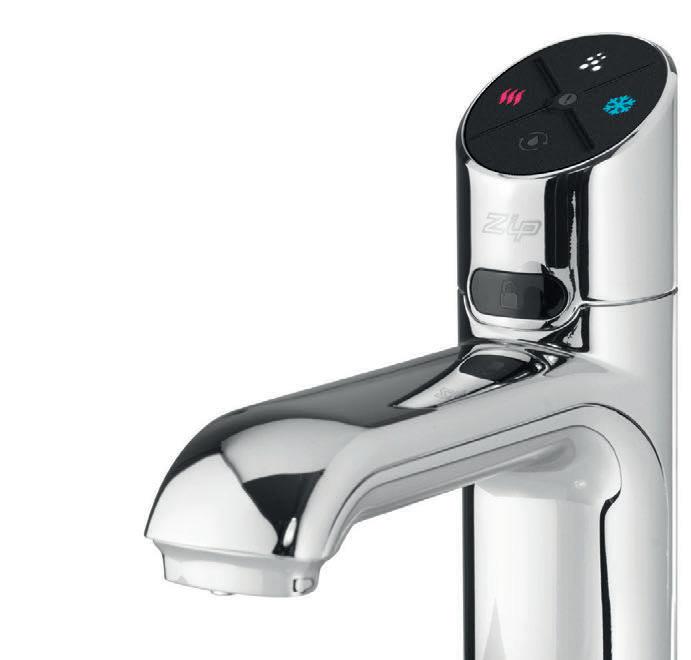
Reduce reliance on single-use plastic water bottles with instant access to pure-tasting filtered water due to 0.2 micron MicroPurity filtrationTM


No water wastage in the cooling process due to the air-cooled system
Features such as the LUX (light) sensor, programmable timer and sleep mode help to conserve energy during periods of low or non usage.
Reduce environmental impact due to the use of R290 refrigerant gas that has a low Global Warming Potential (GWP).










Choose
NEW: Classic Plus tap With SteriTouch
touchpad
kill 99.99%
a choice
or
Call 03456 005005 for more information Scan the QR code to find out more
sustainable drinking water with the Zip HydroTap G5
embedded on the
to
of bacteria. With
of hygiene-centric tap designs, the Classic Plus
Touch Free Wave, you can be sure all users are kept safe.
Why choose HydroTap G5?
kpm media Unit 1 Mill Place, Platt Business Estate, Maidstone Road, Sevenoaks, Kent TN15 8TB Tel: 01322 662289
Editor Sara Bean sara.bean@kpmmedia.co.uk
Assistant Editor & Social Media Development Sarah O’Beirne sarah.obeirne@kpmmedia.co.uk Tel: 01322 476815
Director & Designer Warren Knight warren.knight@kpmmedia.co.uk Mob: 0780 1947757
Sales Director Danny Grange danny.grange@kpmmedia.co.uk Mob: 07867 418994
Business Administrator Sami Smith sami@kpmmedia.co.uk
Accounts Trish Boakes accounts@kpmmedia.co.uk Group CEO Nigel Copp nigel.copp@kpmgroup.co.uk


Editorial steering committee
Alan Hutchinson, Facilities Director, Howard Kennedy LLP
Charles Siddons, Head of Operations, NHS Property Services
Darren Miller, Head of EMEA Facilities Operations, PayPal
Ian Wade, Head of UK Estates, British Medical Association
Lucy Hind, Senior FM Lecturer, Leeds Beckett University
Marie Johnson, Head of Workplace & Wellbeing, Nominet
Russell Wood, Facilities Manager at Dentsu Aegis Network
Russell Burnaby, Head of FM, Regeneration and Environment, Brent Council
Simon Francis, Principal Lead, Estates and Masterplanning, ZSL
Simone Fenton-Jarvis, Workplace Consultancy Director at Relogix
Stephen Bursi, Facilities Lead, BAE Systems
Stephen Vagg, Head of Estates and Strategy, National Express Group PLC
Vicky Thorp, Head of Facilities Management, CLSH Management

kpm media adopts a sustainable policy of using paper from managed forests. Printed in the UK by The Gemini Print Group www.gemini-print.co.uk
The publisher does not necessarily agree with the views and opinions expressed by contributors. No material may be reproduced in part or whole without written permission from the editor. Editorial contributions are accepted on an all-rights basis only. Letters to the editor may be published in their entirety or in edited form and remain the property of kpm media. While due care is taken to ensure the accuracy of information contained in this magazine, the publishers cannot be held responsible for any errors in editorial articles or advertisements. Subscriptions are available to non-qualifying and overseas readers at £120 p.a. (UK), £160 p.a. (EU countries) and £240 p.a. (overseas-other).
this month...
comment
The FMJ team has been out and about recently, from the Facilities Show at London’s ExCeL, to the 2022 Kimberly-Clark Professional Golden Service Awards which recognises excellence by FM companies, contract cleaners and in-house cleaning teams in achieving exceptional standards.
During the Facilities Show FMJ was pleased to host a panel debate, ‘Sustainability in FM and achieving Environmental, Social and Governance’; chaired by Jo Sutherland, MD of Magenta Associates. The importance FMs now place on achieving ESG was reflected in the full house for the event, and the panel didn’t disappoint, covering a range of issues pertaining to ESG, from supporting the circular economy to the huge contribution FM can make to social value strategies. The conclusion of the session was that ESG is a massive strategic opportunity for the FM sector.
Another key area of discussion, echoed at the Golden Service Awards, is that frontline services jobs need to be properly recompensed and sta treated with respect.
Speaking at the keynote event prior to the awards, Jim Melvin the Chairman of The British Cleaning Council revealed he has asked to meet the Cabinet Secretary Simon Case regarding revelations in the Sue Gray report that members of operational sta – in particular cleaners and security sta were shown a “lack of respect” at Downing Street events.
As he notes, “at a time when many cleaning and hygiene operational sta , arguably as frontline workers, were putting themselves directly at risk to maintain high standards of hygiene and ensure that Key Workers and the public were kept as safe as possible during the pandemic, it is absolutely appalling and upsetting to hear that they were being treated with such contempt.” It is yet another reminder why the sector needs to collaborate at an industry level to champion and push forward ESG for both the good of the wider economy and FM.
As always, we’d welcome your feedback about any aspect of the magazine, together with your insight into what’s happening in the FM sector.
sara.bean@kpmmedia.co.uk
JUNE 2022 3 FMJ.CO.UK
© Copyright 2022 kpm media
Total Average Net Circulation 10,641 July 2020 to June 2021 SUPPORTED BY
FACILITIES MANAGEMENT JOURNAL JOBS Find your next role with the FMJ Jobboard Visit jobs.fmj.co.uk for hundreds of roles in FM and associated industries jobs. fmj.co.uk EDITORIAL COMMENT


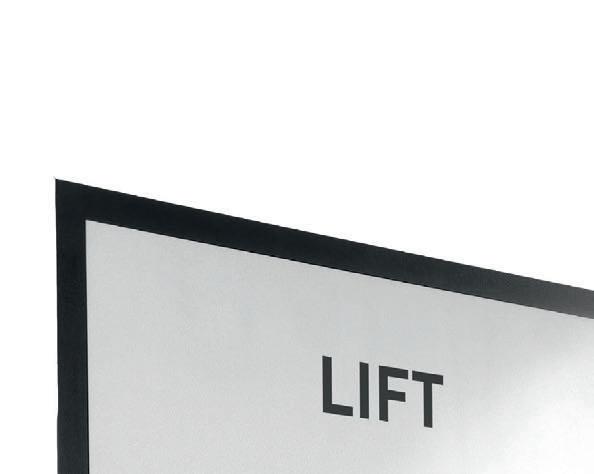

















Signage made simple The professional way to display: DURAFRAME ® Order a FREE sample today duraframesample.com • Self Adhesive or Magnetic • Attach to any surface in seconds • Insert and change posters easily • Variety of colours and sizes available
NEWS & ANALYSIS
FMJ NEWS


06


ASSOCIATION NEWS

08
INTERIORS
All the latest workplace interior trends from this year’s Clerkenwell Design Week.
Steelcase’s Global report, The New Era of Hybrid Work, found 58 per cent of workers now prefer to work from home. Rocio Diez on how good workplace design can help draw them back to the o ice

SIGNAGE
There are many reasons why FMs need to ensure signage suppliers are operating in as green a way as possible says Jonathan Hitch of Widd Signs
INTERVIEW
OPINION
Dan Teare from mpro5 on the benefits of integrating IoT, smart platforms, and realtime data into asset management.
Changing call handling strategies will not only reduce pressure on current resources, but also ensures the highest levels of customer care says Jess Pritchard of Moneypenny.
COMPLIANCE
Nicola Smyrl, a partner in the Luton O ice of Taylor Walton, warns employers to takes steps to prepare now for changes to right to work checks.



FAST FACTS
Dr Addy Pope, Higher Education Manager at Esri UK, examines the growth of indoor mapping in higher education.

BLOG & SOCIAL MEDIA


ESG and sustainability activities are more than just “good practice” says Clare Legrys Principal Risk Manager/HSEQ Manager, Vercity Consultancy.
FM CLINIC
With the rising cost of energy how are FMs managing the extra costs required in running buildings and is the energy crisis encouraging organisations to invest more in renewables?
ENERGY MANAGEMENT







Next Edition
The July issue includes a visit to global real estate solutions provider M&G’s London o ice to see how workplace management technology from Spica is being deployed to enhance the experience of building occupants. In ergonomics, sit-stand desks have surged in popularity in o ice spaces in recent years – but an ergonomist asks, are they making the di erence they should? The BPCA o ers the latest guidance for FMs who may have found that changes in working patterns have led to an increase in pest infestations in buildings. We look at the di erent approaches’ organisations can take to personalise the kind of front of house experience visitors and occupants are o ered; whether they’re guests or employees, are neurodiverse or neurotypical. And we report from the BCO conference taking place in Manchester this June.

JUNE 2022 5 FMJ.CO.UK THIS MONTH...
32
34
36
38
Danny Adamson, MD at Stocksigns on the relevant regulations for workplace signage and how facilities managers can ensure they comply
40
Raj Krishnamurthy, CEO at Freespace says employee preferences and needs are shaping the future, which is why dynamic capacity planning holds the key to the way we manage workspaces
44 The latest machine learning tools are helping to optimise energy e iciency and reduce emissions across a retailer’s
of stores. PEOPLE 55 Find out who’s moving where in the facilities management profession. RECRUITMENT 56 Gary Cattermole, Director of The Survey Initiative, says it’s more important than ever to measure the levels of employee engagement and loyalty given hybrid work patterns. TRAINING 57 Coaching is usually reserved for current or future leaders. It’s time it was opened up to include all employees says Simon Lyle, MD of Randstad RiseSmart UK. CAREERS NEWS 58 A brief roundup of the latest careers news in the facilities management sector. CASE STUDY 24 A new o ice building in London’s Victoria is designed as a living landmark which sets a new benchmark of excellence that delivers a sustainable, future-proofed workplace CLEANING 28 Collaborative robots or
are designed to improve e iciency and support manpower in cleaning services. We look at how automation is revolutionising how FMs manage cleaning regimes FEATURES 24 FM CAREERS 57
portfolio
‘cobots’
sara.bean@kpmmedia.co.uk
46
To register for your free copy of FMJ visit fmj.co.uk MIFM
New product and service launches and company news from the FM industry.
10
COMMENT 12
14
16
18
20
ADVICE AND OPINION 16
This month’s summary of everything that has hit the headlines in the FM sector.
CONTENTS Follow us on Facebook and Twitter @FMJtoday
The latest news and views from RICS-IFMA and IWFM.
LEGAL VIEW
REPUTATION IS KEY. HOW ORGANISATIONS SHOULD BE DEALING WITH NEGATIVE SOCIAL MEDIA
Pauline Lépissier, Solicitor at Devonshires
law firm
A company’s reputation is one of its key assets. With many now taking to the internet to voice their opinions on businesses, I am seeing an increase in clients seeking my assistance with protecting them against the potential damage of negative online posts.
Sometimes it is a simple matter of customer service, if a dissatisfied user raises a genuine issue. It is advisable to have trained individuals to deal with these matters.
Other times however, an individual decides to publish negative falsehoods about a company. The law can help in these situations. As a simplistic summary, libel (which refers to written statements, as opposed to verbal slander) involves the publishing of a statement about your company which lowers it in the estimation of right-thinking members of society generally and which is likely to cause serious financial loss. Defences to a claim include that the statement is substantially true, that it constitutes honest opinion, or that the publication was a matter of public interest.
As many who have been following the “Wagatha Christie” trial have realised, while any litigation is risky, defamation cases can be particularly so. Although a successful claim can fully vindicate a defamed claimant and clear their name, there is also the risk of doing more damage to your reputation by airing your dirty laundry in a very public fashion. Of course, sometimes litigation becomes the only option.
Equally, there are many things that can be done before you get to this point. Setting out a prospective claim against the authors of defamatory posts or reviews in a letter before action can allow you to negotiate that they take it down, or some other remedy such as a correction.
Liaising with the website operator or social media platform can at times assist. Such operators generally have a defence against claims in defamation if they are not the author, provided they have not acted with malice. However, they are much more receptive to complaints that a statement breaches their guidelines, for example if it promotes hateful conduct.
You are also not powerless against anonymous online trolls. If you do not have details for the author of a defamatory statement, there is a process under applicable regulations that operators can be convinced to follow if you can show that the statements are defamatory and false. On receipt of a notice in a specified form, operators must within 48 hours either remove the post if they do not have contact details for its author, or notify the poster that it will be removed if they fail to provide their contact details to the operator within five days. Unfortunately, they do not have to agree to their details being shared with you, but the process itself may show those hiding behind anonymity that the company is willing to take action. Operators who do not follow this process can lose their defence to claims in defamation.
If that does not work, Court applications can assist, such as those for a “Norwich Pharmacal Order” requiring the operator to disclose documentation in their possession with identifying information. This is a fairly quick process which operators often do not contest so that the application can be dealt with without a hearing.
In one case I dealt with, a disgruntled former employee had set up an anonymous defamatory “hate group” on Facebook against my client. We obtained a ‘Norwich Pharmacal Order’ against Facebook, who provided us with documents identifying the individual behind it, and told him that they had done so. The individual took the group down once he was found out.


In the most extreme cases where correcting the record is more important than receiving damages, claims can be issued against “persons unknown”.
In short, there are ways to protect your business against defamatory online posts. It is not always easy and very casespecific, but it is always worth seeking advice to see if anything can or should be done.
www.devonshires.com


BCO CALLS FOR THE URGENT NEED TO INVEST IN DESIGN FOR NEURODIVERSITY

The British Council for O ices (BCO) has launched a research report: ‘Designing for Neurodiversity’ which examines how the neurodiverse community remains underserved and o en unsupported in the current employment ecosystem and as a result is hinder wellbeing.
A significant principle of neurodiversity is the belief that it is not the pathology of the condition that causes barriers to societal inclusion or causes a disability; rather, it is the socio-cultural architecture of a society that is only equipped to support a small range of variability. Understanding the di erence can help create a new framework for approaching design, and the ability to make society more just and inclusive.
The report (https://www.bco.org.uk/Research/Publications/Designing_for_ Neurodiversity.aspx) outlines the considerations that built environment practitioners can take to make o ices enabling environments, and the crucial role of more inclusive designs. It integrates the health aspects of an o ice environment with how these a ect access to employment for those who identify as neurodiverse. Specifically, defining an enabling work environment to be one that supports the mental, social, psychological, and physical health of those inhabiting the space.
As well as considering the characteristics that make an enabling environment, BCO says it is important to consider that like all communities, the neurodiverse community is complex and contains a wide range of people with a wide range of needs. Therefore, each o ice space is an opportunity to build a unique and nuanced relationship with people who will inhabit that space. The report highlights that this starts with creating a set of methods that will delineate how the design team, client and employees will engage in an equitable collaboration with the purpose of creating an enabling environment.
THE OFFICE IS BEING REPURPOSED ON A GLOBAL SCALE FINDS ISS SURVEY

A new global survey by ISS has found employee engagement is now the top priority for global businesses with nearly two-thirds (62 per cent) of respondents saying they are investing in their o ices.

The survey also found that the majority of companies (69 per cent) have no plans to reduce o ice space while those which do plan to reduce are at the same time investing significantly in enabling better innovation and collaboration among their employees. All in all, the o ice is being “repurposed on a global scale”.
The findings are taken from a new survey conducted by ISS, a leading workplace and facility management company, of 100 of its global customers in a range of professional, technology and industrial sectors, including some of the world’s largest banks and professional services firms. The insights are estimated to represent over a million o ice-based employees worldwide.
Workplace priorities have changed significantly for businesses over the past two years. Pre-COVID, operational e iciency and cost savings were two of companies’ most prioritised outcomes for o ice planning and decision making. Today, however, employee engagement is at the top, while talent attraction has also become a new priority in the top five.
To reach their people-focused goals, the majority of companies have chosen to invest in their workplace o erings by upgrading their facilities, o ice environment and employee experiences – primarily to enable better innovation and collaboration by employees, to attract people to the o ice and to enhance the sense of belonging.
The survey also shows that 69 per cent of the companies are either expanding their o ice space, redesigning or keeping what they have or are undecided, while 31 per cent have decided to reduce it. However, the latter group, is also the one that will invest the most in upgrading the workplace.
JUNE 2022 6
NEWS & ANALYSIS FMJ.CO.UK
After financial year 2020/2021 had already been Landmarc and the DTE’s busiest year to date, last year continued to see a huge investment in the Ministry of Defence (MoD)’s 190,000 hectare built and rural military training estate, improving facilities for training troops.

A total value of around £84 million was invested, which is an impressive 68 per cent increase on the £50 million spent in the previous year.
Working in partnership with DIO, one of Landmarc’s highest priorities is to deliver the Command Infrastructure Delivery Plan (CIDP), a plan developed by the Army that details what infrastructure work is needed across the Training Estate. Over 80 per cent (by volume) of Landmarc’s overall infrastructure improvement programme is made up of CIDP tasks, which are managed by its programme delivery teams, supported by core staff and the wider support functions within the business.
The Net-Zero Carbon Accommodation Programme (NetCAP) has dominated programme delivery over the last two years, with phenomenal developments on sites across the UK, and a further 35 buildings scheduled for delivery this financial year.
CLEANING & FM INDUSTRY HONOURED AT
2022 GOLDEN SERVICE AWARDS
2022 Kimberly-Clark Professional Golden Service Award winners:
Healthcare sponsored by the CHSA: OCS for Middleport Healthcare Hospitals: Derrycourt Cleaning Specialists for Mater Private Hospital, Dublin
O ice areas below 100,000 sq. : Principle Cleaning for 22 Bishopsgate
O ice areas between 100,000 and 300,000 sq. sponsored by the Nationwide Hygiene Group: VINCI Facilities for Welsh Government, Cathays Park
O ice areas over 300,000 sq. : Principle Cleaning for The Francis Crick Institute
Education Pre-School and Primary sponsored by Pearroc: Julius Rutherfoord & Co for Portland Place School
Education – Senior and Further Education: Exclusive Services Group for City College Southampton
Retail/Shopping Malls under 1 million sq. : ABM UK for St Stephen’s Shopping Centre, Hull
Retail/Shopping Malls over 1 million sq. sponsored by Truvox: ABM UK for The Centre, Livingston



Manufacturing: Apleona Ireland for West Pharmaceutical

Hospitality: Key Enviro Solutions Limited for St Katharine Docks Estate
Leisure: Joint Winners: ABM UK for TfL Stonebridge Park Depot and ABM

UK for TfL Stratford Market Depot
Environmental Awareness sponsored by Cleaning Matters: Cleanology
Training sponsored by BICSc: Momentum Support
Diversity sponsored by ICCA: Exclusive Services Group Ltd
Going the Extra Mile sponsored by Facilities Management Journal: Birkin Cleaning Services Ltd for Howden UK Group
Small Business: Key Enviro Solutions Limited
Supervisor of the Year sponsored by BioVate Hygienics: Marino Agudelo –Key Enviro Solutions Limited
Cleaning Operative of the Year sponsored by Bunzl: Marianna Pazera, VINCI Facilities
07-09 JUNE 2022 FOOTPRINT+ A zero carbon future Brighton https://www.footprintplus.com/ 08 JUNE 2022 IWFM Conference 2022 30 Euston Square, London, NW1 2FB www.iwfm.org.uk/iwfmconference.html 23 JUNE 2022 NHS Estates and Facilities Conference 15 Hatfields Conference Centre, London https://bit.ly/3NhpiX3 27-28 JUNE 2022 Facilities Management Forum Radisson Blu Hotel, Manchester Airport www.facilitiesmanagementforum.co.uk 14-15 SEPTEMBER 2022 RWM & Letsrecycle Live NEC, Birmingham www.rwmexhibition.com 18-20 SEPTEMBER 2022 The Flooring Show Harrogate Convention Centre, Harrogate www.theflooringshow.com 20-21 SEPTEMBER 2022 Workplace & Facilities Expo RDS Dublin, Ireland www.workplaceandfacilitiesexpo.com 22 SEPTEMBER 2022 Circular Lighting Live Cavendish Centre London https://circularlighting.live/ 27-28 FEBRUARY 2023 Workspace Design Show Business Design Centre, London https://workspaceshow.co.uk 16-18 MAY 2023 www.facilitiesshow.com DATES FOR THE FM DIARY JUNE 2022 7 Landmarc and DIO break Defence Training Estate investment records Landmarc Support Services and the Defence Infrastructure
(DIO) have reported
record 12
delivery
Organisation
a
months of programme
on the Defence Training Estate (DTE).
The elite of the cleaning and FM industry were recognised at the 2022 Kimberly-Clark Professional Golden Service Awards for their outstanding excellence and commitment to deliver performances that continually raise standards – through unprecedented challenging times. Awards were presented to winners across 19 categories at a formal ceremony on 26 May at the InterContinental London Park Lane, hosted by one of the UK’s favourite comedians, Ed Byrne.
FMJ.CO.UK NEWS & ANALYSIS
RICS JOINS COALITION TO CREATE UK NET ZERO CARBON BUILDINGS STANDARD
As the most recent UK Facilities Management Survey revealed, FMs are agreed that a better understanding of the data that a building produces can help organisations make informed decisions and save energy where it’s needed.
This is why we’re pleased to report that RICS has joined a coalition of built environment and real estate bodies to develop a comprehensive and consistent approach to defining and verifying buildings as net zero.
While progress has been made in recent years towards creating a consistent definition of ‘net zero’, the UK Green Building Council recently conducted a market analysis that highlighted the need to create a more robust means for measuring a building’s carbon footprint and verifying it as net zero.
Following this work, a coalition of leading industry bodies, RICS, BBP, BRE, The Carbon Trust, CIBSE, IStructE, LETI, RIBA, and UKGBC, came together to address this challenge, and
have developed the UK Net Zero Carbon Buildings Standard.
The new UK Net Zero Carbon Buildings Standard will create a standard model to measure and validate a building as net zero. The Technical Standard will be published later this year and is being overseen by the Technical Steering Group, to which RICS is a member. The Standard will cover all building types, including new and existing builds, and will set out performance targets to address both operational and embodied carbon emissions, in line with the UK’s 2035 and 2050 targets. Furthermore, the Standard will also extend into procurement and residual emission treatment such as carbon o setting – allowing for a compressive assessment of an asset’s carbon impact.
RICS and its members will be at the forefront in enabling this Standard to be delivered and e ective. The RICS developed Whole Life Carbon Assessment will support surveyors in accurately measuring and capturing the carbon emissions associated with a building, with data collected helping to identify and support a building’s pathway to net zero.

This data can be inputted into the soon-tolaunch Built Environment Carbon Database, the




AGENTS OF CHANGE: FM’S ROLE IN LEADING A SUSTAINABLE FUTURE
or decades, workplace and FM professionals have played a critical role in the sustainability agenda, but over time the focus has changed. As the temperature has risen literally and metaphorically on this critical issue, minimising harm to the environment, such as through waste and energy management, has become addressing the climate emergency and benefitting society more widely, such as through social value.

Last month, we celebrated World FM Day with a week of activity on its 2022 theme of “Leading a sustainable future”. IWFM volunteers were busy hosting online and face-to-face events, and our Sustainability Special Interest Group published articles each day discussing the key issues in that sphere.
FIn one piece, IWFM Sustainability SIG Chair Greg Davies puts the challenge plainly: “FM in organisations directly a ects and influences more areas of sustainability than any other function. As workplace and FM became central to organisations’ success over the pandemic, so our profession must be front and centre if the same is going to be true for the sustainable future we all need to achieve. But are we ready for the opportunity?”

Is our profession ready? While I would preface my answer with an acknowledgement that continuing professional development, updating knowledge and upskilling are key critical for ensuring practitioners stay on top of their game, my response to that question would be an emphatic “Yes!”
Another, perhaps even more important question for me would be, are employers ready?
Based on last year’s IWFM Sustainability Survey, the evidence is concerning. In the 2021 report’s
tool designed to become the UK’s main source for carbon estimations and benchmarking for the real estate and construction sector.
Furthermore, the Standard will be governed by the creation of a Governance Board which will ensure a robust delivery of the Standard and its strategic goals.
This Standard is the latest announcement as part of the RICS commitment towards sustainability and the creation of a low-carbon, energy e icient built environment. This includes ongoing RICS work to develop and upskill surveyors to address the growing need for energy-e iciency and retrofitting, and the creation of the International Cost Management Standard 3rd edition – a world first for cost and carbon management benchmarking in the construction industry.
Sustainability is perhaps the greatest challenge to face the built environment and FM profession and the solutions that must be developed will require professionals to be at the heart of them. The FM industry will be central in developing innovation and collaborative solutions at a practical level to this global challenge.
foreword, I summarised the findings as follows:
“There appears to be lacking a holistic, longterm approach in organisations to determining and delivering the outcomes that meaningful sustainability action requires. Concerted action is needed to deliver in this area and for our members consistently to be in a position to deliver on the role they are best placed to take.”
However well placed our profession may be, FMs can only drive the changes and results needed if they are not restrained by the organisations they serve.
The 2022 edition of IWFM’s long running Sustainability Survey will launch this month and the main question on my mind is whether we will see a closing of the gap between action and intent a year on – during which COP26 has added further pressure on business to meet targets, while the geopolitical situation and its fallout may be placing equal but opposite pressure to deal with even more immediate economic challenges.
We are now about a quarter way through the “Decade of Action”, so action must match or exceed intentions very soon if we are to avoid disaster.

JUNE 2022 8 ASSOCIATION NEWS
IWFM CEO, Linda Hausmanis
NEWS & ANALYSIS FMJ.CO.UK
Paul Bagust - RICS Head of Property Standards
The provisions of the Regulatory Reform (Fire Safety) Order 2005 and BS 9999, are well established and understood. The new Building Safety Act now calls for each building to have a designated ‘Accountable Person’ to ensure compliance. If you are a building owner or manager, this could mean you.
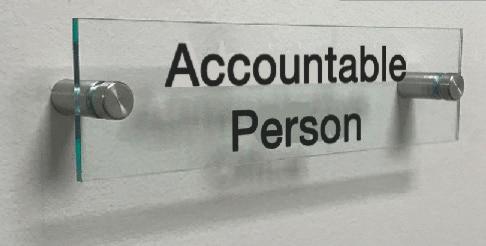
Fortunately, Colt has been at the forefront of smoke control system design and installation since the early 1950s and is uniquely qualified to help you stay on the right side of the law.
A Colt service contract will keep you legal.

Only Colt has the depth of experience, the expertise and the national coverage to mitigate this weighty responsibility.
Our consultants are fully conversant with all smoke control systems, whether designed by Colt or other manufacturers.




They undergo regular training sessions to ensure that their knowledge of new products, systems and the ever-changing regulatory landscape is always up to date.
Colt has the qualified engineers to ensure that every part of your smoke control system will perform as intended in the event of a real emergency.
Colt is the UK’s first company to be awarded certification to both IFC SDI 19 and SDI 05. Put us to the test.

To find out more or organise a survey, visit us at: coltinfo.co.uk/service-maintenance.html call us on 02392 491735 or email service@uk.coltgroup.com
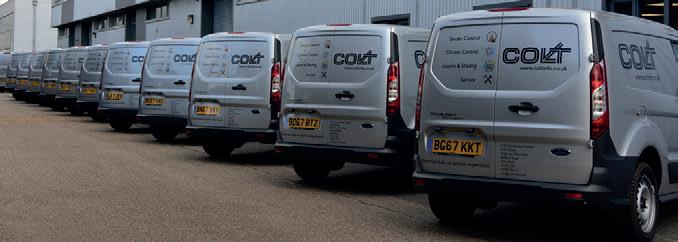
Choose Colt
Does the buck stop with you? Service Expertise built on experience.
is getting personal.
Let Colt keep you legal. Mobility is key to Colt’s ability to reach you in a timely manner, anywhere in the UK. Our engineers assess components for re-use, repair or replacement.
The law around smoke control compliance
HEALTH CHECKS
about an asset will better inform you on the lifespan of parts and give you immediate alerts on many faults.
For example, if you fix an issue with an air conditioning unit three months before its sixmonth PPM check, you should be able to update your database and move the scheduled check further in advance to reflect the recent fix. In short, proactively updating your schedules will allow you to work flexibly and e iciently.
Updating your information proactively, whether through a field application or a er the fact, will help to create real-time PPM schedules that are more e icient – saving the engineer doing an unnecessary check.
REAL-TIME ASSET LISTS
One of the more time-consuming aspects of asset management is asset surveys. These are o en completed at great cost, eating up time and budget, whenever someone realises that the last list must be out of date.
With IoT, tags, and a smart platform, any new piece of equipment can be tagged and added to the roster, or decommissioned and removed from it –saving time and therefore money spent manually adding items.
The world of the Internet of Things (IoT) is a fast-paced one. With so many new innovations and possibilities in sensor technologies, IoT-connected devices, and the digital tools to manage it all, the potential value that can be added keeps increasing, particularly as the cost of sensors continues to fall drastically.
Asset management is one area in which IoT excels. You can get constant vision over, and insight into, your equipment. When done right, this means each asset, the scheduled and reactive maintenance it goes through, and the model, brand or type of asset chosen, provides maximum value for your operations.

Within the healthcare market, the boost to operational e iciency can be huge The global IoT in healthcare market was valued at $61 billion in 2019, rising to $260 billion in 2027. The new National Standards of Healthcare Cleanliness recognises the role digitisation has in measuring performance: “Electronic audit systems are useful for highlighting trends and hot spots, as well as greater transparency and more e ective sharing of data.”
But IoT is very much a partnership - it has to play well with your so ware architecture, whether that’s a CAFM, a works management tool, an analytics platform or a combination of all three. IoT needs help to give you actionable information and facilitate insight.
The trap people are falling into is one of
compatibility. As this technology becomes more diverse, so does the risk that it won’t be compatible with your data aggregation so ware or hardware. Not all sensors are created equal, and neither are all platforms for managing data. This is why being hardware-agnostic is so important.
You need to have easy access to all this data in one place, both for your own sanity and to drive real improvements.
MORE ACCURATE PROACTIVE MAINTENANCE
IoT sensors can give you advanced warnings for equipment that isn’t functioning at 100 per cent. For example, if a sensor notices an upwards tick in the power consumption of an air conditioning unit, you know that a part is likely to be faulty and you can send an engineer to remediate the problem before it breaks completely.
On the other hand, if another sensor is telling you that it is unusually warm outside; then it’s possible the air conditioning unit is simply working harder. This demonstrates why context is important – you need a full picture to make accurate judgements and deploy your engineers only when they are really needed.
LESS WASTED SCHEDULED MAINTENANCE
With all the data flowing into your CAFM or works management platform, you can start to enhance your Planned Predictive Maintenance (PPM) regime. Combining sensor data with other information
O en, asset surveys take so long that by the time the asset list is finished, it will already be out of date. But by proactively adding every asset to your database, and attaching unique QR codes and sensor data, you will always have an up-to-date list that costs you no money to pull out anytime you need it.
ANALYSIS AND INSIGHT
Your so ware platform of choice may well have the ability to use machine learning to analyse information you manually input – and draw out cost savings. For example, if you have 10 premium air conditioning units, and 30 of another cheaper brand – you may soon learn that you are actually losing money overall because you are having to repair the cheaper brand more frequently.
In this case, even without active sensor technology, your so ware platform can drive cost savings. This is just one example of the many benefits of fully digitising your asset management.
THE VALUE IN AGNOSTIC TECHNOLOGY
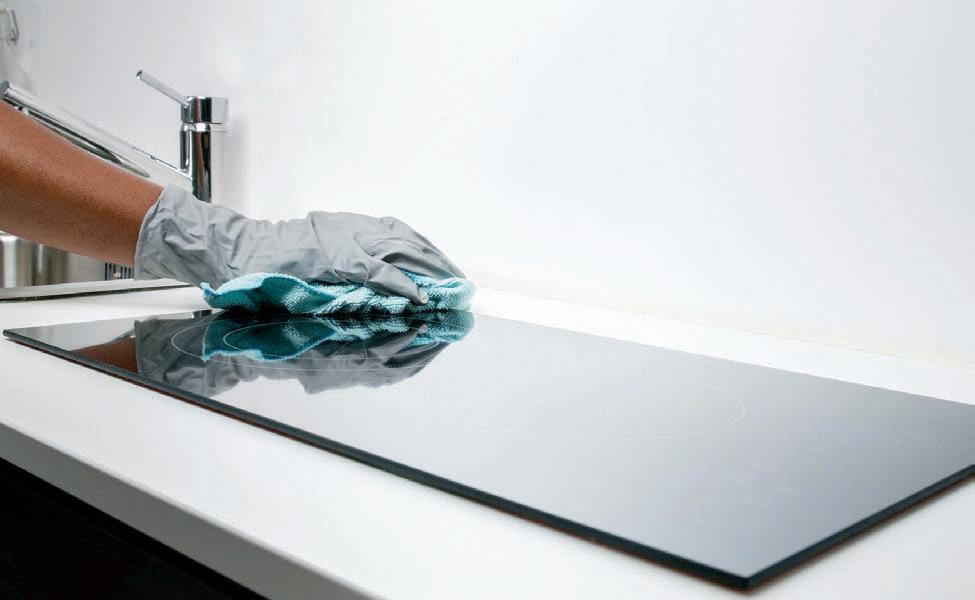
The benefits of going digital and investing in IoT are transformative for asset management. By bringing sensor data into your database, CAFM and works management platform, you can create flexible PPM routines, maximise e iciency and save money. You will learn more about how your assets are used and their condition over time.
But it’s worth remembering that none of this is possible without a flexible approach to implementation, that the core element of a successful rollout will be how well you integrate IoT into your existing or new so ware hierarchy.
OPINION JUNE 2022 10
ADVICE & OPINION
Dan Teare, Healthcare Sector Director at mpro5 on the benefits of taking a flexible approach when integrating IoT, smart platforms, and real-time data into asset management
Some






call it HYBRID WORKING
We call it creating workspaces where people thrive





Where we gather physical and sensory data to improve employee wellbeing and inspire people to connect, collaborate and grow.


This is the Science of Service This is just the star t







mitie.com/scienceofservice



The exceptional, every day
CALL CHANGES
start
During the pandemic, corporate switchboards experienced a shi in phone behaviours as volumes dipped. This was due to the closure of o ices and increased use of collaboration tools such as Zoom and Teams, which transformed communication with colleagues and clients. At the pandemic’s peak, we saw a leading global professional services firm drop from 55,000 calls per month to 14,000 and an engineering firm reduce from 11,000 to just 3,000.
Now, while volumes have largely returned to pre-pandemic levels, it has become harder to predict call volumes which in turn a ects resource. Many FMs furloughed or disbanded front of house and reception teams at the start of the pandemic. Now struggling to refill those roles, and with other in-house departments facing the same challenge, scalable solutions like outsourced switchboard are being called on to manage in-bound calls.
ACCESSIBILITY AND CHANGED BEHAVIOUR
The pandemic was a reminder of the importance of accessibility. We all sought greater reassurance and assistance from the businesses we bought from and worked with, so we took to the phones as well as other channels such as websites, live chat and social media.
Much of this was initiated by the fact many
corporate switchboards couldn’t be operated remotely, especially at the start of 2020, and so businesses had to deploy all available tools to support customers. The lasting behavioural legacy of this is a greater willingness to ‘self-serve’. The nation is now happy to find answers on-line or via tools such as live chat, before they pick up the phone.
The result now is that when people call, it’s because they really need support and from a person. The calls businesses are receiving are the ones that really matter. Call durations are longer, and enquiries are of higher value – these are the calls that businesses can’t a ord to miss. Post-COVID call handling strategies must reflect the emotional motivations and needs of callers and how this has increased call durations; for this has an onerous time and resource implication.
Set against this backdrop, inbound call management must now be viewed strategically rather than tactically as when calls take on new meaning for customers, they must also take on new significance for FMs.


Devising an e ective inbound call management strategy comprises four stages:
1.Monitor and review: An understanding of actual rather than perceived needs, provides
an important place to start. What are the call volumes broken down by time and day? Are there patterns of demand and what are the average call durations? Consult all sta who answer the phone to gauge their views and identify their frustrations. Consider whether people answering the phone stops other important internal activities from happening, as well as what prompts frustration in callers.
2. Categorise calls: Categorising calls helps to understand callers’ needs, their journey and how best to respond. Ask questions such as, are all calls routed to the right person e iciently every time? Are callers given enough time to express their needs, or are they rushed o the phone? Are call handlers suitably empathetic or mindful of customer care practices, or do all sta chip in to answer calls? Are calls answered with the same consistency across multiple sites?
The answers might identify the need for a dedicated recruitment helpline, out of-hours support to reflect typical enquiry times, training for call handlers or use of digital switchboard services with intelligent speech recognition, so that calls can be directed to specific team members easily, wherever they are.
3. Set benchmarks: Suitable standards might include agreeing how callers are greeted, what happens with complex calls (are they escalated or transferred to a specific department) how quickly a call must be answered, the detail that must be captured and when call backs are made. Agreeing these standards will not only provide a useful benchmark but also make it easier for those with call handling responsibility to be consistent. In larger organisations, these standards should tie in with or reflect wider customer care charters or SLAs too.
4. Think resource: This process may reveal there is insu icient resource to handle calls properly – particularly as call durations increase due to more complex needs. In these instances, consider outsourcing for overflow support – which frees up inhouse teams, out of hours support – so that callers never have the frustration of reaching a voicemail, or a fully outsourced solution - which means all calls are answered by a third party. A partner will identify needs, agree protocols and guarantee scalable and professional support in line with demand.
KNOW THE VALUE OF A CALL
Communication is key. Handling calls quickly, e iciently and professionally will help FMs to improve service, revenues and reputation. Those that adapt their call handling strategies will not only reduce pressure on current resource, but also ensure the highest levels of customer care at a time when their value has never been higher.
COMMENT JUNE 2022 12
ADVICE & OPINION
Since the
of 2020, the nation’s phone behaviours have changed dramatically. This presents a new set of considerations for FMs resourcing call handling and devising strategies to manage inbound calls, says Jess Pritchard, Head of Corporate Sector at Moneypenny
Your fi re or smoke dampers can get you into trouble.
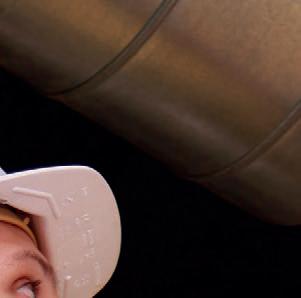

That’s why you need Kingspan Light + Air.




While the Regulatory Reform (Fire Safety) Order 2005 dictates that smoke control systems must be maintained in good working order, the responsibility of ensuring this is effectively achieved can be daunting. Partnering with Kingspan Light + Air will bring you peace of mind and prove your best choice.
The Regulatory Reform Order lays down strict criteria for fi re safety systems in your building. BS 9999 sets out a best practice framework to satisfy these:
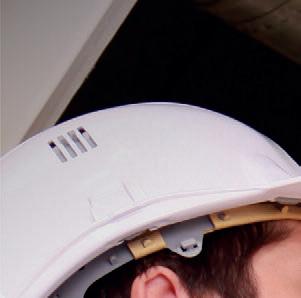

‘All fi re dampers should be tested by a competent person at regular intervals not exceeding one year and should be repaired or replaced immediately if found to be faulty. Spring-operated fi re dampers should be tested annually and fi re dampers situated in dust-laden and similar atmospheres should be tested much more frequently, at periods suited to the degree of pollution.’
One call to Kingspan Light + Air will spare you all this We will look over existing damper maintenance provisions and review all your maintenance processes.
Proper, preventative, pre-emptive service work, undertaken by our qualifi ed specialists, will not only ensure that BS 9999 standards are met in full but can offer considerable savings in time and money. We will conduct the following procedures to ensure that successful and legally compliant damper maintenance is carried out.



Survey and Plan
Our engineers will survey the site, locating and verifying your dampers, to get a clear picture of the scale of the operation and an idea of the existing maintenance schedule.
Service and Report



We will check each damper individually, ascertaining the current operational status of your systems and all the HVAC controls on-site.
Repair and Replace
We will consider which dampers to repair and which to replace, creating a cost-effective strategy for moving forward, without obstructing your day-today operations.


Assist with Asset Register



On completion of the damper review process, we will assist in the completion of all asset registers, including the location, specifi cation and maintenance history for all dampers covered by the service contract. Kingspan


T:
Light + Air Mellyn Mair Business Centre, Lamby Industrial Park, Wentloog Avenue, Cardiff CF3 2EX
+44 (0) 29 2077 6160 E: info@kingspanlightandair.com www.kingspan.com/gb/en-gb/about-kingspan/kingspan-light-air
RIGHT TO WORK CHECKS
In association with
https://taylorwalton.com
The Government has recently announced changes to the ways that employers can perform ‘right to work ’ checks. There have been various press reports in recent weeks warning employers that these changes will be ‘costly’ for employers at a time when many businesses are already a ected by increasing costs.
It is unlawful to employ someone who does not have the right to work in the UK. The consequences of employing an illegal worker are significant and can lead to a criminal conviction and/or a penalty of up to £20,000 per illegal employee. When an employer has carried out an adequate right to work check, the employer has a statutory defence if that worker is later found to be working illegally.


Prior to the pandemic, under Home O ice rules the majority of right to work checks were required to be conducted in-person. The prospective employee showed their documents evidencing their right to work and the employer took copies and kept them.
On 30 March 2020, temporary adjustments were made to the requirement to conduct in-person right to work checks to take account of the Government’s Coronavirus restrictions. The adjustments allow the checks to be carried out over video calls and for job applicants to send a photo of their documents to employers via email, rather than sending the originals.
The Government has announced that the temporary adjustments to right to work checks will end on 30 September 2022. This date has been pushed back on various occasions in response to concerns by employers about having to return to in-person checks. This may be di icult for some employers given the increase in the number of
employees working on a more flexible basis. The Government has recognised that many employers will not wish to return to in-person checks and has announced plans to implement the option to carry out digital or online checks for all employees.
Under the new rules:
From 6 April 2022, foreign nationals who have a biometric residence card, biometric residence permit or frontier worker permit can only be checked online, not manually. They must provide their date of birth and share code to allow the employer to check their status using the Government’s online checking service. This is a free service and as a result, manual checks will no longer be permitted. It will not be necessary for employers to carry out a retrospective check for employees where a manual check was completed on or before 5 April 2022.
In place of adjusted right to work checks, from 1 October 2022, employers will be able to use certified Identity Service Providers (IDSPs) to complete digital right to work checks for British and Irish citizens with valid passports. This will be an alternative to manual checks and the IDSPs will complete these digital ‘right to work’ checks on behalf of employers for a fee. The digital check will involve submitting images of personal documents rather than the original documents using Identity Document Validation Technology instead.
Manual checks can continue to be carried out for employees not covered by point 1 above. This will mainly cover British and Irish nationals who do not require permission to work in the UK.
Employers who have been conducting right to work checks under the current temporary adjusted measures, will need to consider their approach to these checks in the future. If employers do not wish to return to manual checks, they will also need to factor in the costs of performing these checks in their future budgets.
WHAT IMPACT WILL THE CHANGES HAVE ON EMPLOYEES?

At present, it is common for prospective employees to be asked to provide right to work documentation during the early stages of the recruitment process. It is likely that many employers will delay undertaking checks until the later stages of the process, so they do not incur unnecessary costs in relation to candidates who will not ultimately be o ered employment.
An approach which involves checking the right to work at the latest stage possible is also advisable from the perspective of avoiding claims for discrimination. Conducting checks at an early stage of the recruitment process may enable prospective employees to argue that their application has been rejected due to their race or ethnicity.
The Government has issued a new Code of Practice in relation to avoiding discrimination when conducting right to work checks, which all employers would be well advised to review. The Code states the importance of treating all candidates fairly and having clear procedures in place for the recruitment and selection of workers based on equal and fair treatment.
COMPLIANCE 14 JUNE 2022 ADVICE & OPINION
Nicola Smyrl, a partner in the Luton O ce of Taylor Walton who advises employers and employees on a wide range of employment related issues, warns employers to takes steps to prepare now for changes to right to work checks



































Is your existing chiller plant efficient and reliable? We’re here to help. The world is our building. Were all in it together. t 08457 165 162 e customer.care@trane.com www.trane.co.uk
FAST FACTS
INDOOR MAPPING
FMJ AIMS TO SUPPORT TECHNICAL EXPERTISE IN THE FM MARKET
relationships between sta and assets that are moving in space and time. Demand is starting to grow for mobile maps that show an individual their precise location inside a building.
When indoor mapping is linked to maintenance systems for example, sta gain improved work order visibility and greater accountability. By showing and sharing the location of problems and directing maintenance teams or contractors to those jobs, via maps on their mobile phones, workflows become more streamlined. Knowing where your workforce is inside a building also improves collaboration, safety and workforce management overall.
Developments in digital mapping are allowing universities to make buildings smarter and introduce new e ciencies in how they operate. Dr Addy Pope, Higher Education Manager at Esri UK, examines the growth of indoor mapping in higher education

Landscapes, cities and buildings have long been digitally mapped, allowing better decisions to be made about how they are managed. But now mapping is moving inside the buildings themselves. From campuses to o ices, airports to hospitals, indoor mapping gives users an interactive, real-time operational view of any indoor space. Challenged to achieve more with less, indoor mapping is now helping university estates and facility managers tackle rising costs, optimise space usage and streamline maintenance tasks.
WHY DO WE NEED INDOOR MAPPING?
Traditionally, estates managers have relied on CAD drawings (computer-aided design) to depict building interiors or route contractors to where work needs to be done. Yet these static illustrations have limitations and o en don’t reflect the current situation. Firstly, it’s hard to share this data, whether it’s analogue drawings or trying to share a digital 3D model with sta who do not have the specialist so ware required to view it.
O en, CAD images also reflect the
design and not the real-world building, which might have been altered since construction, while looking at di erent floors can mean having to view di erent drawings in di erent formats. These factors present a challenge when locating rooms, assets and making the best use of space and it’s di icult to query the data and make it truly operational for day-to-day use.
INDOOR INTELLIGENCE
Primarily used for facility, estates or building management, indoor mapping gives an instant understanding of an indoor environment, capturing and visualising any type of information in a digital interactive map, from floorplans, rooms and spaces, to maintenance, HVAC and IoT sensor data. But it can also visualise people to improve wayfinding and navigation within a university, or help to find important assets more quickly.
Some users are benefitting from bringing their BIM (Building Information Modelling) and CAD data into an indoor mapping environment because it gives a complete situational awareness of an entire site. This means they now
have the context of a building’s surrounding environment, plus the macro level interior detail of a building, down to individual floors, rooms and spaces. CAFM (Computer Aided Facilities Management) systems and FM databases can also be linked to indoor mapping, to make building management even more seamless and connected.
Indoor mapping can help optimise space and capacity planning, or the allocation of rooms and desk reservations. It can also monitor the health of a building to ensure sta and students are in a safe and productive environment. Any type of sensor data can feed into an indoor map, giving sta a 3D interactive view into how well a space is performing against carbon emissions or energy consumption targets, or humidity, carbon monoxide or carbon dioxide levels, or other factors such as noise pollution.
WHERE AM I?
To have truly e ective location intelligence inside, people also need to know their current location and see
This is where IPS or ‘Indoor Positioning System’ technology is starting to prove invaluable as GPS-enabled mobile phones lose their accuracy indoors. IPS systems are needed to provide indoor navigation and wayfinding capabilities, which use a combination of Wi-Fi and Bluetooth beacons to give the accuracy required. In a similar way to GPS outdoors, they place a blue dot on indoor maps to show users where they are and allow real-time indoor navigation, location sharing and tracking.
COMMON OPERATING PICTURE
Trailblazers in this market include the University of Oxford, which recently upgraded its estates management processes with a new indoor mapping system, providing more e icient methods of maintaining asset data and how it charges university departments and other tenants for the space they use. O ering easy access to property and interiors data across 300+ buildings and 35,000 spaces, the new solution combines over 2,000 floorplans into a single interactive map.
Another innovative example can be found at the University of Edinburgh, who are exploring how the concept of indoor mapping can promote active travel across campus, help students find quiet study space, measure green infrastructure and visualise energy consumption.
Just as with outdoor mapping, everything that happens in a building is tied to a location and bringing it all together in one map makes sense.
Ultimately, indoor mapping provides a common operating picture for university sta , giving them a better understanding of their estates so they can manage them more e iciently.
JUNE 2022 16 ADVICE & OPINION







We’re not your usual waste company We work with you to create value Engaging education programmes Innovative waste technologies One supplier for all your waste streams Earn thousands of pounds from your recycling
SOCIAL - BLOG


CLARE LEGRYS PRINCIPAL RISK MANAGER/HSEQ MANAGER, VERCITY CONSULTANCY


@CIBSE Kevin Mitchell became CIBSE President on 5 May 2022 and gave his inaugural address, Inspire the Next Generation, at the Royal Society (and online). Watch Kevin’s full address to find out more about his aims for the year ahead https:// buff.ly/3PtvoVr #CIBSE125Challenges
@MagentaComms What a fab party we had last night - thanks to all who attended and helped make it a memorable night!
CIOB @theCIOB One of CIOB’s most popular guides, the Code of Practice for Project Management for the Built Environment, has now been updated and a sixth edition published. Read more here: https://orlo.uk/ E8HiZ #CIOB
Matthew Chapman linkedin.com/in/ mpdchapman I’m happy to share that I’m starting a new position as CEO at SBFM. I will be working with the business to continue building on their growth mindset ethos. We share an ambition to reimagine what can be delivered and achieved within the industry, along with the importance of the role we all play for people & places. As I begin this next step, I’d like to thank my colleagues at Atalian Servest UK & Ireland.
Health and Safety Executive @H_S_E HSE is identifying and tackling poor design for tall buildings in England right from the outset of a building’s life. The Planning Gateway One process is paving the way for the more stringent building safety regime. Read more here: https://bit.ly/3x0GWIT
Ballymore @ballymore Three Snowhill in Birmingham, the largest-ever speculative city centre office scheme outside London, has won a 2022 @BCO_UK award – an accolade which recognises the highest quality developments in the office sector across the UK http://ow.ly/zzpB50Jjy8T
Karly Sadler linkedin.com/in/karly-sadler37117b18b Head of Marketing at GreenZone 20 years and 10,000 UK Employers, what phenomenal milestones Living Wage Foundation At the Living Wage Foundation Parliamentry Reception, all the speakers were inspiring but as mum of three, it was truly humbling to listen to the words of the children whose day to day lives are improved through their parents being paid the real living wage.
MORE THAN JUST BEST PRACTICE, ESG IS CRUCIAL FOR BUSINESS HEALTH
Following recent changes to the Social Value Act and increasing focus from corporations, investors and consumers, company ESG (Environmental, Social, and Governance) and sustainability activities are now becoming vitally important to the health and growth of a business and more than just “good practice”.
Companies who are strong on ESG are seen as more stable for investors, particularly as regulators now routinely scrutinise businesses’ financial and environmental disclosures. Rising talent is also more likely to be attracted to companies with good ESG credentials, with studies showing they prefer to work for brands perceived as ethical. To adapt to this driver and better position themselves in the market, many companies have begun to harness recruitment partnerships to consult on how to adopt ESG best-practice and understand the needs of those open to work.
The most e ective ESG strategies ensure room for development against set measurements and frameworks, to accommodate the constantly shi ing goalposts of this business area. Successful ESG shows a willingness to change and a recognition of the need for reactivity and adaptability. Focusing targets and workflows on the long-term picture can be beneficial, particularly in relation to net zero and decarbonisation of the supply chain, while taking cognisance of and adapting to emerging innovations within the current fast-moving industry to ensure they remain achievable. Flexibility may also be required as and when legislation and regulations change, to ensure attainment of the best sustainable global outcomes.
Businesses have also found technology management and data driven outcomes are key to achieving collaborative working arrangements and the overall implementation of successful sustainability strategies. Through use of centralised systems, companies can record and analyse building or project emissions, which in turn allows them to accurately feedback to stakeholders on sustainability performance and achievement of goals. When it comes to facilities management activities, these systems also provide the capability to monitor and measure waste creation, recycling volumes, and materials and product usage, and can build in planned life cycle and obsolescence management.
As a management services provider, Vercity has embraced these notable ESG practices, recognising the need to be an ethical and forward-thinking organisation that places sustainable practices as a key business driver. The company has a proven track record of initiating innovative approaches to social impact, benefitting the global community, and minimising their negative e ects upon

the environment, which is achieved through collaborative working arrangements and actively measuring the business’ direct and indirect e ects. To tackle emissions and environmental harm, we have introduced an environmental aspects and impacts register which sets annual environmental objectives and targets that are monitored on a quarterly basis. This regime aligns with our external certification to ISO 14001 with BSI and the company’s internal benchmarking regime that uses the World Economic Forum’s Four Pillar approach, and is supported by key investors, clients, employees and other stakeholders through close collaboration networks.
Engagement with all stakeholders is key to good ESG practice, however the inclusion of employees is of particular consequence during the formation of company sustainability policies and achieving net zero targets. Many individuals are now demanding more from companies as consumers but may not realise the steps their own company is taking to implement and achieve sustainability goals. At Vercity, sta are encouraged to discuss sustainability and ESG best practice, post articles on initiatives they have personally been involved with and expand their knowledge base via topic specific forums. Additionally, they are invited to take part in studies to determine how commuter and business milage can be reduced and to engage in ESG polls relating to their personal and work-related behaviours, which are both enabled through open dialogue policies and communication systems that provide the means and reasoning for employees to engage with the company’s sustainability practices.
ESG good practice requires communication and accountability at all levels, and partnership with external organisations. Setting out company climate goals which can then be shared with key investors allows a company to be held accountable to its agreements and targets, as well as allowing them to work closely with others to work towards an achievable, cohesive and integrated sustainability and social value strategy.
JUNE 2022 18
ADVICE & OPINION
Clare Legrys, Vercity Consultancy





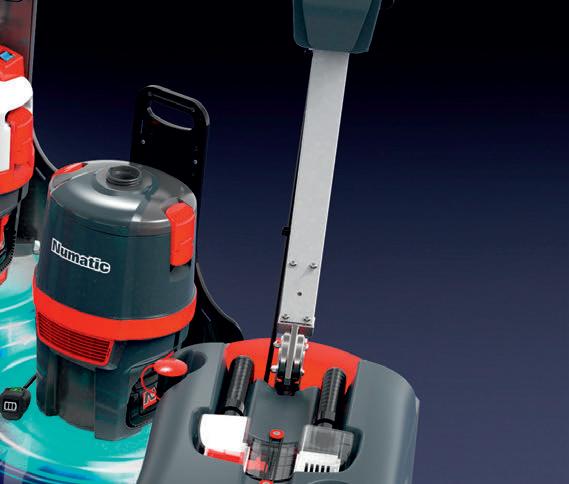
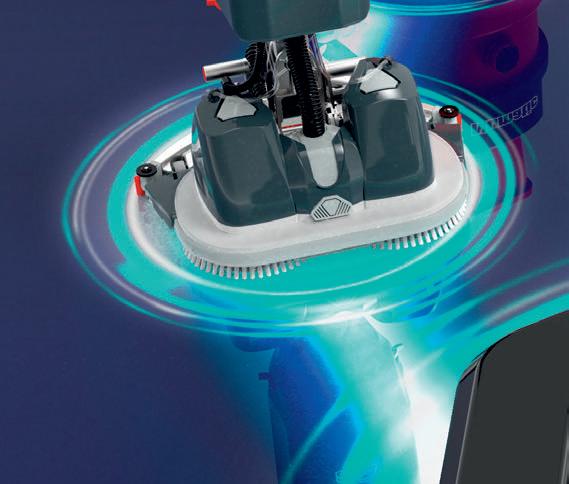
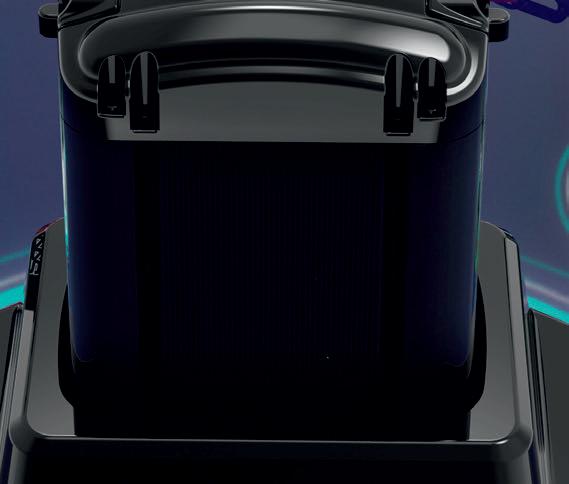














NX300 Pro Cordless Network 36V Lithium Power, Fast Charge, One Fits All Power Driving Productivity Find out more: numatic.com/NX300 numatic.com ©Numatic International Limited 2021. Specification subject to change without prior notice. ©Numatic International Limited 2022. Specification subject to change without prior notice. numatic.com
FM CLINIC
net zero, while keeping prices down. Investment in renewables, onsite generation with a combination of wind, solar and battery storage is clearly the panacea – there is a wealth of grant funding available, and this, combined with current energy prices, means that now is the time to really consider a step change to onsite renewable generation.
The stronger the appetite for this, the more likely it will drive capital investment and strengthen business cases to support investment in energy measures.
A myriad of decarbonisation funding pots has been launched in recent years, which have centred on retrofit models. This


FM ENERGY SPECIALIST’S VIEW
JAMES GRAHAM, MANAGING DIRECTOR FOR EQUANS UK & IRELAND
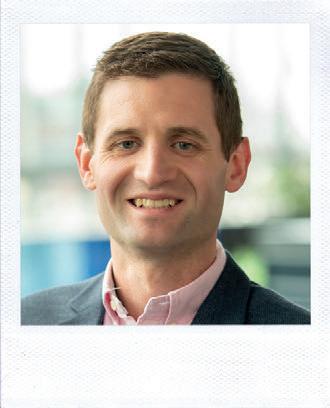
The last few years has seen a series of material challenges for FM’s and indeed most organisations across the globe.

The COVID-19 pandemic interrupted life and work as we knew it, the ongoing pressure to meet net zero carbon targets mounted; and now the energy crisis is impacting individuals and businesses alike with bills rising exponentially. Individually these pose di iculties, and together they can seem overwhelming; but while it might not feel like it – they are collectively lending one another to much-needed action.
Organisations were already looking at ways to invest more in renewable energy sources and the pandemic instigated a revaluation of the archetypal 9-5 o ice job. Throw into the mix the global rise in fuel costs and companies have never been more encouraged to start pushing forward with sustainable solutions.
No longer are simple energy management tools su icient to mitigate escalating costs. Energy costs have risen up the priority list with businesses looking for ways to mitigate the impact. This is compounded by businesses being o ered no protection from OFGEMS price cap, meaning that costs of production are rocketing, and some organisations are looking at the costs of simply keeping the lights on.
This is where FMs can be instrumental. Decarbonisation and facilities management will go hand in hand to driving us towards
not only served to bolster net zero carbon ambitions, but it incentivised organisations to act and fight for their piece of the pie.
To obtain funding through the likes of the Public Sector Decarbonisation Scheme or Social Housing Decarbonisation Fund, local authorities and housing associations had to prove they had a robust delivery partner to achieve their goals. This in turn, put pressure on contractors to ensure decarbonisation was front and centre of any future projects and this stimulated innovation – applying pressure on the experts to seek attainable solutions.
If equivalent capital investment were introduced for sustainable energy management solutions, this would similarly encourage companies across all sectors to take action; and it would drive FM’s to continue innovating. Smart Buildings technology is critical to not only reducing cost but also optimising consumption based on the carbon intensity of the grid. FM’s will also have a bigger role as buildings become more interactive with the grid reducing costs through active demand management.
Our team consistently deliver significant savings generated through their installation, optimisation, and monitoring of building control systems, so we have seen how impactful these measures can be first hand. Every business or individual faces the escalating cost of living but taking action now will help to mitigate those costs and it has the benefit of pushing us closer to our net zero targets.
SUSTAINABILITY CONSULTANT’S VIEW

SERVICES
Our society is currently based on fossil fuels. The move to net-zero needs to happen quickly but it will not happen overnight. Many buildings will not be in a position to completely reconfigure their systems for some time to come.
JUNE 2022 20
DAN ELLIS, HEAD OF ADLER AND ALLAN SUSTAINABILITY CONSULTANCY
With the rising cost of energy how are FMs managing the extra costs required in running buildings? Is the energy crisis encouraging organisations to invest more in renewables to supplement their energy needs as well as address carbon reduction? Do you predict capital investment in energy management solutions will increase?
ADVICE & OPINION
James Graham
In FMJ's regular monthly column, our team of FM experts answer your questions about the world of facilities management
Low carbon fuels such as Hydrotreated Vegetable Oil (HVO) can help in the short term. HVO, as a waste biomass-based product, has 90 per cent fewer emissions than diesel. As it is fully miscible with diesel, it can be used wholly in a system, or as a ‘top-up’ for incremental change. For those hard-to-treat assets, alternative liquid fuels can provide a transitional option.
demand arising from EV charging should be factored into any NetZero Plan for an asset, ensuring that renewable energy is either procured or generated on site to power them wherever possible.
Unfortunately, despite our best e orts in reducing absolute carbon emissions, the e ects of climate change will continue to impact us. Even if we achieve net-zero tomorrow, historical emissions in the atmosphere will continue to heat our planet well into the future.
Therefore, commercial building managers may need to adapt their assets and strengthen resilience.
As we decarbonise our buildings, we will have to decommission legacy fuel infrastructure such as tanks, pipework, and containment. The added benefit of moving to renewable energy is that other risks are reduced; The risk of pollution incidents is mitigated, there are fewer pipes liable to freezing, and maintenance costs and downtime are reduced.
pollution incidents is mitigated, there are fewer



But there is also the chance of unearthing historical pollution issues which may have gone undetected and require remediation. Early investigations help to understand such risks to be factored into the business case.
booming with nearly 473,000 now on UK roads and EVs making up nearly 30
2022. Infrastructure needs to keep pace.
New petrol and diesel car sales are to be banned from 2030. However, the electric vehicle (EV) market is already booming with nearly 473,000 now on UK roads and EVs making up nearly 30 per cent of new car registrations in March 2022. Infrastructure needs to keep pace.
DanEllis

Workplaces, especially those in out-of-town locations, will play a key role in the roll out of an e ective EV network. The ability to charge an EV at work will become a greater priority for employees and free charging will be seen as a value-added perk to attract good talent.
Installing charge-points will increase a site’s energy demand and may require electrical upgrades to accommodate larger and faster charging installations. This additional progressive energy
converted to low and zero carbon technologies – these too should be future-proofed at the time of upgrade.
The changing climate means drier dry spells, more extreme rainfall events, stronger storms, and increased flooding. Higher temperatures mean equipment may have to work harder and draw more power. E ective maintenance is key to ensuring plant remains as e icient as possible. Existing critical infrastructure that may have to remain in place for some time to come, should be protected against physical risks. Where assets are converted to low and zero carbon technologies – these too should be future-proofed at the time of upgrade.
Workplaces, especially those in out-of-town locations, will play a key role in the roll out of an effective EV network. The ability to charge an EV at work will become a greater priority for employees and free charging will be seen as a value-added perk to attract good talent.”
PROPERTY MANAGEMENT CEO’S VIEW





















MATT COULSON, CEO, CHISWICK PARK

ENJOY-WORK
ENJOY-WORK
We have a range of activities already in place to help support the sustainability of our site.
Below is an overview of the ways the FM team is meeting the energy crisis.
Coulson
Chiswick Park is a 1.8 million sq business campus located in West London. Developed in 1999, today it is made up of 12 buildings, bringing together over 10,000 people from some of the world’s leading companies such as Discovery, Paramount Pictures, IMG, Starbucks and Pernod Ricard.
On the campus, we believe in responsible real estate. Our ESG
JUNE 2022 21 FMJ.CO.UK FM CLINIC
Matt
ADVICE & OPINION
Dan Ellis
FM and Property technology to power your organisation and build a sustainable future Coming together to change the future of FM, Real Estate and Workplace software: download our guide CAFM Property Management Workplace Management Mobile Workforce Energy Management
FM CLINIC
strategy is evolving rapidly, and we are committed to ensuring this continues throughout the years ahead. We aspire to lead the way within this area for business campuses throughout the UK and Europe.
We have set a new target to be net zero operational carbon by 2026. With 12 buildings operating 24/7, energy management is a huge part of our ESG strategy. We are constantly trying to reduce energy consumption in our buildings while maintaining a high standard of building services including lighting, heating, ventilation, cooling, and hot water for employees to remain productive. We look at ways to be more energy e icient to guarantee both energy and cost saving whenever we can. Some initiatives can be worth the initial investment as they prove to be more cost-e icient in the long term.
At Chiswick Park, we take a bespoke approach to each building as they are each of di erent age and use, hosting a diverse range of guest companies. We are however committed to optimise energy within all buildings and the estate.
During the last five years, we have conducted several energy audits, invested over £2 million for energy saving projects such as LED lighting, updated BMS strategies, major plant replacements and so ware technology to assist in building optimisation, and conducted many engagement & awareness campaigns for the guests and guest companies working on the campus.
The switch to LED lights, which consume 70-90 per cent less energy than a standard incandescent bulb, helped us deliver significant savings over time.
Our buildings are fitted out with either solar blinds or external louvers that protect windows from the heat of the sun while also allowing more daylight and therefore reducing the need for electric lights. 3 of our buildings also have solar PV system for helping to heat the water.
Most of the areas within our buildings are equipped with occupancy sensors for indoor lighting, so the light is activated as soon as a person enters a room and once movement is not detected, it automatically turns it o .
More generally, we continuously review all building plant operations dependent on occupation and o ice hours to reduce energy usage whenever we can and we run a very tight PPM programme.
A key initiative for us in 2022, is to use a web-based energy related platform to log, track, assess, and monitor in real time everything we do relating to energy management. This is now live in all buildings and we are in the process of rolling this out to all guest companies to aid energy management within their demise.
Reporting and data analysis is critical, the accuracy, the frequency and the actions associated with it. We strive to evolve all that we do in this area and will look at third party certifications to support and recognise this.
In addition, a further main focus is to look at ways to self-generate our own electricity in order to be less dependent on the National Grid. In the long term, we aim to be able to produce our own renewable energy which will be much more beneficial for the environment. We are therefore actively exploring sources of solar and wind energy.
GLOBAL LEADER FOR ENERGY MANAGEMENT’S VIEW

FABIO MONACHESI, ABB SMART POWER
An unprecedented rise in energy prices has made facility managers, especially in Europe, more aware of the intricacies of their energy bills than ever before. At a global level, a barrel of oil was $118 in March 2022 – 38 per cent higher than in January 2022. Gas prices in Europe were equally volatile, with natural gas prices climbing 45 per cent between January and March 2022.
Combined with a growing corporate focus on carbon neutrality, as


companies work to meet the targets laid out in the EU Agenda 2030 to reduce greenhouse gas emissions by 55 per cent compared to 1990 levels, appetite for investing in energy management systems is at an all-time high.
To meet twin goals of reducing operational expenditure and curbing their environmental impact, facility managers must first identify where energy consumption can be reduced. While the traditional approach of comparing monthly bills is still common as a starting point, they are quickly realising that a more granular approach to detecting ine iciencies is needed. More are seeking access to data that enables them to benchmark their performance against other players in the field, putting them in a stronger position to make intelligent decisions, based on quality data and insight.
Fabio Monachesi

Energy management systems allow facility managers to monitor energy use, giving them access to real-time information about how their energy-consuming equipment is performing. Output reports then provide a full cost breakdown, helping them visualise the energy use of their key assets, enhancing the decision-making process for energy e iciency actions and allowing them to create clear sustainability plans to reduce emissions.
When backed up with consolidated data, these reports can give facility managers the confidence to make significant upgrades to operations, for example by replacing low performance power trains with new ones, changes that can then be shared with colleagues across the company and expanded to other sites. Smart connected products such as power quality converters, uninterrupted power suppliers (UPS), transfer switching and advanced relays feeding into an optimisation engine can also help facility managers realise improved outcomes.
Investing in energy management systems is set to become a much more common way for facility managers to achieve concrete savings. Not only is payback relatively rapid, but e ective energy management can lead to more resilient and sustainable facilities.
Expert service providers such as energy service companies (ESCOs) will also play an active role in helping facility managers identify the most appropriate energy management actions for their facilities. These could range from installing meters to investing in energy management platforms, revamping under-performing assets to minimise their carbon footprint or controlling setpoints to improve energy e iciency.
Even before the current energy crisis, the energy management market was growing significantly, with an annual growth rate of 4.1 per cent in the commercial and industrial segments. Looking ahead, the ESCO market is set to grow by 6.5 per cent from 2021 to 2030. Given the current backdrop, there will be no surprises if even more striking figures are released.
Now is the time for facilities managers to take the right decisions to protect their energy bills of the future.
Email: sara.bean@kpmmedia.co.uk
JUNE 2022 22
Do you have a question that you’d like answered by the FMJ Clinic?
ADVICE & OPINION
THE FUTURE OF WASHROOM HYGIENE

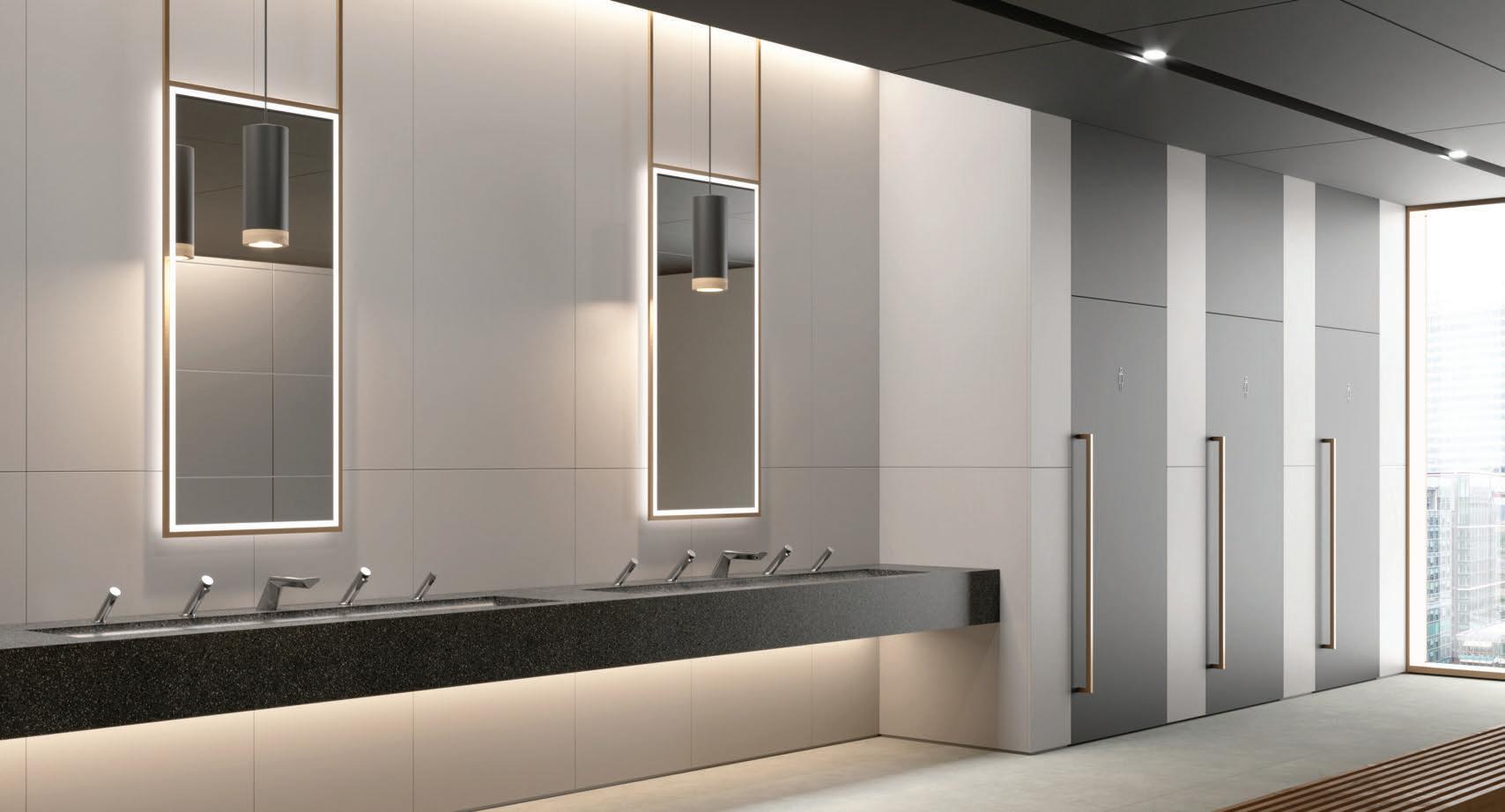






The XLERATORsync ® system is an intuitive, unified experience. In this modern design innovation, water, soap and purified air co-exist alongside a purpose-built custom wash basin. XLERATORsync provides users with a more hygienic washroom experience while allowing them to wash and dry their hands all in one convenient location. Beneath the surface, the system runs on industry-leading, energy-efficient XLERATOR ® technology, with features including a HEPA Filtration System proven to remove 99.999% of bacteria and viruses from the air 1 . CUSTOMISE YOUR XLERATOR sync SYSTEM TODAY. 44 80 8258 3569 xleratorsync.co.uk sales@exceldryer.co.uk 1Based on testing performed by LMS Technologies, April 2020.

BELGRAVE ROAD
VICTORIA LANDMARK
Global real estate development and investment firm Quadrum Global recently commenced construction on the redevelopment of a tired 1950s o ice building at 11 Belgrave Road in Victoria, London. On completion, the building will deliver a new net zero workplace, providing 108,000 sq. of Grade A space across lower ground, ground and seven upper floors.
Designed as a living landmark by Eric Parry Architects and landscape architects Gillespies, and being constructed by BAM, it is being designed to combine beautiful architecture and greenery with outstanding occupier experience, o ering the highest quality, flexible workspaces, state-of-the-art amenities and spacious terraces to cultivate a natural, inspiring environment designed around the occupier.
In addition to o ice space, the ambitious
project includes 14,000 sq. of communal spaces, with best-in-class facilities including a 3,300 sq. café and 5,190 sq. gym. In addition, 13,000 sq. of exceptional green space will be seamlessly woven throughout. There is a 2,600 sq. private garden and a roo op platform o ering panoramic views over the capital.
SUSTAINABILITY STANDARDS



When the scheme completes in late 2023, 11 Belgrave Road aims to take its place as one of London’s healthiest and most sustainable o ice buildings. As well as being net zero in design, construction and operation, it has been designed to meet the highest sustainability and wellbeing credentials.




It is the first in the UK to be awarded a NABERS UK design-reviewed target rating of 5.5 stars out of 6 for energy e iciency; one of only three to achieve a design-reviewed
rating to date. It has also achieved a design stage BREEAM Outstanding rating, putting it in the top one per cent of BREEAM assessed buildings, and UKGBC Net Zero Carbon for construction and operation.

Further, it has achieved WELL Precertification for its commitment to putting occupier wellbeing at the heart of the design and is targeting WELL Platinum certification upon completion and on-site testing. It is also certified WiredScore Platinum and targeting SmartScore Platinum.
Comments Ilyas Aslam, Chief Operating O icer at Quadrum: “11 Belgrave Road has been an exciting opportunity to deliver a ground-breaking, landmark o ice building for the next generation of occupier. By investing time and e ort to pre-certify its credentials, we are demonstrating real value rather than just intention.”
This development comes at a time when
JUNE 2022 24
11
CASE STUDY
A new o ce building in London’s Victoria is designed as a living landmark which sets a new benchmark of excellence that delivers a sustainable, future-proofed workplace
there is a strong focus on sustainability, ESG and energy e iciency. Owners, landlords and occupiers of buildings have a duty to make thoughtful decisions to drive positive environmental impact and help meet UK targets to reach net zero carbon emissions by 2050. To meet these goals, the UK’s commercial real estate sector has to reduce its energy use by 60 per cent by 2050.
Accreditations like NABERS UK, BREEAM and others are gaining momentum and the government is also introducing regulatory changes. The Department for Business, Energy & Industrial Strategy (BEIS) proposals for a six-star sustainability rating will assess energy in-use and hold the industry to account through mandatory reporting requirements.
NABERS UK
Engineering consultancy Max Fordham was selected to act as strategic sustainability consultant, designing a net zero scheme, leading the WiredScore Platinum and SmartScore Platinum targets as well as the NABERS UK process. Max Fordham led on making sure that all elements of the design process for 11 Belgrave Road adhered to the highest standards of environmental performance; environmental firm Delta Green advised on the design stage BREEAM ‘Outstanding’ rating, and Ekkist, one of the leading consultancies in the UK for WELL Certification advised on targeting WELL Platinum.
NABERS UK is a collaboration between NABERS Australia and the Better Buildings Partnership, along with scheme administrator BRE. It adapts an established and highly successful tool in Australia
for the UK and provides a rating of one to six stars for building e iciency, evaluating criteria across energy, water, waste, and indoor environment and benchmarking performance against similar buildings.

NABERS UK’s ‘Design for Performance’ programme enables developers and project teams to target an energy rating at the project
11 Belgrave Road has been an exciting opportunity to deliver a ground-breaking, landmark o ce building for the next generation of occupier. By investing time and e ort to pre-certify its credentials, we are demonstrating real value rather than just intention.”

design stage, verifying it once the building is operational.
The 5.5 NABERS UK rating demonstrates that this o ice has a design, commissioning and handover process that can deliver industry-leading energy use. The project team also worked hard at reducing embodied carbon at both design and construction stage. With Max Fordham’s approach and modelling based on the RICS whole life carbon analysis and the UKGBC
net zero carbon buildings framework, 11 Belgrave Road will achieve 466 kgCO2e/m2 whole life carbon, 38 per cent better than the RIBA 2030 Challenge.
Max Fordham will act as Sustainability Champion, providing a 12-month a ercare period following the occupation of the building to support the building users as well as providing guidance to the facilities manager.
NABERS 5.5 Star Rating features:
» Domestic hot water is supplied from a water sourced heat pump and a calorifier with electric immersion heaters – these recover heat from the ambient loop
» Each air-source heat pump operates under its internal controls to maintain the heating or cooling flow set point (18°C/25°C)
» The building is fully electric, setting a new standard for operational carbon. In addition, 350m2 of high e iciency Photovoltaic solar panels on the roof will reduce CO2 emissions by 35 per cent and supply renewable energy for the building
» A comprehensive rating achievement plan that sets a process for the commissioning and handover and a ercare of the project to ensure that the building is operated in accordance with the design parameters
LINKING SUSTAINABILITY AND OCCUPANT WELLBEING
In addition to NABERS UK, the project benefits from other sustainability and wellbeing features:
» 35 per cent of the existing structure will be maintained, with additional materials largely prepared o -site

JUNE 2022 25 FMJ.CO.UK 11 BELGRAVE ROAD CASE STUDY
» Non-toxic materials such as timber and stone are prioritised, as well as low carbon concrete and less carbon-intensive structural steelwork
» Excellent indoor air quality – passive ventilation and thermal mass are supported by “smart” mechanical ventilation, with display screens to inform occupants of realtime energy use. Mixed mode ventilation removes fine dust, and carbon dioxide and carbon filters further improve air quality
» Pollution-filtering plants, such as ivy in the lightwell, contribute to the removal of toxic pollutants from the atmosphere
» Over 70 per cent of workstations within 7.5m of a window or atrium
» Green roofs on the first and eighth floors provide a rainwater bu er, purify the air, reduce the ambient temperature, and regulate the indoor temperature

» Smart lighting throughout, with presence detection to optimise energy saving. Solar controlled glazing will help to limit the peak solar gains and glare
Describing the approach to ensuring alignment with NABERS UK criteria and more, Henry Pelly, Principal Sustainability Consultant at Max Fordham, says: “Sustainability and occupier wellbeing are closely interlinked and all of our decisions were carefully considered in order to create the most healthy, comfortable spaces possible. We integrated intelligent heating and cooling systems, resulting in a 40 per cent reduction in peak heating demand for the building. Importantly, the building will be thermally comfortable all year round. And even the building’s indoor LED lighting is attuned to circadian rhythms as well as the
natural colour temperature of any particular time of day.”
Once operational, a smart app will o er convenient, digitally-enabled services to tenants – such as a bike booking and charging system (encouraging a greener commute but also health benefits), and smart locker control linked to the on-site gym. It will also allow individuals to adjust specific areas to suit their temperature preferences. Unique biophilic design will re-green the site and a garden space will allow tenants to work in lush greenery.

Two filtered waterpoints on every floor will o er occupants easy access and visual cues to drink water throughout the working day. Further, the colour temperature of the lights throughout the building mimic the natural dynamics of daylight – cooler in the middle of the day and warmer in the evening, while the acoustics have been carefully considered to meet WELL Building Standard requirements.
“The importance of health and wellbeing, and particularly how buildings contribute to this, has taken centre-stage globally over the last few years,” explains Ben Channon and Olga Turner Baker of Ekkist, who consulted on WELL Certification at 11 Belgrave Road.
“As a result, we have seen a rapid rise in the demand for WELL Certification in the UK o ice sector. However, there are still very few WELL Platinum certified buildings that create such a robust and holistic approach to supporting occupant wellbeing. This project will be a leader in its asset class and we hope it will inspire others looking to create healthy buildings.”
ATTRACTING NEXT GENERATION OCCUPIERS
There is no doubt that occupier expectations, needs and behaviours have seen a seismic
shi in recent years, driven by increased awareness of the climate crisis and trends including advancing digitalisation and the pandemic e ect, which brought in new working practices.
Occupiers are rightly more rigorous in assessing the buildings they occupy. Buildings now need to meet the highest ESG standards and o er the flexibility to provide an enhanced experience, accommodating a range of multi-use spaces that cater for everything from private work to relaxation and collaboration...”
Aslam comments: “Occupiers are rightly more rigorous in assessing the buildings they occupy. Buildings now need to meet the highest ESG standards and o er the flexibility to provide an enhanced experience, accommodating a range of multi-use spaces that cater for everything from private work to relaxation and collaboration, and access to nature. They must provide a human touch – a feeling of belonging and community – and support wellbeing, to attract employees not just to the company brand but the o ice as well.”
11 Belgrave Road qualifies as a workplace of the future. It spearheads a welcome step change in our built environment, where we share best practice and create buildings for the benefit of everyone, for their lifetime.
JUNE 2022 26 CASE STUDY 11 BELGRAVE ROAD
A breath of fresh air









According to the WHO, Covid-19 is mainly spread through the air. Rensair’s portable, hospital-grade air purifier is making shared working spaces safer and encouraging a full return to the office.
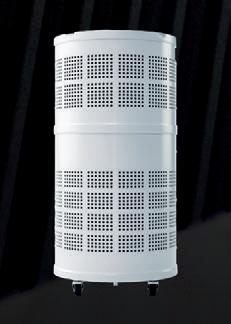
The company’s patented technology combines H13 HEPA filtration with germicidal UVC light, meeting the UK SAGE committee guidelines.







In a test to determine Rensair’s performance in reducing the concentration of Covid-19 surrogate particles in the air, a particle reduction rate of 99.98% was recorded in 15 minutes and above 99.99% in 30 minutes.











Like pure water from the tap, people now expect clean air at work. Rensair’s affordable, practical solution offers a breath of fresh air for companies of all sizes and across all sectors.










–CLICK –TYPE +44 (0)20 3973 8927 –TALK contact@rensair.com rensair.com
To find out more about our hospital-grade, antiviral air purifier:
CLEAN TECH
for 90 per cent of FM leaders. What’s more, 70 per cent of the supply-side organisations we recently surveyed said they are facing increasing pressure from clients to demonstrate innovation.”
FM services providers in turn are finding that demand for cobot technology is also increasing as the range, capability and intelligence of the cleaning technology expands.
Collaborative robots, known as ‘cobots’, designed to work alongside human employees, have seen a marked surge in use over the past 18 months, with more and more of these autonomous machines deployed alongside cleaning teams. The BCC (British Cleaning Council) has described it as the ‘next cleaning revolution’ while the Global B2B Floor Cleaning Robots Market Research Report 2021, predicts the global market will grow by 16 per cent between 2021 and 2027, with the UK market forecast to be worth £105 million by 2027.

Julie Kitchener, Head of Customer Service & Marketing at ICE, an independent provider of cleaning equipment says: “It’s fair to say that adoption of autonomous
cleaning equipment had been slow over the last 10 years, with only a few suppliers in the market. However, this has now dramatically picked up the pace over the last few years with companies starting to understand the benefits that robotic cleaning can bring, and a whole host of robotics suppliers entering the market. We have found that those leading the way with the early adoption of autonomous cleaning equipment have been in retail, healthcare, transport, and education sectors.”
Stefano Bensi, General Manager, So Bank Robotics EMEA says that the availability of cobotics technology is undoubtedly prompting a marked growth in demand from FM service providers.
“Research we carried out in 2020 revealed that innovation is a top business priority
According to Mauro Ortelli, Managing Director of 14forty: “It’s all about choosing the technology that creates e iciency within teams. We can identify which tasks are the most repetitive and timeconsuming and then utilise cobots to assist with these, freeing up team members’ time to focus on more important and complex responsibilities.”
Shaun Robinson, So Services Estimating Manager & Cleaning Subject Matter expert for EMCOR UK agrees: “We are finding that as additional types of cobotic equipment are brought to market it is becoming easier and more relevant to integrate cobotic equipment rather than fully autonomous equipment into our cleaning processes for specialised environments.
“This is resulting in significant productivity gains for our onsite teams when we are able to align the correct piece of equipment with the environment we are cleaning.”
JUNE 2022 28 FOCUS CLEANING
We look at the contribution collaborative robots or ‘cobots’ can make to e ciency and manpower in cleaning services and how automation is revolutionising how FMs manage their cleaning regimes
COLLABORATIVE CLEANING
According to Bensi: “Generally, cobots should undertake the cleaning tasks that are monotonous, dirty or hazardous. This frees up cleaning operatives to concentrate on the higher value and more specialised tasks that they know are important to the customer.
“However, it’s important to remember that cobots never really replace humans. Cleaning cobots still need humans to teach them cleaning routes, recharge their batteries, empty them when they’re full, and aid them if they get stuck. That’s true collaboration.”
At EMCOR reports Robinson: “We have found that the main deployment for cobotic cleaning involves floor cleaning tasks where we can use the units to autonomously clean floors enabling employees to carry out other duties such as emptying bins, dusting, polishing and general tidying duties. One of the benefits is that they can work alongside each other at the same time, which some customers find reassuring as there can still be some trepidation about fully autonomous equipment operating without supervision in sensitive environments.”
Over the past few years, the dual impact of Brexit and COVID has resulted in a recruitment crisis in the cleaning sector, which means these technological inventions could not have come at a better time argues Johan Venter, MD Cleaning for Atalian Servest.
“As the industry struggles to recruit, technology can be the saviour. This will enable FM providers to channel available physical labour to specific cleaning tasks and cobots can fill the gaps within a cleaning specification.”
ICE customer, Stuart Willes - Head of Operations & Facilities, University Hospital Dorset explains why automation has helped his team deal with the recruitment crisis.
“Over the last 18 months or so it has been increasingly di icult to recruit sta as we cannot increase wages as they are designated by national pay spines –other industries such as hospitality are able to entice cleaners with better hourly rates.
“Healthcare however are le to use agencies, or the essential cleaning tasks get missed. For us exploring the use of autonomous machines ensures that we utilise these machines to do the labour intensive but essential cleaning tasks such as the corridors and back of house areas, leaving the full time employed sta to concentrate on ward and hygienic level cleaning.”
RIGHT ENVIRONMENT
Based on current technology, cobots perform best in large, open and uncluttered areas but the technology is improving all the time says Venter. “Manufacturers are working hard at improving the agility of the cobot units to accommodate the everyday demands. In years to come, building design and internal layout will form an important factor for the integration of cobotics, and architects will need to ensure structures and interiors are more cobot friendly.”
“The beauty of cobots is their consistency. Be it vacuuming or hard surface wet
“However,” she explains, “if we allow the cobot to clean the floor and empower the operator to focus on the detailed cleaning, this absolutely supports the delivery of cleaner, healthier spaces. The cobots also deliver quantified, consistent results, and detailed reporting via App’s on important information such as area cleaned, time taken, water used during cleaning, and battery and consumable life remaining.”
Based on this on-board technology adds Venter: “FM providers can obtain data confirming outputs and can also identify any shortfalls in the delivery and adjust
cleaning, the units are programmed in such a way that they will ensure the output remains the same throughout their deployment.”
Kitchener concurs with this point, as she explains, cleaning teams have tried and failed in the past to redistribute resources away from repetitive tasks such as floor cleaning to pay more attention to focusing on things you touch with your handshandles, switches, glass, plus other more di icult areas to clean such as stairs and escalators. Although these are all important – she says, they o en get skipped because they do not form part of the visible routine.
these accordingly. In an environment where KPIs are becoming ever more important, FM providers are now able to evidence compliance.”
“As technology develops there is also growing potential for robotics to do more than one task,” says Robinson. “For example, some robotic scrubber dryers now have the capability to perform UVC light disinfection, which helps to create a healthier environment by disinfecting surfaces, while simultaneously cleaning them.”
They’re also good for the environment: “A key benefit is that they are extremely

JUNE 2022 29 FMJ.CO.UK CLEANING FOCUS
As technology develops there is also growing potential for robotics to do more than one task,” says Robinson. “For example, some robotic scrubber dryers now have the capability to perform UVC light disinfection, which helps to create a healthier environment by disinfecting surfaces, while simultaneously cleaning them.”
e icient, ensuring the cleaning path is maximised on every pass; they can be charged on o peak tari s, so they are not only e icient but are more cost e ective than conventional cleaning methods.”














Ortelli of 14forty says he can certainly see cobots helping them to achieve Net Zero by 2030 when it comes to their cleaning services.
“We
that the key to
issue is how much time is needed to change cultural and behavioural attitudes around using robotics. In our experience, it takes approximately five days of working with cleaning teams before they readily adopt the technology.”
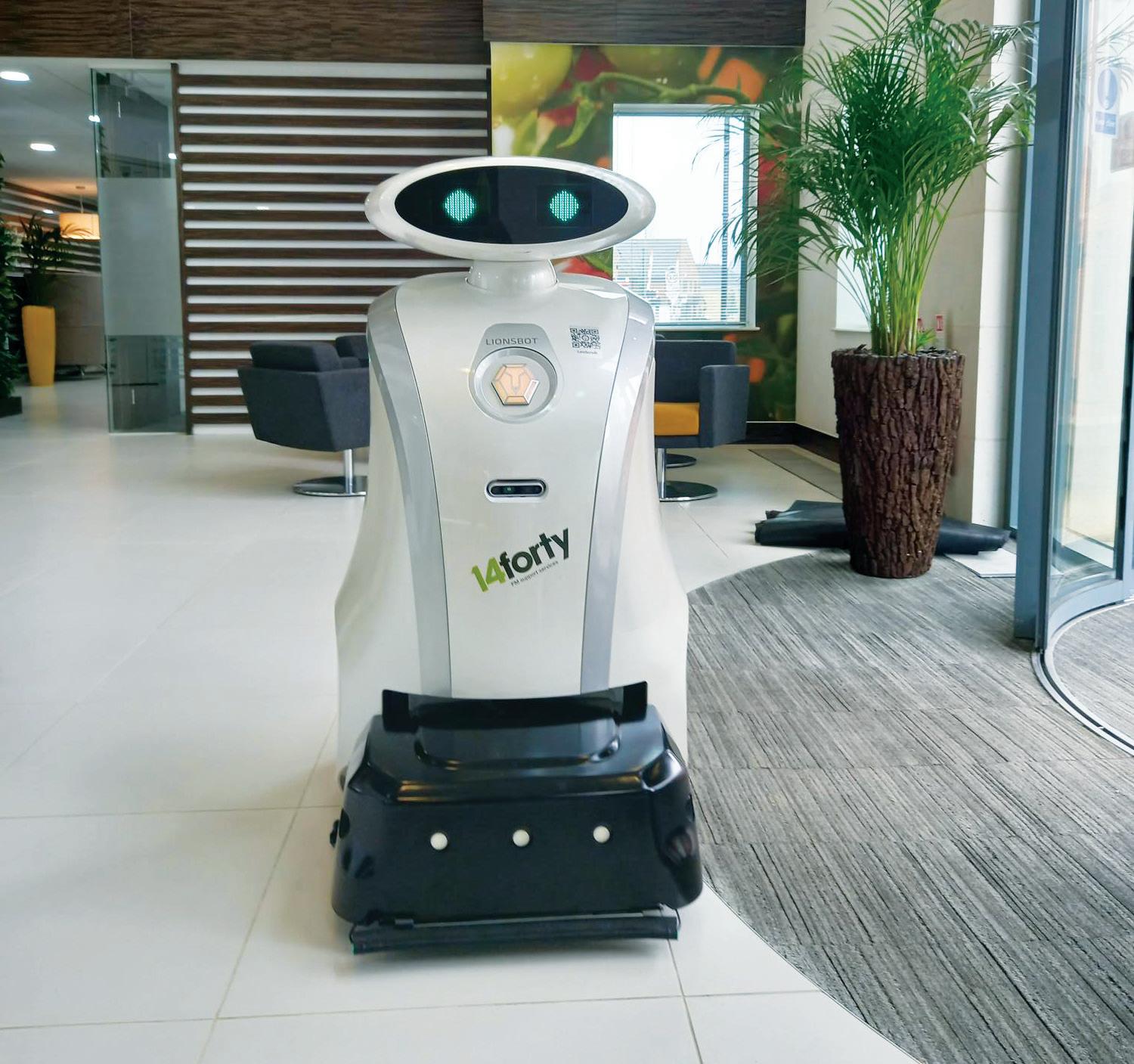
Careful set up is critical to productivity counsels Jean-Patrick Judson, Account Manager at Anabas, with activities split between the cobot and cleaner. “Cobots can only be [made] active following careful initial programming via a series of sensors which tell the bot where to go. This requires analysis of the workspace and a route to be created. Cleaning operatives are also required to maintain the devices, so they are fit for use. Management information and data analysis will need to be conducted by cleaning operatives.”
He adds: “Extensive data will be provided so operatives need to be upskilled to be able to manage it. It’s not concentrated to just cleaning teams though. Security teams, for example, can be trained to operate cobots during the evening when sites are unoccupied.”
also






using more eco-friendly This requires fully involving the
“The cobot we use, manufactured by Killis, uses 70 per cent less water and fewer chemicals than traditional cleaning products, for example. This means that we are not only significantly reducing our water waste, but we’re also using more eco-friendly products at the same time.”
TRAINING ISSUES
Of course, for cobotics to truly deliver benefit it’s essential that cleaning teams are on board with both utilising and deploying the new technology. According to Kitchener challenges can vary from operatives being concerned that they are being replaced by machines or how they are going to keep up with the technology to operate these machines and facilities companies not being ready to take the next step in innovation.
integrating Cobotics is to collaborate with the cleaning operatives onsite to ensure that the machines become part of the cleaning team and are not seen as a threat or a separate function. This requires fully involving the front-line operators so that they see the real value of the machines as collaborating with them, not replacing them.
“In terms of training to ensure that cobots are used safely and e iciently, at ICE our training and installation programme is ever evolving with the constant feedback we are receiving both from customers and ICE sta .
“We currently o er a three-part training plan that covers everything from daily maintenance to mapping and safe operation. Following this, operators can refer to our training and support packs that are available via our App and online training videos. We also o er top up training on request as well as ‘Train the Trainer’ sessions so any new sta can be trained to operate the machines e ectively and e iciently.”
According to Bensi, training depends on the cobot in question as all require di erent forms of training or mapping. “The bigger
Of course, cobotics is not the only technology being introduced to help automate cleaning processes. During COVID, the widespread adoption of sensors and apps to monitor occupation, not to mention innovations such as electrostatic spraying were all stepped up. A new Cleaning and Hygiene Centre of Excellence was recently launched in Birmingham by Mitie to showcase the latest products and service innovations in the cleaning industry. It has been designed to bring together new equipment and solutions, test new products, develop market leading training for its cleaning colleagues, and trial new sustainability initiatives.
“These [technologies] all now play an important role for FM providers to justify their KPIs,” says Venter. “Key to these applications is the data obtained to realise Management Information (MI). The MI obtained is key to demonstrating specification compliance to clients but is also a powerful tool for FM providers to maximise productivity.
“More recently, heat sensors are being introduced to measure activity within environments with a view to channelling valuable resources on demand to areas requiring cleaning. Where cobots cannot be deployed, FM providers can e ectively monitor cleaning operatives’ entry and departure times, providing valuable timebased activity and productivity data.”




JUNE 2022 30 FOCUS
CLEANING
have found
successfully
machines
customers
As Judson concludes: “With the move to smart buildings that integrate sensors and apps, the future of cleaning will be much more on-demand and congruent to how the workplace is actually used, resulting in greater e iciencies.” sta .
as collaborating
and ICE
o from daily maintenance to mapping and
The cobot we use, manufactured by Killis, uses 70 per cent less water and fewer chemicals than traditional cleaning products, for example. This means that we are not only significantly reducing our water waste, but we’re also using more eco-friendly products at the same time.”

Intellimix® HYGIENE. REDEFINED. LEARN MORE Scan the QR code or visit intellimix.co Created to deliver the latest in hygiene, technology and design. SUPERIOR HYGIENE • Completely touchless • Delivers 100% soap washes LASTING SAVINGS • 85% less water usage • Up to 80% less soap used
CREATIVE COMEBACK
trends
Over 140 world-class design showrooms partnered with CDW from 24-26 May, where visitors to the festival in London’s EC1 area could view the latest designs, innovations and creative ideas, as well as experiencing hundreds of design-led fringe events, pop-ups, workshops, talks and showroom presentations.
Bene, the Austrian manufacturer unveiled CASUAL, a furniture collection consisting of a bench, lounge chair and table all by Bene Designer Christian Horner and displayed in a beautiful vermilion shade. Intended to be places of togetherness and interaction, the benches and tables are available in three heights, so users can converse eye to eye with someone standing while agile working is encouraged at the Medium height with the Low seat height being that of a
classic bench. The design is a response to hybrid working and the fact that informal conversations that couldn’t happen during the WFH era are increasingly important as people return to the o ice. High-seating was a definite trend elsewhere as o ice workers increasingly want to touch down and either engage in concentrated work or come into the workplace to collaborate. Sustainability was also part of the design brief with close attention paid to the reduced use of materials in the product development stage of CASUAL.
Fritz Hansen, which celebrated its 150th anniversary at CDW 2022, marked the occasion with a special installation as well as previewing new products. Deadgood also presented new launches at the event, including ReWork. This design, by David Irwin, is a simple yet comprehensive modular seating collection. It is intended to meet the
demand for dynamic, hybrid workspaces. Thanks to its flexible design, ReWork can be easily reconfigured and is suitable for focused work, collaboration or a mixture of both and can add structure to open plan spaces, creating a focal point within an interior and define areas as required. The collection is a response to the new working patterns and cultures that are becoming entrenched in the modern workplace.
SUSTAINABILITY
Elsewhere sustainability ran through design presented in furniture brands. Arper presented new collections Mixu, Kata and Kinesit Met as well as a new edition of its Aston series. Mixu is a sustainable and versatile collection of chairs and stools designed in collaboration with international architectural and design practice Gensler. Kata by Altherr Désile Park is Arper’s first solid wood lounge chair designed with circular sustainability at its core.
Sustainability was a strong theme at Humanscale too with visitors to the showroom having the opportunity to immerse themselves in the manufacturers e orts to save the planet. Humanscale’s Smart Ocean and Liberty Ocean chairs which utilise material from discarded fishing nets, pulled directly from the ocean were both on display. Product launches, meanwhile, included NeatCharge, Humanscale’s innovative cable free charger for mobile devices. Humanscale also teamed up with Square Mile Farms, an innovative start up, which put urban farms into the heart of cities where people live and work. Two ‘farms’ were on display for Humanscale visitors, providing fresh, healthy zero travel miles produce.

TALKS PROGRAMME
A dynamic talks programme throughout the three days underpinned the products on display. Jane Abernethy, Humanscale’s Chief Sustainability O icer, was live streamed from the US, talking about Designing for People and Planet. The following day, a panel of experts: Martin Gettings – Head of ESG Europe from Brookfield Asset Management, Tariq Abbas – Associate Director at HDR, Lydia Randall - Head of ESG at BDG architecture + design, Sarah Ratcli e, Chief Executive O icer at Better Building Partnership, as well as Humanscale’s Sustainability Ambassador - Hani Hatami discussed ‘Building Inside Out’: sustainability of buildings from the ground up and in. This talk referenced whether sustainability can contribute to the return to the built environment, how a plethora of sustainability awards has sprung up and how to tell the di erence between them; the role of retrofit of buildings and Humanscale’s contribution
JUNE 2022 32 FOCUS INTERIORS
Clerkenwell Design Week returned properly for the first time since 2019 and the event truly delivered in terms of
to net positive manufacturing.
Humanscale’s Hani Hatami also took part in Closing the Loop as part of Conversations at Clerkenwell, which looked at what the furniture industry is doing to marry a circular vision with the reality of a sector which thrives in part, on fashion and change. Elsewhere at this main talks hub in Spa Fields, topics being discussed included biophilic design in practice, the recovery of the high street and the design of a space actively and e ectively support the wellbeing of the people who work there.
Colin Macgadie, Chief Creative O icer at BDG architecture + design, along with Rosie Haslem, Director with Streetsense and Architect Lee Penson was part of a panel at Synergy Commercial Lighting showroom, exploring the importance of the human experience in placemaking. Among other themes, Macgadie referenced the idea of transposing hospitality into the workplace environment.
INSTALLATIONS
Among the installations in and around EC1, BVN Architecture and Second Home collaborated on an innovative site-specific space called WorkPOP. It supported the notion of work-from-anywhere and encouraged experimentation towards pop-up, iterative, workspaces. Visitors were encouraged to step outside of the traditional boundaries of work + place and WorkPOP also featured recycled materials and is designed to be modular. It has a circular lifespan and a er the event, will relocate to the roo op of Second Home’s workspace in London Fields where it will support events and knowledge work for its creative community.
Sessions House was another must-visit destination. Here, sustainable acoustic designers BAUX hosted the global launch of its first ever ceiling product within ‘BAUX Acoustic Lounge’. This lounge is a low climate-impacted installation, designed by BAUX Co-Founders, Form Us With Love,

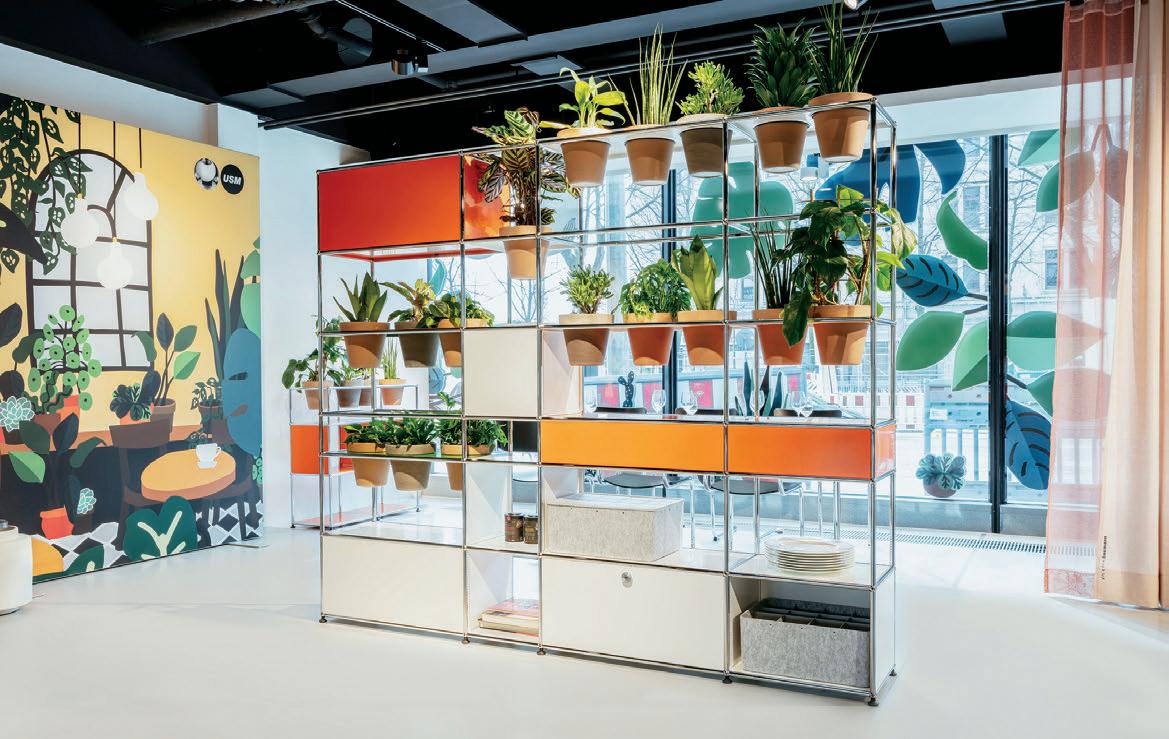
together with BAUX Creative Director Johan Ronnestam. Elsewhere in the space, acoustic brand Texaa presented two acoustic spaces allowing visitors to understand more about the impact of architecture in acoustics through a sound experience that demonstrates how sound influences our perception of space.
Wellness was another key theme at CDW, where USM the Swiss modular furniture manufacturer showcased World of Plants - a stunning installation, suitable for both commercial and residential environments to enable people to enjoy all the positive wellness impacts plants bring; from increasing productivity and reducing stress at work to improving wellbeing at home. Welltek provided a wellbeing hub during the event, where visitors were encouraged to enjoy a moment of calm in a showroom space filled with fresh, filtered air and calming light. Using the Air0 Clean Air System purification system, clean and safe
indoor air is assured, something that has no doubt been at the forefront of facilities managers’ minds in the last two years. The system harnesses state of the art technology to remove even the smallest pollutants from everyday sources such as tra ic, smoke, bacteria, viruses, and chemicals. Visitors to the showroom could also see Artome M10, a state-of-the-art mobile projector and sound-system, which also doubles as an audio-conferencing solution. Those seeking peace and quiet to get some concentrated work done tried out Framery One. This innovative booth design incorporates the latest technology, plus leading sound insulation standards and echo-free acoustics so you can’t be overheard or disturbed. It is fully flexible too, with an electric, height-adjustable table which accommodates laptops, personal devices, and workplace essentials.
Among the various venues within the Clerkenwell postcode, Project, in the picturesque grounds of St James Church was a must-visit. Products on display there included Tablebed from Welltek, an innovative, space-saving design that can be transformed from a table/desk to a bed in a matter of a few seconds. Perhaps a curveball for commercial workspace professionals to consider but nonetheless clearly demonstrates the trend for versatility. The single version is perfect for the hospitality market, meaning a console or work desk doubles up as a spare bed for hotel guests, saving house-keeping time.
All in all this much-loved design festival made a triumphant return, celebrating the creativity throughout London’s historic Clerkenwell.
JUNE 2022 33 FMJ.CO.UK INTERIORS FOCUS
DRAWING DESIGN
keeping on top of how to keep employees engaged and happy has vexed many. While it has been a hurdle, organisations can utilise it as a catalyst for change. The hardest battle to fight is disparity, but it is worth the e ort. Management needs to make sure they are designing the best possible spaces to lower disparity levels. Listening to employees needs from their environment is the best way to make sure all sta remain engaged, no matter their location.
Engagement is o en linked with enjoyment. Unfortunately, there is a clear di erence between the enjoyment of management and employees when in the o ice. Seventy nine per cent of leaders say they prefer working from the o ice, while only 56 per cent of employees say the same. The reason for this divide could be determined by the work being completed and space on o er to do so. As an organisation, giving private workspaces and areas to your employees will help balance this disparity and create an o ice where sta are comfortable, and can work optimally and collaboratively.
WHAT’S NEXT?
Over two years ago the world of work shi ed almost overnight. The home became the o ice for many. While it was a novelty at first, it quickly became deeply ingrained in the national psyche. So much so that while most aspects of a return to normality was celebrated, heading back to the o ice was not embraced by many with open arms. In fact, our Global report, The New Era of Hybrid Work, highlighted that six in ten (58 per cent) workers now prefer to work from home to the o ice. With expectations shi ing, working in the o ice needs to be an enjoyable prospect to tempt people back into the workplace. In an e ort to curb the great resignation, organisations need to redesign their o ice space to become an environment that is suited to the hybrid working style craved by workers in this postpandemic era. So, what is it sta want most from their hybrid working space?
WHY DO EMPLOYEES WANT TO RETURN?
The first thing to address is why are organisations going through all this e ort? There are many selling points to coming back to the o ice for both
the organisation and the employees. Culture is a very important part of returning to the o ice. Globally 30 per cent of employees feel more connected to culture when in the o ice. Steelcase’s study found that enjoying working in the o ice has the biggest impact on engagement, connection to culture and productivity. Shaping spaces and environments that people want to work in can positively impact all these factors. Twent eight per cent of people also shared that (only second to tenure) enjoying working from the o ice contributed to staying in the organisation. Around the world, people enjoy being a part of the environment in their workplace and space and design contribute to this satisfaction.
WHAT EMPLOYEES WANT
One of the most appealing attributes of home working for two-thirds (65 per cent) of UK employees today is to have a dedicated space for work. However, the norm is anything but. In most o ices, the majority (59 per cent) have desks in open areas, o ering minimal privacy. Giving employees their own space in the o ice is therefore an important part of creating an appealing environment.
One thing workers obviously struggled with at home is the ability to work alongside and collaborate with others. Data showed that 64 per cent of workers value hybrid collaboration spaces. Yet, for many, traditional hybrid collaboration spaces come with too many inconveniences; not least of which is the inadequacies of the technology. However, the biggest issue with such spaces sits more in the design. Nearly half of people think the spaces are too small to work collaboratively and can be noisy. These issues need to be addressed.

THE MANAGEMENT EFFORTS
For management teams, the pandemic has been a challenging time to be running a business. From financial worries to the constant need to adapt working practices,
People are social animals and work is inherently a social undertaking. Keeping people tethered to a computer screen is not the answer, nor is keeping them tethered to a workplace that doesn’t help them do their best work.
It’s time to put the needs of people in the forefront and design policies and places that help people and organisations thrive. Communities are living systems, whether they are places people live or groups connected by a shared purpose. Neighbourhoods at work are a base for people, teams or departments. They include a variety of interconnected spaces that support a mixture of uses, feel organic and flow naturally from one to another.
Earning the commute of your workers has never been more important and this post pandemic working style is something for all members of a company to get used to. However, hopefully this article goes some way to help outline what can be changed and improved in an o ice to create a

JUNE 2022 34 FOCUS INTERIORS
A Steelcase report has found that despite the threat of the pandemic receding, over half of sta still prefer working from home. Rocio Diez, Comms Manager EMEA at Steelcase, looks at how good workplace design can help draw them back
PERFECT COLOUR



























Terms and conditions apply. Claims must be made within 6 months of purchase. Proof of purchase required. Colour claims limited to 10L per customer. Manufacturer’s tips and instructions must have been followed. UK purchases only.
CREATED TIME AFTER TIME, CAN AFTER CAN, WITH THE DULUX TRADE PERFORMANCE YOU EXPECT. WE PROMISE. We Promise our paint will give you the perfect colour with a uniform finish and the coverage stated, or we’ll replace it. That’s a promise.
T22096
GOOD SIGNS AHEAD
regulations
they comply
Ensuring safety in the workplace is essential. According to figures from the Health and Safety Executive (HSE), in 2020/21 there were 142 workplace fatalities and 441,000 self-reported workplace injuries, including 102,000 that resulted in an absence from work that lasted more than seven days. There are also an estimated 17,000 new cases of breathing or lung problems caused or worsened by work each year and approximately 12,000 lung disease deaths linked to past exposures at work. The latest Cost to Britain analysis carried out by the HSE suggests that the annual financial impact of workplace illness and injury could be as much as £16.2 billion.
SIGNAGE REGULATIONS
The Health and Safety (Safety Signs and Signals) Regulations 1996 applies in England, Scotland and Wales to all places of work covered by the Health and Safety at Work Act 1974. The Regulations require employers, as well as duty-holders and those who have responsibility for the premises, to ensure that safety signs are in place and maintained where there is a significant risk to health and safety that has not been removed or controlled by other methods. It relates specifically to ensuring the safety of employees and does not apply to non-employees such as visitors to the building. However, other regulations,
including the Health and Safety at Work Act 1974 do include a duty of care to members of the public. Therefore, e ective safety signage can also help to ensure compliance in this area.
In addition, fire legislation, such as the Regulatory Reform (Fire Safety) Order 2005 in England and Wales and the Fire (Scotland) Act 2005 in Scotland, also includes duties and provisions that must be considered when selecting and installing emergency exit and firefighting equipment signage.
To determine what signage is required, employers must carry out a risk assessment to identify hazards, the risks those hazards present and the control measures to be

JUNE 2022 36 FOCUS SIGNAGE
Danny Adamson, Managing Director at Stocksigns looks at the relevant
for workplace signage and provides guidance on how facilities managers can ensure
taken to mitigate these risks. If there is still a significant risk once this process has been completed, then safety signs should be used to warn employees of the hazard or provide instruction on the further measures they should take. The regulations make it clear that signage should not be considered a substitute for other measures such as engineering controls or safe working practices. The regulations also cover the use of acoustic, verbal and hand signals where these are appropriate.
Furthermore, there is an element of training and instruction required. It is important for employees to be aware of and understand the meaning of safety signs and signals either seen or heard during their work. Although most safety signs are selfexplanatory, this does not guarantee that all employees, especially those who are less experienced, will recognise some of the less common symbols. For example, although toxic material or radioactive warning signs are generally recognisable, others such as those that warn of the presence of laser beam generating equipment may not be. Therefore, a small amount of supplementary text alongside the sign may be helpful to ensure full understanding.
PRACTICAL GUIDANCE
Signboards, as the physical signage is referred to in the regulations, should be permanent (unless the workplace or hazard is temporary), durable, securely fastened and properly maintained. They should also be large enough to be seen easily and designed or selected to ensure clear understanding. For example, it should be apparent where and what the hazard is, or where the required equipment is located.
BS EN ISO 7010, introduced in 2011, is the current technical standard for prescribing safety signs. This legislation was adapted from the previously used BS 5499 to provide standardised signage for all European Union member states and remains the standard used in the UK.
While the regulations state that only ISO 7010 compliant fire safety signage should be installed, currently BS 5499 signs do not need to be immediately replaced. However, to ensure consistency, BS 5499 signs cannot be mixed with ISO 7010 compliant signage, meaning that when existing signs are replaced, all signage on the premises must be updated to ISO 7010 versions.
There are five specific categories of safety signage, each of which has specific ‘intrinsic features’ such as the colour, shape and design to aid recognition, especially in an emergency. While the regulations allow some variation in terms of the design, these intrinsic features must be maintained.
Further information on the features of particular signage can be found in guidance documents from the HSE.
Prohibition signs – round with red edging, a diagonal line and black pictogram. These are used to prohibit behaviour that would cause a hazard or impact health and safety. For example, ‘No smoking’, ‘No access for unauthorised persons’ or ‘Do not touch’.
Hazard/Warning signs – triangular with yellow background, black edging and a black pictogram. These are used to alert people to a potential hazard or danger, such as high voltage or dangerous materials.
Mandatory signs – round with a white pictogram on a blue background. These are instructional signs, used to direct behaviour to ensure safety. For example, ‘Eye protection must be worn’.
Fire equipment signs – rectangular or square with a white pictogram on a red background. These indicate the location of fire flighting equipment.
Emergency escape or first-aid signs - rectangular or square with a white pictogram on a green background. These signs provide information designed to enhance safety by directing people to emergency exits, assembly points and first aid materials.
The design and placement of these signs should be considered carefully to ensure they are e ective. They should be placed at an appropriate height, usually eye level, taking into account any potential obstacles that may impact the visibility. The viewing distance should also be considered. For example, in large open plan areas such
as sports halls and stadiums, larger signs should be used to mark fire exits and ensure they can be seen easily.
It is also important to avoid using too many di erent signs in an area as this can lead to confusion and important information or instructions being missed. It is also advisable to remove signs when they are no longer necessary, for example if the hazard is no longer present, to avoid presenting misleading information.
SUPPORT FROM SUPPLIERS
The task of ensuring that all the correct and compliant signage is in place can be di icult, especially for large and complex sites or where a facilities manager is responsible for multiple sites. Working with an experienced and accredited signage supplier has a number of benefits, including peace of mind that all the signs supplied are fully ISO 7010 compliant. Leading suppliers will also be able to provide specific and tailored guidance for the site or premises in question to ensure all legal obligations are met. This can include carrying out a site survey to establish all the needs of the business and o er professional advice on the best options available.
Workplace signage has an important role in ensuring a safer environment for employees where the risk from a given hazard cannot be completely eliminated using other methods. However, ensuring all the correct signage is used in the right place across a business premises can be complex. Therefore, engaging with an experienced and reputable supplier, who can provide valuable support in assessing and fulfilling the needs of the business, is essential.

JUNE 2022 37 FMJ.CO.UK SIGNAGE FOCUS
SUSTAINABLE SIGNAGE
Jonathan Hitch, Estimator Purchasing and Sustainability Lead for Widd Signs explains the many reasons why FMs need to ensure signage suppliers are operating in as green a way as possible
sign will also be made with environmentally responsible inks. Water-based and latex inks are more sustainable solutions than UV and solvent varieties, and manufacturers should also look at joining recycling schemes for which tax credits are available.
BEYOND RAW MATERIALS
The way in which signs are made and distributed is another important consideration that prospective buyers should be making.
Indeed, there are many ways to cut carbon footprints through making on-site e iciencies. For example, we have installed solar panels at our Leeds HQ and have also recently invested in energy e icient upgrades to our St Helens manufacturing site as well as purchasing more sustainable equipment such as our Zund cutting machine.
No matter what set of figures you examine or direction you look in, the world has a massive waste problem. According to data from the World Bank, more than two billion tonnes of municipal solid waste is currently generated annually, and by 2050 that is projected to reach 3.4 billion tonnes in line with a doubling global population. Worryingly, at least one in three of those tonnes are not managed in a way that is environmentally safe.
Looking at our industry, signage waste is not an insignificant problem. Since the 1950s, annual production of plastic has increased 200-fold, with 381 million tonnes produced in 2015 alone.
HOW CAN SIGNAGE BECOME MORE SUSTAINABLE?
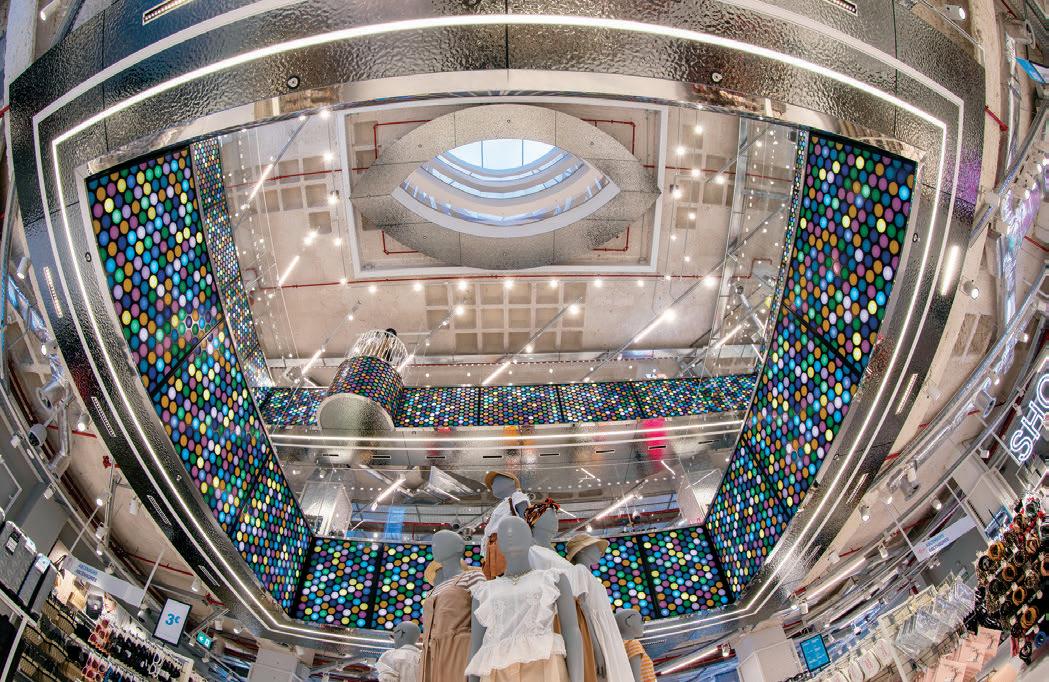
Fortunately, there are a variety of actions that we as signage manufacturers can take to play our part in tackling the wastage problem. In doing so, we can provide responsible solutions for facilities managers to incorporate into their buildings.
The most obvious place to start,
and where my responsibility at Widd centres around, is the supply chain. In particular, I am talking about signs made with responsibly-sourced materials which broadly fall into three categories – so substrates, hard substrates and inks.
SOFT SUBSTRATES: In the area of so substrates, a major focus has been finding alternatives to PVC, which as well as being one of the most environmentally damaging plastics, is also becoming prohibitively expensive.

There are many examples I can share. For o ice interiors, a credible alternative to paint or PVC vinyl are greyback canvas wall coverings made from 100 per cent recycled polyester, which we also use to make banners which carry a higher tensile strength to weight ratio than PVC versions. Moreover, they are recyclable at the end of their life. For retail giant Primark, we recently supplied its She ield store with a greyback canvas using products made from recycled bottles.
HARD SUBSTRATES: For hard substrates, once again, this means

doing away with PVC and exploring alternatives which can feed into the circular economy and provide cost benefits at the same time.
As an example, manufacturers can look at adopting various types of acrylics which can contain anywhere between 70 per cent and 90 per cent recycled materials. Meanwhile, PVC foams can be replaced by polypropylene bubble board which contains up to 50 per cent recycled content, meaning it can go into general council recycling and return schemes. Polypropylene is generally becoming more popular because of this, as well as the fact it becomes stronger the more times it is recycled and repurposed.
Removing plastics altogether is another option signage producers and users should explore. Here, we’re talking about fibre boards, card-based display boards, and paper products which for facilities management represents a good option for short-term signage that is used over a six-to-12-month lifespan. For signs requiring light, LEDs should be used instead of halogen bulbs.
ENVIRONMENTAL INKS: A sustainable
We’ve also invested in electric and hybrid vehicle fleets as another way to boost sustainability credentials and become a more responsible supplier to facilities managers and other clients.
These are all important factors that contribute to sustainable sign-making. With companies and brands under the sustainability microscope like never before, organisations need to take every step possible to demonstrate to their customers and employees that they are taking environmental responsibility seriously. For facilities managers, that means scrutinising every last detail about how their buildings are comprised, which includes signage –how signs are made, what goes into them and how well they’re maintained. Properly preserving a buildings signage will ensure a longer lifespan, saving waste in having to replace signs more frequently.
It is not just sustainability benefits that can be gained through this approach. As we have seen with the rising cost of raw materials, alternative materials to PVC and harmful plastics are becoming increasingly cost-e ective and providing equal or even superior performance.
Indeed, so o en we see sustainable strategies framed in a context of cost versus responsibility. When it comes to signage, it is clear that sustainable solutions are also becoming the most a ordable and high performing.
JUNE 2022 38 FOCUS SIGNAGE
CLOUD9 LEEDS







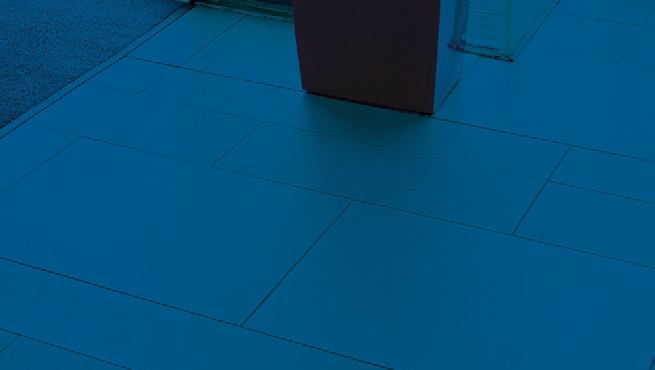




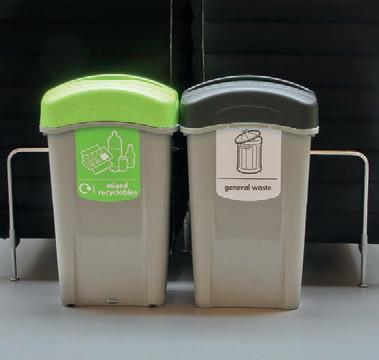
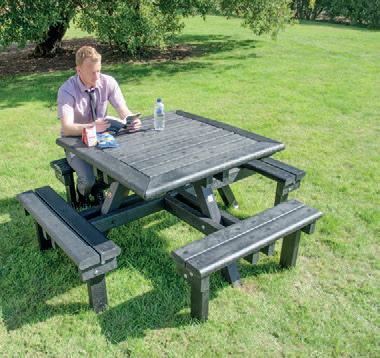
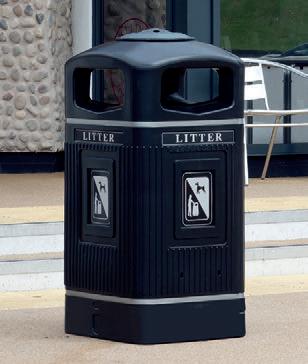
With more than 50 years experience in mat production and innovation, Kleen-Tex provides a wide range of products to reduce dirt and moisture from entering your premises. þ Keep dirt and moisture at bay þ Reduce slip hazards þ Cut cleaning costs MAKE MORE OF YOUR FLOOR For more information: +44 (0)1204 705070 www.kleen-tex.co.uk info@kleen-tex.co.uk www.glasdon.com
PLANNING PROVISION
COVID-19 has changed our lives dramatically.
Two years on from the enforcement of national lockdowns, we’re only now beginning to better understand some of the social and behavioural changes that the virus has instilled for the long term, with pre- and post-pandemic norms varying wildly.
Take the workplace, for example. Where the o ice was previously viewed as the central hub of all working activities, underpinned by strict 9-to-5 cultures and the demand for permanent occupancy, the need for social distancing to protect lives demonstrated to employers and employees alike that home working is both possible and, in several ways, preferable.
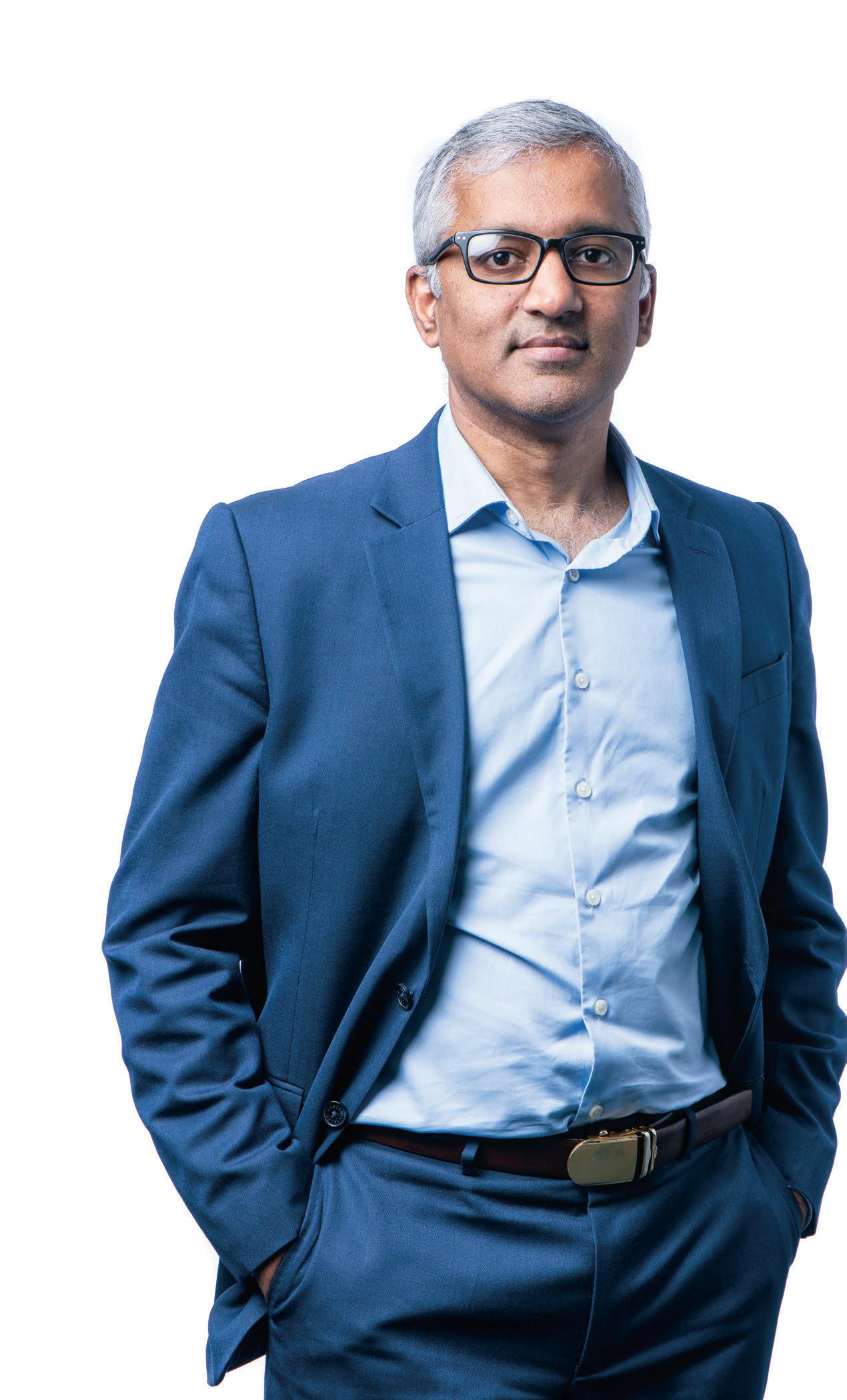
It’s safe to say that the pandemic has had a massive impact on commercial real estate.
While COVID-19 induced turbulence has shaken the sector in the past two years, continually testing its resilience, recent figures suggest that there is still plenty of life in the o ice yet.
According to the Freespace Index, a metric published by Freespace that tracks o ice occupancy, the number of o ices open in both the UK and London in March 2022 reached figures not seen since the start of the pandemic in March 2020. Stipulating that any o ice with occupancy of more than 10 per cent can be considered to be active, its findings reveal 93 per cent of o ices in the UK were open on Tuesday 8 March, with 88 per cent open across London.
Driven by 140,000 sensors dedicated to measuring building occupancy and environmental conditions globally, data from the Index also shows that average o ice occupancy was 39 per cent in the UK and 40 per cent in London, reaching levels not seen since Autumn 2021.
discrepancy between openness and
JUNE 2022 40 FOCUS INTERVIEW
“The
Raj Krishnamurthy, CEO at Freespace discusses the trends driving the boom in hybrid working, how employee preferences and needs are shaping the future, and why dynamic capacity planning holds the key to the way we manage workspaces
occupancy is down to the simple fact that many organisations today have embraced hybrid working models,” explains Raj Krishnamurthy, Freespace’s CEO.
“People have been given more flexibility in their work. In a world where videoconferencing and remote working has become normal, asynchronised operations have proven not just workable but, in many ways, successful.”
FOUNDING FREESPACE
Krishnamurthy isn’t shy about showing his passion for using technology to create futureproofed, value-based solutions. He founded Freespace in 2015 at a time when new ‘agile’ working techniques were evolving with a mission to organise the world’s workspaces to make them as e icient as possible. This need has only been significantly expedited following the pandemic.
To date, Freespace has deployed its enterprise technologies in more than 130 cities around the world, helping its clients to optimise their real estate strategies through the provision of hybrid-working solutions that engage employees, create safe and hygienic environments, inform o ice designs and support the drive to net zero.
“The steady state of the o ice prepandemic was a buzzing, almost hyperactive work environment which was dependent upon synchronous events, synchronous presence, synchronous behaviour. This is no longer the case,” he continues.
“The acceptance of new working patterns has given everybody a newfound freedom to work where they want and how they want; to move the dial between independent and collaborative working as needed.”
Indeed, it is a shi that has changed the entire equation for what equals a successful workplace.
O ices are no longer simply the central hub of productivity. Employees now frequent the workplace for a variety of di erent reasons, including for collaborative opportunities, socialising opportunities, and to work in an environment which stimulates greater productivity and is free from distractions in quiet spaces, while being an invaluable asset for sustaining corporate culture.
“Before COVID-19, headcount and amenity ratios drove demand, while testfits, space plans and lease negotiations drove capacity,” Krishnamurthy explains. “Occupancy planning was static, which made the math straightforward: multiplication, ratios and percentages
with a little geometry thrown in for good measure.
“However, the pandemic has created two new variables: individual employee preferences and time. With teams having more say on when and how much time they spend in the o ice, and what activities they do while there, organisations should forecast requirements on a daily basis to consistently make the best use of the space that they have available.”
DYNAMIC CAPACITY PLANNING
What Krishnamurthy advocates in this arena is dynamic capacity planning. We’ve all seen how workplace demand has become more dynamic. No longer do employees simply expect a desk to work at.
They expect a variety of space options, be it that dedicated desk, quiet areas, relaxation zones, standing desks, collaborative spaces or private meeting rooms.
“You can see this in daily variation in demand,” Krishnamurthy a irms. “Freespace’s data has already shown a huge discrepancy in the number of people in o ices between Tuesday and Thursday
compared to the eerily quiet Fridays. Equally, while typical occupancy might be 20-40 per cent lower than it was prepandemic, the desired use of collaborative spaces has actually gone up.”

To meet changing needs, o ices need changing spaces.
With dynamic capacity planning, organisations assess capacity (space quantity, space typology and standards, asset, tool and services availability and flexibility variables) against demand (team space requirements based on a complex analysis of individual employee needs and preferences for activity-based working, time variables, and team performance goals). In doing so, they can identify opportunities where spaces can be changed to best service its users at all hours of the day.
“Let’s consider a company with 5,000 employees,” Krishnamurthy states.
“Most commercial buildings accommodate somewhere between 200 and 500 people places per floor, so such a company would more than likely be operating across multiple levels – say 10 floors.
“Where hybrid working models typically see occupancy levels at 40 per cent, suddenly there is an opportunity to change capacity based on demand. If only 2,000 people are coming in, I can look to cater to their needs on five floors, perhaps.
“The key is recognising that demand for spaces will change at di erent points. Mondays might see more people coming in to get their head down and require quiet spaces. Tuesday, Wednesday and Thursday,
JUNE 2022 41 FMJ.CO.UK INTERVIEW FOCUS
The steady state of the o ce pre-pandemic was a buzzing, almost hyperactive work environment which was dependent upon synchronous events, synchronous presence, synchronous behaviour. This is no longer the case,”
however, might see people coming in to meet, collaborate and socialise, in which case they’ll need di erent spaces.”

Here lies the benefit of dynamic capacity planning. If companies have the knowledge, data and insights into how their spaces are used and what they need at all times, they may dynamically alter their spaces to meet those needs while also unlocking several other e iciency benefits.
“Perhaps the lower four floors are dedicated to head-down working, and upper four floors are dedicated to collaboration,” the CEO adds. “On Monday you might have four lower and two upper floors open, and Tuesday have two lower and four upper floors open.
“Resultantly, you’re able to meet demand while unlocking massive e iciency gains. When we talk about energy savings, we usually talk about using LED bulbs instead of regular bulbs and things like that. But imagine if you can shut o an entire floor. It would remove massive portions of your electricity usage, your gas usage, usage of your water, your waste generation and the need to dispose, to clear, to clean, to sanitise...”
It is for these reasons that Krishnamurthy argues that dynamic capacity planning is equally important, if not more so, than dynamic demand planning. Indeed, the former allows spaces to be used in a much
smarter manner, benefitting both employer and employee.
DATA USE
Of course, the collection, analysis and use of data is imperative here. Indeed, smart employers will be able to interpret workplace data to respond to changing needs while also providing tools that use such data to positively empower their employees at work. Yet doing so is no easy task.
Krishnamurthy explains: “You need incredibly detailed and granular data –second by second, real time usage data. You need behavioural data. You need to know what is typical on every day of the week, hour of the day, minute of the hour. You need to know what happens on Thursday a ernoons versus Friday a ernoons, and when Monday really starts.
“You need to know what type of spaces are popular, what are not, what people use and what they don’t. Only then can you make intelligent decisions.”
Not only is obtaining that data a significant investment, but then using it to manage significant complexity for multiple teams over weekday hours is a complicated and evolving process. Therefore, despite the benefits that dynamic capacity planning can o er, companies should carefully
consider if such investments are the right move for them before diving in.
Here, Krishnamurthy outlines three key criteria for consideration.
“First, you need to consider your capacity. If you’re a company with 200 people operating on one or two floors, it’s di icult to conceive how dynamic capacity planning will work for you,” he begins. “It’s much more likely to work well for a company operating across multiple floors, or even multiple locations, providing sta with the choice to frequent di erent spaces for di erent needs.
“Second, you need to have true strategic intent for your space. What I mean by this is you need to see the value in creating spaces that will make a positive impact on people’s lives. The goal is to create workspaces where people will want to come to and are enriched in coming to. If you simply want to save 20 per cent on your space, then dynamic capacity planning isn’t necessary –you can just downsize.
“Thirdly, you need to set clear, logical goals around what you want to achieve with your space. From HR to facilities management, all key stakeholders should be consulted to establish informed objectives. It might be that you want to boost employee retention, improve morale, enhance productivity, reduce costs or a combination of the above. The key is to identify what you want to achieve from the outset.”
Here, the CEO recommends consulting various parties experienced in workspace transformation and dynamic capacity planning to understand a variety of experiences, and therefore potential benefits and challenges, to help determine if it’s right for you. Freespace is facilitating this with a network of global partners that look into various aspects of flexible working.
For many companies that meet those three key criteria, however, dynamic capacity planning is continuing to become an increasingly attractive and logical path to take.
“It is the future,” Krishnamurthy asserts. “We live in a time of immense cost scrutiny, so companies will need to justify to shareholders why they’re holding onto certain leases and using spaces in certain ways.
“The only way you can do that is if you have the data to confidently state that your space is supporting your goals and achieving what you want to achieve, be it improving employee retention, employee satisfaction, driving sustainability agendas or something else.
“It is logical, and simply a matter of time before it becomes the norm.”
JUNE 2022 42 FOCUS INTERVIEW
We live in a time of immense cost scrutiny, so companies will need to justify to shareholders why they’re holding onto certain leases and using spaces in certain ways.”


FACILITIES MANAGEMENT JOURNAL JOBS Wide range of job listings Salary surveysJob alertsCareer advice Please visit our brand new job board which is specifically catered for Facilities Management & associated industry professionals – your next career move could be only a click away! Featured Recruiters: jobs.fmj.co.uk Find your next role online with FMJ Jobs Visit jobs.fmj.co.uk for hundreds of roles in FM and associated industries Looking for a new job in Facilities Management? jobs.fmj.co.uk
EMISSION MEASURES
optimises energy e iciency in each building.
“What AMR DNA gives us is a granular understanding of how our entire estate is performing from an energy perspective,” says Godson.
“The so ware automatically overlays half-hourly metered consumption data with unusual energy spikes and their root causes. Issues that would previously have taken many hours of manual intervention to analyse can now be identified automatically – and quickly resolved.”
CEC adopted the approach having generated a 206 per cent return on investment in a pilot project that identified and eradicated energy waste. Today, it’s a process helping CEC to continue its impressive track record of energy e iciency, having reduced electricity usage by 51 per cent and gas consumption by 58 per cent since 2010.
The estimated 1.5 million industrial and commercial (I&C) buildings in England and Wales account for around one third of all UK carbon emissions from total building stock. But there has been criticism that the government’s energy strategy has done little to incentivise building energy performance.
The good news is that there are now digital tools available to help managers bear down on consumption. Moreover, the value of this data will only increase with the Market-wide Half-Hourly settlement (MWHH) reform due by 2025, which will enhance opportunities for demand side response incentives and preferential time of use tari s.
The question for energy and sustainability managers is where best to invest time and resources to bear down on energy consumption and reduce carbon emissions?
At one level, this means optimising energy metering, consumption monitoring and data insights, at another it means applying advanced technologies, such as machine learning and artificial intelligence to drive out waste. Getting all these systems working in harmony is critical to optimising energy e iciency and reducing carbon emissions.
For managers, this means:
Capturing consumption data in granular detail via automated meter reading systems
Monitoring and analysing data through advanced AM&T portals , and setting automated alerts for unusual patterns of behaviour Applying advanced tools such as machine learning and artificial intelligence to identify e iciency opportunities
This will not only help bear down on cost at a time of spiralling energy bills, it will also enable carbon reduction strategies and actions linked to Energy Savings Opportunity Scheme (ESOS) targets.
DIGITAL SYSTEMS
Machine learning uses artificial intelligence (AI) to automatically learn about and improve energy consumption. It does this by assimilating half-hourly meter data and interpreting it in the context of operations and external factors (weather, occupancy levels). This creates ‘fingerprints’ of consumption – and, using AI, the system then progressively learns what best performance looks like. And because the system is smart, it can learn to ignore outcomes that are irrelevant, mistaken or due to bad data.
Crunching data on this scale manually would require an army of analysts – but with machine learning, this can be achieved in quick time, and lead to a priority action list based on real world data and comparative building analysis.

O en, it’s a question of spotting improvement opportunities hiding in plain sight, such as equipment running needlessly or heating controls incorrectly set - and machine learning is the perfect tool to do that.
RETAIL SOLUTION
One of Britain’s best-known retail brands is turning to machine learning to help optimise energy e iciency and reduce emissions across its portfolio of stores.
Central England Co-operative (CEC), which holds three Carbon Trust Standards for meeting carbon, waste and water targets, is now focused on achieving carbon neutrality by 2030 – and sees AI as a key weapon in its armoury.
In step with this objective, CEC is partnering with AMR DNA to optimise energy performance across its entire building estate.
This AI-based approach provides Rob Godson, CEC’s Energy and Environment Lead, with both near-real time consumption data and a smart tool that progressively

“Using AMR DNA, we’re able to monitor energy performance site by site and benchmark e iciency and carbon emissions on a like-forlike basis, whether it’s a convenience outlet, large store or funeral service. As our datasets grow, these insights will become increasingly valuable in helping us frame the sciencebased targets that will underpin our journey to carbon neutrality and Net Zero.”
SMART ANALYTICS
The so ware also takes account of changes in store operations, for example when new freezer equipment is installed or if a site moves to 24-hour opening. This means that only exceptional events outside the new ‘normal’ are flagged. It’s also possible to model multiple building operation scenarios to inform better consumption forecasting and strategic planning.
Says Godson: “Our goal as a cooperative society is carbon neutrality by 2030, to be achieved through a mix of energy e iciency actions, waste reduction and capital investment.
“While there are clearly business and productivity drivers for e iciency gains, we also want to be contributors to the culture shi we see in our communities towards more sustainable operations. Thanks to the granular data now at our disposal, we’re better placed than ever before both to bear down on direct carbon emissions and to shape the sciencebased targets that will guide CEC to a carbon neutral future.”
FOCUS ENERGY MANAGEMENT
The latest machine learning tools are helping to optimise energy e ciency and reduce emissions across a retailer’s portfolio of stores. David Sing, Managing Director (Assets) of Energy Assets
JUNE 2022 44


piece of the puzzle E: facilitiesmanagement@towersupplies.com T: +44 (0)1202 718000 wearetower.com Partner with Tower to: ► Get the best high-quality products ► Receive expert professional advice ► Benefit from innovative solutions ► Combine supplies and reduce costs ► Guidance on sustainability goals
decades of experience and relationships with the top manufacturers in the industry, Tower is the complete solution provider of workwear, uniform, cleaning equipment, and supplies.
help you stay ahead in a hygieneconscious world, enhance the safety of your facilities, reduce costs in the
term, and increase the
daily tasks.
supplier.
Every
With
We
longer
e ciency of
That’s why we’re so much more than just a
AQUATECH PRESSMAIN CELEBRATES 40 YEARS OF ENGINEERING EXCELLENCE AND INNOVATION
Aquatech Pressmain have been supplying their high quality, reliable and innovative water booster sets and pressurisation units for industrial, commercial and domestic buildings for 40 years this year.

Aquatech Pressmain started in 1982 as “Aquatech Limited” out of a need for the servicing company Acorn, to manufacture and supply packaged pump sets, specialist control panels and controls. They quickly became established as a market leader in microprocessor controls. In 2006 Aquatech Limited bought Pressmain Pressurisation and Warmac becoming “Aquatech Pressmain”.
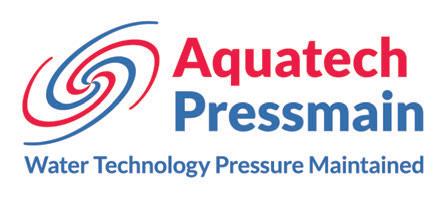
Manufacturing products in their Essex factory to ensure the water flows in hospitals, hotels, swimming baths, care homes, hairdressers, banks, palaces, universities, factories, farms, military sites, supermarkets, dentists, vets, o ices, apartments, and homes throughout the UK and abroad.
Well-known clients include: Carlsberg,
Harris Tweed and The University of Kent.
With over 100 loyal sta , it is still family run with family values and a reputation for carefully designed products and 24/7 support from highly trained, experienced Service Engineers, covering the whole of the UK from o ices in Glasgow, Manchester, Colchester and Southampton.
Looking to the future, there are many exciting new products in development for pressure boosting, pressurisation and fire sectors, together with new advanced intelligent controls packages, aimed at making Aquatech Pressmain the greenest, most e icient, and reliable on the market. Ensuring that Aquatech Pressmain will be leading driving product e iciency, helping the environment and reducing the industry’s carbon footprint.
SOLUTIONS FOR AFTER SALES
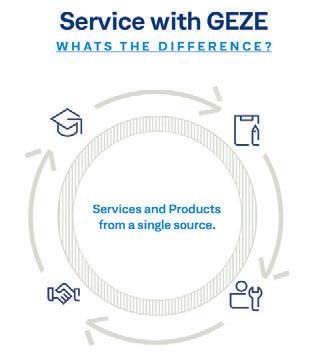


GEZE UK, the UK subsidiary of GEZE GmbH, a leading manufacturer of door and window control systems, has introduced the A er Sales Solutions brochure that details the a er sales services GEZE UK o ers for manual and automatic doors and windows.
The brochure explains the benefits of regular servicing – maintaining accessibility, minimising downtime, prolonging usability, reducing lifetime costs and fulfilling an organisation’s responsibility as a building owner or facilities manager. An automatic door is a piece of machinery and just like any other machinery it needs to be checked and maintained as it could become unreliable and potentially dangerous.
GEZE UK’s a er sales team can install, maintain, repair, provide asset management, spare parts and refurbish existing doors and provide a full range of

services for automatic doors, industrial doors and fire doors. The company o ers a 24 hour seven day a week reactive call out service throughout the year as well as Planned Preventative Maintenance packages designed to meet the needs the building and those using it.
The brochure is available digitally by visiting the company’s website or for a copy to be emailed, or for detailed information on the a er sales services available email info.uk@geze.com.
Adam Presdee, Service Director of GEZE UK, said: “GEZE UK o ers a complete ‘umbrella’ of a er sales solutions for all doors - automatic, manual and industrial. This brochure encompasses our approach whilst explaining the operational, commercial and environmental benefits of having a good maintenance regime and partner. We o er a service package that is tailored to each individual customer’s needs.”
www.geze.co.uk info.uk@geze.com
MONTH IN FM TO ADVERTISE IN MONTH IN FM PLEASE CONTACT DANNY.GRANGE@KPMMEDIA.CO.UK OR CALL 01322 476811 JUNE 2022 46
www.aquatechpressmain.co.uk web@aqpm.co.uk 01206 215121
T-FIT INSULATION TAKES MACKIE’S CLOSER TO ‘BRITAIN’S GREENEST BUSINESS’ GOAL

Premium ice cream brand Mackie’s of Scotland has taken another step towards its goal of becoming Britain’s greenest business by installing T-FIT® high-performance insulation on the family farm in Westertown, Aberdeenshire, where it produces over 13 million litres of ice cream annually.

T-FIT Process insulation, manufactured from closed cell, crosslinked nylon foam, has been fitted to interior and exterior pipework in the raw milk silos and glycol shed. As well as saving energy, a decisive factor in selecting T-FIT was its longer service life, which significantly exceeds that of the nitrile rubber insulation it replaced and is in keeping with Mackie’s philosophy of investing in sustainable solutions wherever possible.
Control means consistency
“Controlling temperatures during manufacturing is crucial for product consistency,” says Kevin Jepson, Mackie’s long-time Service Manager. “The process is tailored for each recipe to produce the best flavour, and temperature fluctuations can alter the final flavour. E ective insulation is especially important to help us reduce the amount of energy required to maintain the temperature of our pipes and to protect our product. The previous insulation made from nitrile rubber hardened and broke up a er about a year, meaning we would use more energy to maintain the temperature of the pipes — tears or missing chunks would appear which also posed a risk to the integrity of our product. If le , this deterioration could bring about issues with condensation, which could create a slip and trip hazard for sta .
“Installing T-FIT has a number of benefits. We eliminate the labour, time, and materials costs of replacing the nitrile rubber insulation each year. This also has a positive benefit for our green agenda,







helping us reduce landfill as we will no longer be stripping out and disposing of non-recyclable materials every year.
“Another big positive for us is that T-FIT Process is now manufactured in Poland; its carbon footprint is therefore lower than competitor materials that have to be shipped greater distances. The material is easier to fit and maintain and that it looks much better should also be taken into account!”
A high priority Energy e iciency is a high priority for Mackie’s, a fi h-generation family business, and an area in which the company has an enviable track record. It is almost 30 years since the company installed its first wind turbine. Today the company has four turbines, 7,000 solar panels and produces twice as much energy as it uses. Other measures taken by Mackie’s to improve its energy e iciency include installation of biomass boilers and a £4.5 million low-carbon refrigeration system which, once complete, is anticipated will reduce the dairy’s energy consumption by up to 70%.
Says Kevin: “Compared to other insulation technology, T-FIT lasts longer, needs less inspection and maintenance, and reduces energy consumption. It’s installation here is an excellent example of the steady incremental improvements that we believe
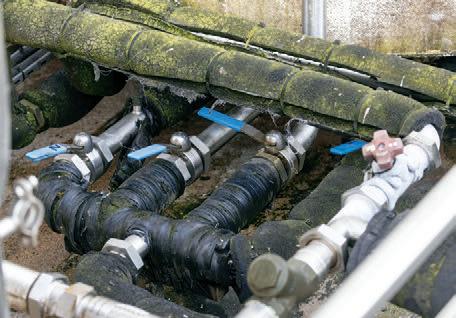
www.zotefoams.com
holistic approach to insulation. “How much e ective insulation costs is about more than just the ticket price,” he says. “A proper in-depth calculation must consider factors such as how long the insulation lasts — years, not months, in the case of T-FIT — whether it needs constant monitoring for degradation, the costs incurred by frequent replacement programmes and the ongoing impact that it will have on the environment. On all these counts T-FIT scores highly relative to traditional insulation.”
MONTH IN FM JUNE 2022 47 FMJ.CO.UK
will eventually make us Britain’s greenest business.” Mike Rust, Global Development Manager for T-FIT Insulation, says Mackie’s decision highlights the importance of manufacturers taking a more
SNICKERS LITEWORK 37.5® WORK SHORTS – FOR COOLING COMFORT THIS SUMMER
Lightweight Work Shortsdesigned to deliver superior comfort and freedom of movement. Great for summer working on site, these lightweight Work Shorts have a streetsmart fit with a cool working comfort in warm conditions. They’re made of quickdrying 37.5® technology fabric that delivers e icient moisture transport, ventilation and UPF40 sun protection in sunny weather.
They have a functional design and come with or without extra robust holster pockets. There’s also a 4-way stretch panel at the crotch and reinforcement at critical areas for extra durability. They’re packed with comfort and functionality and specially designed for the fast-paced professional who’s always on the go and always delivering top class work on site. For professionals who rely on their gear in demanding environments, they’re a must for everyone who wants the ultimate in cool comfort this summer.

www.snickersworkwear.co.uk sales@hultaforsgroup.co.uk 01484 854788
JANGRO’S NTRL RANGE RECEIVES VEGAN ACCREDITATION
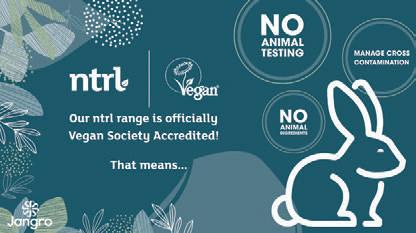
Jangro, the largest network of independent janitorial and cleaning distributors in the UK and Ireland, is delighted to announce that ntrl, its innovative range of natural cleaning products, is registered with The Vegan Society’s Vegan Trademark. An internationally recognised standard, The Vegan Society’s Vegan Trademark certifies that all products registered are free of all animal use, in ingredients and testing.
The ntrl portfolio comprises thirteen products ideal for cleaning surfaces in a variety of environments. All use raw materials that are derived from plant-based extracts. Their natural formulas are 100% biodegradable, contain zero petrochemicals, and can reduce the product’s carbon footprint by up to 85%. Products come superconcentrated too, giving more uses out of a single container.
The ntrl Washroom Cleaner and the ntrl Multi-Surface Cleaner also harness revolutionary, probiotic cleaning. Rather than killing germs with chemicals, probiotics use beneficial bacteria to colonise surfaces, in e ect taking over the area, including deep into hard-to-reach cracks and crevices.
The full range includes: Washroom & Toilet Cleaner; Foaming Washroom & Toilet Cleaner; Foam Hand Soap; Alcohol-Free Foam Hand Sanitiser; MultiSurface Cleaner; Washing Up Liquid; Cleaner & Degreaser; Surface Sanitisers; Organic Descaler; Kitchen Sanitiser; and an All-Surface Cleaner.
All packaging is recycled and recyclable. Produced to ISO 9001 and 14001 QMS standards, 100% of the range is made in the UK.
www.jangro.net/ntrl
www.vegansociety.com/the-vegan-trademark
NEW DEHUMIDIFIER WITH EXTERNAL CONDENSER
Condair is launching the Condair DC-N, a condensing dehumidifier with an external condenser unit that can dry an area without the risk of overheating. The Condair DC-N’s external condenser allows the heat generated during drying to be remotely exhausted, similar to a split air conditioner. This makes it much easier to manage the temperature of a room that is being dehumidified.
Dave Marshall-George, Sales Director at Condair commented: “Condensing dehumidifiers dry the air by creating a cold surface upon which moisture in the air condenses and drips to drain. This process generates heat, so the dry air leaving the dehumidifier can be several degrees warmer than the humid air entering it. For some projects, this added heat can cause an issue. When it is, ventilation is frequently used to control temperature. However, by introducing fresh air to control temperature, moisture can enter the room, making the humidity control less e ective.
“The Condair DC-N is the ideal solution in these circumstances. When the room is cold and below the required temperature, the dehumidifier’s on-board condenser introduces heat as well as drying the air. Then when the room’s temperature set point is reached, the remote condenser activates, ejecting the heat externally rather than into the room. This allows a room to remain sealed, therefore providing e icient drying, whilst achieving the ideal internal temperature and humidity.”


www.condair.co.uk
SAVE 10% ON TESTO 440 KITS AND TESTO 420 VOLUME FLOW HOOD
For a limited time only testo are o ering 10% o selected testo 440 kits and testo 420 volume flow hood, from your specialist dealer. O er ends 31.08.22.
Made for your job – the testo 440 complete kits
The testo 440 combines a compact hand-held measuring instrument with intuitive measurement menus and a comprehensive selection of air velocity & IAQ probes. Use it to keep all your air conditioning and ventilation measurements safely and reliably under control.
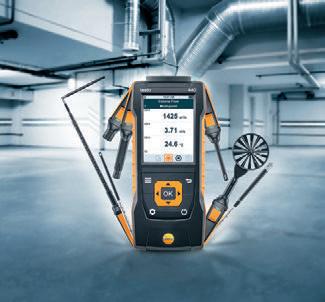
Ideal for:
• Adjusting air conditioning and ventilation systems • Checking flow in ducts and at outlets • Monitoring air quality • Measuring comfort
Discover the versatile testo 440 in practical complete kits now at: www.testo.com/en-UK/products/air-flowpromo-2022
The exceptionally lightweight testo 420 volume flow hood


The testo 420 is the lightest volume flow hood on the market, coming in at just 2.9kg. Light, precise and convenient: the testo 420 volume flow hood significantly facilitates volume flow measurement at larger air intakes and vents.
Benefits: • Ergonomic and lightweight (less than 2.9kg) • High-precision • E icient
• Convenient operation via the testo Smart App • Compatible measurement, documentation and sending reports with the testo 400
www.testo.com/en-UK/products/air-flow-promo-2022
www.testo.com/en-UK/products/volume-flow-hood

MONTH IN FM TO ADVERTISE IN MONTH IN FM PLEASE CONTACT
OR CALL 01322 476811 JUNE 2022 48
DANNY.GRANGE@KPMMEDIA.CO.UK
SUSTAINABILITY FROM THE GROUND UP
Lee Fox, Director of Global Business Development and Key Accounts for KleenTex, discusses how facilities managers can improve the environmental e iciency of their building by installing a dedicated combination of floor matting systems.

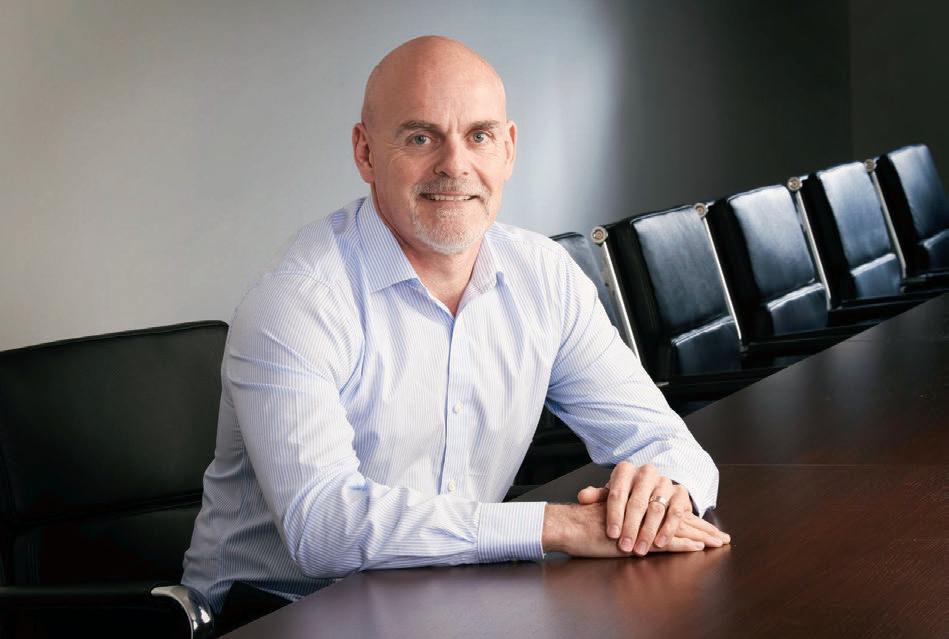



Over the last two years, the pandemic has had a significant impact on the sustainability of facilities’ operations due to the sharp uptake in single use cleaning and protective equipment.
Focusing on floor matting in particular, facilities are currently transitioning away from PVC manufactured products to high performance nylon ranges that o er improved dirt and moisture capture.
The Kleen-Tex Super-Mat heavy duty matting system features a 100% nitrile rubber backing and is constructed from 100% Econyl fibres, a regenerated nylon textile composed of man-made ocean and landfill waste, including abandoned fish nets. By installing PVC free flooring matting systems such as this, professionals can successfully increase the use of recycled materials throughout their building and evidence the sustainability of their procurement throughout the entire supply chain.
While procuring flooring matting systems manufactured from recycled materials will be a leading consideration for professionals, it is crucial that the products do not compromise the overall performance and lifecycle of the product.
However, it is the product’s e iciency with regard to its ongoing maintenance that o ers the most significant benefits. Achieving 37% faster drying times, when compared to standard cotton mats during laundry cycles, the matting system saves valuable energy, time and money throughout laundry sequences, while a five year manufacturer’s guarantee that facilities can easily meet increased levels of footfall without impacting on performance.
Professionals must also ensure they are considering each specific application throughout their building to ensure they install the correct matting system in the appropriate location.
Implementing successful specification
To successfully fulfil requirements for improved longevity and durability, adopt a long-term approach to procurement by specifying high performance systems that deliver increased functionality and resilience to eliminate the costly and ine icient requirement for repeat purchasing.
Products such as Kleen-Tex’s EcoAbsorb entrance matting system, which features 50% recycled nylon yarn that requires 47% less energy consumption throughout the production process, when compared to standard yarn. The mat also produces 35% less CO2 emissions throughout the manufacturing process, in addition to a 30% reduction in water.
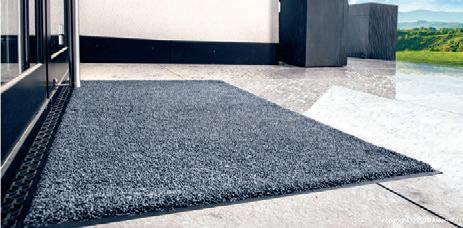
This application led approach to specification will aid the overall e iciency of the building’s operations by ensuring the correct product is installed in the right location to fulfil its purpose.
Focusing on the entrance of a building in particular, without an e ective matting system, 42% of a floor’s finish across the first 1.8 metres of the entrance can be worn away by just 1,500 people walking across it. This demonstrates the importance, particularly for high tra icked areas, to install and maintain dedicated floor matting systems that adequately capture moisture, dust and debris to prevent it from entering a building to not only achieve the highest levels of cleanliness and safety, but support a reduction in long-term
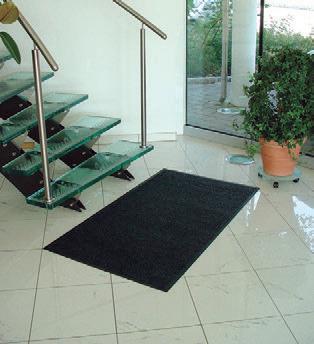
cleaning routines, facilitating a decrease in the level of chemicals required.
cleaning
The Kleen-Tex Green-Horse floor matting system o ers FMs a fully serviceable product that delivers shorter drying times and higher heat resistance. The PVC free construction also includes a pile manufactured from recycled PET bottles that delivers great dirt capture properties to successfully trap dirt and moisture to capture it before it has the opportunity to be tracked throughout a building.
With the 2050 deadline to meet the government’s net zero targets fast approaching, facilities can successfully improve the sustainability of their current and future operations by adopting a longterm approach to the specification and installation of environmentally e icient floor matting systems that increase durability and longevity and reducing cleaning requirements.”


MONTH IN FM JUNE 2022 49 FMJ.CO.UK
www.kleen-tex.co.uk 01204 705070
SUCCESS TASTES SWEET AS UK SEWER CLEANING LEADER LANES MARKS 30TH ANNIVERSARY
Lanes Group plc Chief Executive Wayne Earnshaw has marked the 30th anniversary of the company his father founded by making the first cut in a cake shaped like a jet vac tanker at the company's Greater Manchester HQ.
The UK's largest independent drainage and wastewater specialist operates hundreds of the specialist vehicles that can clean sewers and suck up waste for safe disposal.
So it was perfectly apt that the cake baked to mark the 30th anniversary looked like a mini version of the eye-catching pink and white tanker lorries that have become an increasingly common sight on roads across the UK.
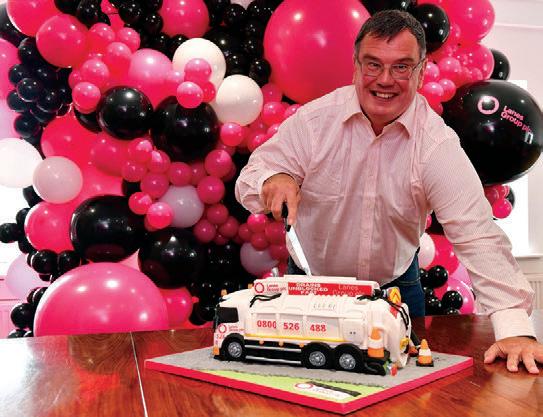
Slices of the chocolate cake - made by East Lancashire professional baker Molly Robbins, former star of Channel 4's Extreme Cake Makerslater made tasty treats for colleagues at the Lanes Manchester depot and HQ o ices.
Wayne Earnshaw said: "We're proud of what Lanes has achieved over the last three decades, delivering drainage services on behalf of many water companies, tens of thousands of businesses and
millions of people.
"Over the years, those services have been delivered by many thousands of dedicated and highly professional people, including our current teams. So we will be celebrating their contributions over the rest
www.lanesfordrains.co.uk
of 2022."
Wayne Earnshaw's father, Allan Earnshaw, and Graham Tattershall triggered the company's rapid development when they bought Lanes for Drains from its founder, John Lane, on 21st April 1992.
What began as drainage company with one depot in Leeds, West Yorkshire, has since grown rapidly to operate more than 35 service depots and utility hubs, and a turnover of over £300 million.
Lanes is now one of the UK's largest wastewater maintenance service providers.
Clients include Thames Water, Severn Trent, Yorkshire Water, Scottish Water, Dwr Cymru Welsh Water, and Northumbrian Water.
In 2020, the company launched its latest business venture, setting up Lanes Infrastructure to deliver excavation and ducting installation services for the broadband industry.
The Lanes-i launch has been a big success, with the business building a rapidly growing portfolio of contracts, aided by an innovative business model that combines digital operational systems with industryleading safety and quality standards.
SIGNAGE MADE SIMPLE WITH DURAFRAME
Good signage is important to us all, to point us in the right direction, highlight hazards, or communicate useful information. Finding a solution that is cost-e ective, easy to install, and economically friendly can be tricky, but it doesn’t have to be.
DURAFRAME® is an innovative and easy-to-use signage solution, designed to present information clearly and professionally. The front cover protects the loose sheets inside, so they remain looking professional during use.
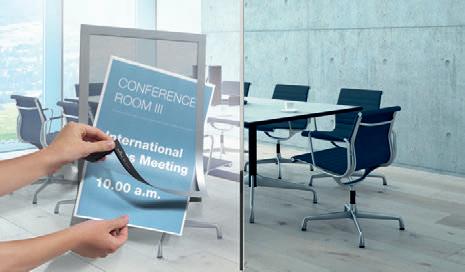
In just a matter of seconds, you can install a professional signage solution that not only looks great but is also user-friendly.
DURAFRAME® features a magnetic panel that can be li ed away from the frame which means that


information can be quickly and easily inserted and replaced. This is ideal in an era where information changes rapidly.
Self-adhesive, magnetic, self-cling and hook and loop attachment options are available to attach the frame to any surface including windows, walls, and machines so there is no need for expensive tools or installation fees.
When applied to glass, the self-adhesive info frame can be read from both sides – and even better it can be repositioned and reused. The magnetic frame can also be placed and repositioned on any metal surface, providing a cost-e ective and economically friendly longterm solution.

DURAFRAME® is extremely versatile and can be used to communicate hundreds of messages including building signage, telephone lists, directions, warning information and maintenance lists.
The frames are available in a variety of sizes and colours to suit all applications and can even be custom-made to include your branding.
See how easy it is for yourself! Request your free sample – www.duraframesample.com
www.duraframesample.com

MONTH IN FM TO ADVERTISE IN MONTH IN FM PLEASE CONTACT DANNY.GRANGE@KPMMEDIA.CO.UK OR CALL 01322 476811 JUNE 2022 50
Happy 30th Anniversary - Lanes Group Chief Executive Wayne Earnshaw cuts jet vac tanker cake at Manchester HQ
UNPARALLELED AIR FRESHNESS FROM OXY-GEN POWERED DEBUTS AT INTERCLEAN AMSTERDAM 2022

At an exclusive launch held at the Interclean Amsterdam 2022, Fragrance Delivery Technologies Ltd (FDT), unveiled their latest innovation in the Oxy-Gen Powered range, the Oxygen-Supreme Air Freshness System. OxygenSupreme’s revolutionary technology and futuristic design deliver an unparalleled Air Freshness experience with continuous fragrancing and odour control.
Oxygen-Supreme is the future of Air Fresheners with its consistent, reliable and e icient odour elimination technology. The exclusive, high impact, designer fragrances elevate user experience, whether it’s a washroom, o ice space, reception lobby, conference room, or any away-fromhome facility.
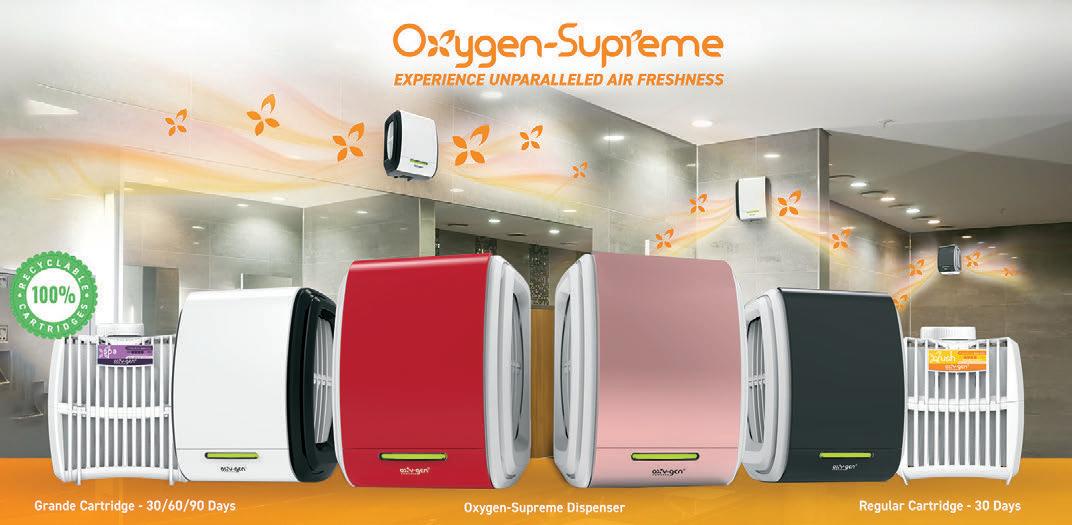
Oxygen-Supreme’s patented technology is based on proven, pharmaceutical grade fuel cell technology which was initially developed to administer precise doses of medicinal fluids to treat human beings and animals. This technology guarantees that the Oxygen-Supreme system delivers a continuous and consistent level of fragrance throughout the chosen cartridge life of 30, 60 or 90 days.
Hydros Jassem, CEO, FDT, said: “In the hygiene industry, where product innovations are few and far between, FDT is one of the few companies which has continuously invested in innovation and technology. In the past 15 years, where others have failed with their products or have withdrawn their products from the market, FDT has successfully launched several new and innovative products in the Oxy-Gen Powered range that are now sold and used in over 72 countries. Since metered aerosols, there hasn’t been another reliable air care solution in the market that has delivered its promise. We are very excited to introduce Oxygen-Supreme, which is the ultimate combination of design, function and value. It not only e ectively gets rid of unavoidable odours, but does it in style, improving the perception of your facility and creating a pleasant welcoming environment.”
Key features of the Oxygen-Supreme include: Guarantees consistent and continuous fragrance levels for the chosen cycle of 30, 60 or 90 days
E ective malodour elimination with proprietary odour counteractant, Neutra-lox Eco-Friendly and Safe Boosted Airflow to deliver more fragrance
Clear LED light indicators provide cartridge and battery replacement reminders
The dispenser has options of a simple push button opening or a lockable front cover Fragrances are compliant with CARB, EU, IFRA and REACH regulations among others
The new, modular design o ers simple customisation – allowing you to create an exclusive dispenser for your own brand
Available in a range of colours and striking finishes with new two tone and up to four colours on a single dispenser if required for any customisation
12 fantastic, fresh fragrance options in a range of intensities
elimination but with low or no fragrance. A choice of two new cartridges is available, Neutra-lox Super and Kleer Natural, which are ideal for areas where low or no fragrance is desired.
Hydros Jassem added: “With the safety and wellbeing of users and service personnel being of the utmost importance, we ensure that our products are free of potentially harmful propellants, solvents, alcohols, CFCs or any added VOCs. Unlike aerosols, Oxy-Gen Powered cartridges, are not pressurised cans and do not require any special permits to store or waste-carrier licenses to transport or dispose of them. Oxy-Gen Powered cartridges are safe to recycle at the end of the cartridge life.”
The stylish, modern and functional design of the Oxygen-Supreme, makes it the ideal odour control and fragrancing solution for facilities looking for an eco-friendly system that is e ective, reliable and safe.
About Fragrance Delivery Technologies
Unlike other systems that only mask odours, all Oxy-Gen Powered fragrances contain Neutra-lox, a proprietary malodour eliminator which neutralises the odour-causing molecules continuously, leaving fresh fragrance in the air. It is extremely e ective against the smell of urine, faeces, body odour, tobacco, pet malodour, kitchen odour, mould, mildew, etc.
Facilities such as hospitals, clinics, care homes etc, face a unique challenge, as they require high odour
FDT, headquartered in Dubai is world-renowned for their patented, innovative Oxy-Gen Powered odour eliminator and continuous air freshening systems. Oxy-Gen Powered products are manufactured in Dubai and the award-winning products are found in 72 countries across the world in six continents. www.oxygenpowered.com communications@oxygenpowered.com
MONTH IN FM JUNE 2022 51 FMJ.CO.UK
CLIENTS ARE VERY PLEASED WITH THE WATER AND ENERGY SAVINGS WE HAVE ACHIEVED FOR THEM’
‘Our clients are very pleased with the water and energy savings we have achieved for them’ is what we hear on a regular basis from the companies we work with.

Waterblade makes a perfect additional service you can provide for your client, especially if you are responsible for their washrooms. O en that means you are a facilities manager but now we are also working with a growing number of other companies who work in and in connection with wash rooms.
We believe Waterblade provides the best handwashing with the lowest flow. The Water and Water-heating savings are significant and it pays for its self in under six months.

We now have a dedicated service that is designed to support you in introducing Waterblade and the water and energy savings it produces to your clients. It is easy to try one out for your own project or building.

Simply request a free sample, fit it in minutes confirming compatibility and functionality.
You can then show it to stakeholders and verify the savings of a whole building rollout.
www.thewaterblade.com nigel@thewaterblade.com
SNICKERS WORKWEAR – SUSTAINABLE HI-VIS PROTECTIVE WEAR
Class 1 and 2 Hi-Vis Stretch Work Trousers with Sorona® sustainable performance fibres.
Whether its dusk, dawn or dark, Snickers Workwear has a superior range of Hi-Vis protective wear for both men and women to ensure comfort, safety and certified protection.
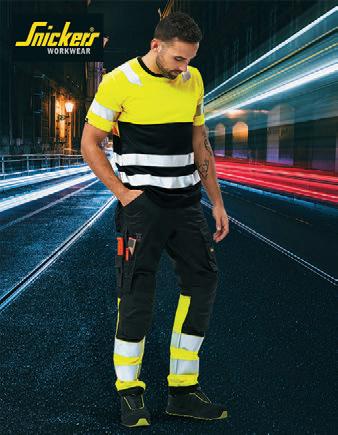
The latest additions to the Hi-Vis range are the new Stretch Work Trousers made from the innovative Sorona® sustainable performance fibre.
Sorona® delivers both environmental benefits and great performance. This recyclable, bio-based fibre o ers exceptional so ness for maximum comfort as well as excellent durability to help extend the lifetime of a garment.
The new Hi-Vis Work Trousers with Sorona® also o er long-lasting elasticity for ease of movement. Sorona® is also quick-drying, breathable and so to the touch for optimal comfort and workday performance.
With advanced designs, high-tech fabrics and performance reflection features, all Snickers Workwear Hi-Vis protective wear has durable colour-fast protection that will last through wash a er wash, retaining shape, comfort and protection levels throughout the life of the garments. Added to which, Snickers Workwear High-Vis garments can be custom-profiled to ensure 'stand out' coverage for your corporate brand.
KINGSPAN KOOLDUCT PROVIDES LONG-TERM AIR CARE
Over 15 years a er it was first installed, The Kingspan KoolDuct System continues to support excellent HVAC system performance as part of the Sterile Services Unit (SSU) for the Hull University Teaching Hospitals NHS Trust.
The Kingspan KoolDuct System was used to fabricate over 1,400 m2 of supply and extract air ducts to and from the HVAC air handling units. The system comprises foil-faced rigid insulation panels which can be used to fabricate lightweight runs of ductwork.

A recent inspection of the HVAC system showed that the ductwork is in excellent condition, with all joints and junctions continuing to provide an e ective barrier against air loss.
Cleanliness is clearly a key priority at the facility, and this includes maintaining a high standard of indoor air quality. Internal assessment of the ductwork showed that, thanks to a regular inspection and cleaning schedule operated by the NHS estates o ice, the ductwork remains clean and free from debris.

The only significant change since the original installation was a new section of ductwork, which had been added to replace a section that had su ered accidental damage.
To support whole life assessments of ventilation systems, an Environmental Product Declaration (EPD) has been created for The Kingspan KoolDuct System.


www.kingspanductwork.co.uk info@kingspaninsulation.co.uk 01457 890 400
NEW SERVICE ENGINEER AT CONDAIR
Humidity and evaporative cooling specialist Condair, has employed Paul Threlfell, as a service engineer covering Scotland and the North of England. Paul is F-Gas and IOSSH accredited and has over 25 years’ experience in the HVAC industry, having worked for companies such as Hussmann Refrigeration, City Refrigeration, Russell Air Conditioning, Scotia Energy Saving Systems/ID Scotia and Linaker.
Tony Tullett, Service Director at Condair, commented: “I’m very happy to have Paul join the Condair Service Team. Being based in Edinburgh, he is perfectly positioned to support our customers across Scotland. Paul is a very experienced engineer in our sector and has dealt with many di erent types of HVAC system. His F-Gas accreditation is a great benefit, as we service not only humidifiers but also refrigerant-based dehumidifiers, so he can really hit the ground running. In fact, we’ve already had some lovely positive feedback from customers he’s visited, so we are sure Paul will be an invaluable asset to our team.”
Condair’s service department provides the manufacturer’s engineering expertise on-site, supporting the complete range of Condair humidifiers and dehumidifiers, as well as many other humidification systems. Condair has the largest specialist humidity control engineering team in the UK, with 21 engineers strategically located across the UK and Ireland to provide nationwide coverage.
sales@hultaforsgroup.co.uk 01484 854788
www.snickersworkwear.co.uk

www.condair.co.uk

MONTH IN FM TO ADVERTISE IN MONTH IN FM PLEASE CONTACT
OR CALL 01322 476811 JUNE 2022 52
DANNY.GRANGE@KPMMEDIA.CO.UK
'OUR
GOING WATERLESS COULD CUT FM SECTOR URINAL RUNNING COSTS BY MORE THAN HALF AT THE SAME TIME AS SLASHING CO2
Facilities managers and businesses could slash CO2 footprints and save over £1,200 on every three urinals on their books, if they switched to waterless technology. The findings released by Smarti Environmental, the UK’s leading waterless urinal business, to coincide with Water Saving Week 2022.
The savings are possible with the installation of Smarti Environmental’s newly launched ecofriendly Vortex triple seal valve (TSV), which has been designed to cut urinal water bills by over half, at the same time as dramatically lowering carbon footprints, eliminating bad urinal smells, blockages and eradicating the spread of infections caused by flushing urinals.
The smart-tech, eco-friendly, retro-fit Vortex valve ends the need for water in urinals, saving on average 100,000 litres of clean water and 105kg CO2 per urinal, per year. It also prevents airborne infections caused by spray during flushing, which has been shown to spread 500,000 germs per inch, per flush, landing
on skin, surfaces and clothing, spreading viruses including COVID-19, influenza and norovirus.
The Vortex TSV, which fits 98% of all urinals, enables businesses to retain their existing urinal bowls while cutting annual running costs by over 50%, compared to conventional water-flush alternatives.




Confirmed as the fastest flowing waterless urinal
solution on the market, the fully recyclable, British-manufactured, hygienic one-way multi valve system, traps all odours so that the foul drain smells become a thing of the past. No other waterless urinal technology is as e ective.
The Vortex valve accelerates the flow of urine down into the drainpipe, and includes an ecofriendly bio-block enzyme ring and integrated bio-tablet that breaks down uric acid and bio film proteins, and makes urine PH neutral – a world first!. This prevents costly and damaging back-fill flooding and blocked pipes.
Visit https://smartilimited.com or call 01392 311 202 for a no obligation washroom survey and quote.

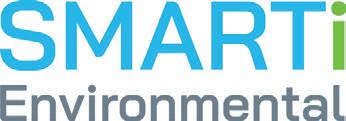


https://smartilimited.com 01392 311 202
HOT-DESKING JUST GOT A LOT MORE PLEASANT WITH KLEEO, EVOKO’S NEW DESK BOOKER

Swedish company Evoko announces its newest product of their smart workplace solutions, Kleeo desk manager. Kleeo is a desk booking product, solving one of the longstanding problems of o ice spaces in the new normal— finding the perfect desk no matter the day or time or how o en you frequent the o ice. By making the desk booking experience flexible and frictionless for employees, working from the o ice can be finally uncomplicated, productive, and a much more pleasant experience.
Kleeo is designed and engineered to be more “human” compared to other players in the market— a user experience-driven solution that is simple, e ortless, and non-intrusive for the daily user to alleviate the stress many employees feel from not having an assigned desk, while at the same time helping optimise and streamline the o ice environment.
Key selling points:
Premium hardware & so ware solution; Users can interact with Kleeo directly on the device’s interface
or via an app. The physical device is designed to create a minimum distraction with easily identifiable desk status via four di erent status light colors; it has a built-in presence sensor; is easily repairable and recyclable; has low maintenance and a long service plan; and integrates seamlessly with Evoko’s Workplace platform and apps.
Superior user experience; Users get easy booking options without restrictions with functions such as “focus mode” and “automatic check-in”, upgradeable so ware with new features for even more flexibility, and peace of mind for workers and employers. Kleeo is easily integrated and a natural part of the users’
workplace routines, the experience can start already outside of the o ice with the intuitive app.

Ethical, responsible (anonymous) data analysis; Employers can better understand how their space is being used, which desks are preferred, when are o ice desks limited, and which days are best for working from home to optimize the o ice space from both a satisfaction and cost perspective, as this is one of the major costs for many organisations.
In the development of Kleeo, Evoko teamed up with the Swedish product innovation agency, Above who work with Google, IKEA and Bang & Olufsen among others.
Evoko is now available for purchase in the US and EU via selected resellers.

For purchases in the UK please visit the Anders + Kern website. www.anders-kern.co.uk/workspace-hardware/kleeo-desk-manager

MONTH IN FM JUNE 2022 53 FMJ.CO.UK
Why make the switch to waterless urinals? MAKE THE SMARTi CHOICE – GO WATERLESS SMARTi ENVIRONMENTAL WATERLESS URINALS FLUSHING URINALS WATERLESS URINALS 100,000 litres of water wasted per urinal, per year Harsh chemicals and cleaners required No foul urinal smells 98% reduction in virus and bacteria spread No water and no blockages Flushing generates 500,000 airborne germs per inch, per flush 105kg CO₂ per urinal, per year Environment friendly enzyme tech suppresses bacteria and makes urine PH neutral 105kg CO₂ saving per urinal, per year 50%+ reduction in running costs Fully recyclable one-way multi-valve Foul smell from open pipes Costly pipe blockages causes flooding
BUILDING A GREENER FLEET: OUTCO SIGNS DEAL WITH VOLKSWAGEN FOR NEW SURFACING, INFRASTRUCTURE & GROUNDS MAINTENANCE VEHICLES
Outdoor compliance expert OUTCO has signed a two-year deal with Volkswagen Financial Services Rent-A-Car, helping the company modernise its fleet and reduce emissions with new vehicles that feature e icient and Euro 6 compliant engines. The leasing deal has replaced an older fleet of owned and hired vehicles with 16 vehicles for OUTCO’s Surfacing & Infrastructure division and provides 28 Volkswagen panel vans for its Grounds Maintenance division. A further 30 Volkswagen panel vans are also on order and are waiting to come o the production line.
The arrangement also paves the way for the future introduction of hybrid and electric vehicles as and when more suitable models become available given the current challenges of market availability.
OUTCO are also working with Volkswagen to supply its sta with the option to personally hire electric and hybrid cars as part of the Volkswagen Infinity Scheme at discounted rates. The scheme is to help employees who do not want to commit to
Raj Kanda Group Fleet and Asset Manager OUTCO (le ) and Nikki Ettwell, General Manager, Sales and Rental Location Operations, VWFS- Rent-a-Car
long term leases and have the flexibility to return the vehicle as when required.
Operating nationwide, OUTCO’s Surfacing and Infrastructure division provides a complete car park refurbishment, construction and maintenance
www.outco.co.uk

service, as well as civil engineering, drainage, line marking, specialist coatings and surveying services. Hence, its vehicles need to be robust and reliable but must also support the forward-thinking company’s drive towards greater sustainability.
For the Surfacing & Infrastructure division, the deal with Volkswagen Financial Services Rent-A-Car includes the supply of 16 vehicles, including twelve Cra er Doublecab Dropsides, one welfare vehicle, two Transporter vans for the drainage business team and a Caddy van to be used as a site manager’s vehicle.

The deal is part of OUTCO’s ongoing drive to operate with an e icient and up to date fleet. The recent VW deal follows a renewal of over 100 gritting vehicles for OUTCO’s Winter Services division vehicles over the previous year with other vehicle brands. The major investment to keep the company’s nationwide fleet of around 500 vehicles in optimal condition reflects OUTCO’s commitment to reliable and dependable service – especially when operating in safety and mission-critical contexts.
ISS SUPPORTS OFFICIAL PLATINUM JUBILEE PAGEANT COMMEMORATIVE ALBUM
ISS is a proud contributor to an o icial book marking Queen Elizabeth II’s Platinum Jubilee Pageant. Her Majesty The Queen: The O icial Platinum Jubilee Pageant Commemorative Album. The publication, launching 5 June 2022, celebrates The Queen’s extraordinary 70-year reign.

Providing a unique window into Her Majesty’s decades of service, and one of the most extraordinary lives of this or any other era, the book also features a select number of outstanding individuals and organisations from across the United Kingdom and the Commonwealth.
ISS has contributed an article showcasing the importance of frontline placemakers and the di erence they make to hundreds of organisations across the UK. The piece also introduces JointForces@ISS — ISS’s programme supporting ex-military personnel, service leavers and spouses in securing civilian employment — and explores how
recruiting from such an exciting and untapped talent pool can yield great results for businesses, whilst also giving something back to people and families who have done so much for society.
Published by St James’s House and written by leading royal commentators Robert Jobson and Katie
www.issworld.com
Nicholl, with contributions by Tom Parker Bowles, the hardback publication will be o icially launched at Claridge’s and unveiled on The Mall in central London during the Pageant.
Raymond Cooksley, British Army veteran and current programme lead for JointForces@ISS, will attend the book’s o icial gala launch on 5 June at Claridge’s hotel in Mayfair.
Liz Benison, CEO for ISS UK and Ireland, said: “ISS is extremely proud to sponsor this impressive publication. The book is a fantastic tribute to The Queen and a great celebration of many outstanding individuals and organisations. We are delighted to have been able to contribute and showcase our brilliant placemakers and JointForces@ISS programme; it has been a real honour.”
MONTH IN FM TO ADVERTISE IN MONTH IN FM PLEASE CONTACT DANNY.GRANGE@KPMMEDIA.CO.UK OR CALL 01322 476811 JUNE 2022 54
CHIEF CLIMATE AND SUSTAINABILITY ADVISOR APPOINTMENT AT COMPASS

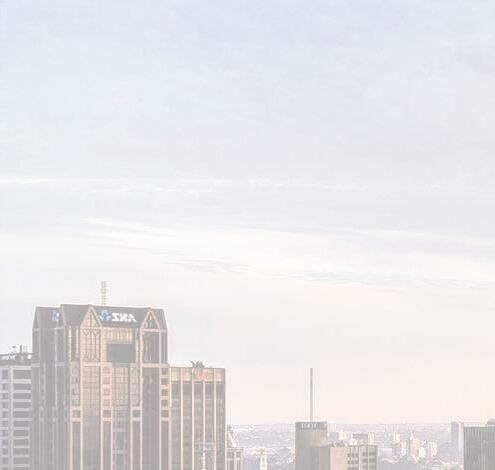



Leading University of Oxford expert, Professor Sir Charles Godfray FRS, has been appointed by Compass Group UK & Ireland as Chief Climate and Sustainability Advisor to its Executive Team.

The role will see Professor Godfray support the clients of Compass by primarily shaping and delivering the organisation’s industry leading commitment of reaching Climate Net Zero by 2030.


Professor Godfray is a population biologist. He has spent his career at Oxford and Imperial College and is currently Director of the Oxford Martin School and Professor of Population Biology at Oxford. Professor Godfray is particularly focussed on food security, formerly Chair of Defra’s Science Advisory Council and he is an ongoing Trustee of the UK Centre for Ecology & Hydrology. He is Co-Director of the Livestock, Environment and People project at the University of Oxford that included an ecolabelling pilot, which Compass supported across its business.
DIRECTOR APPOINTMENT AT ECOSERV


Ecoserv Group has appointed Natalie Coleman as Sales Director as part of its ambitious plans to expand the size and scope of the business.
Coleman, who has more than 20 years of experience in facilities management, will lead the company’s business development team, bringing extensive so services and specialist cleaning expertise to the role.
Coleman has worked for some of the largest names within the marketplace including Mitie, Interserve and Initial Facilities. Most recently she was Retention and Strategic Partnerships Manager at TC Facilities Management, and before this, a Director of Future Hygiene Services, with particular focus in the specialist data centre industry.
NEW MD FOR ISS UK & IRELAND’S EDUCATION BUSINESS

Alistair Dale has been appointed as the Managing Director for ISS’ Education business.
ISS Education is a £60 million business that provides facility services to higher and further education establishments and catering services to circa 450 primary and 50 secondary schools across England, serving approximately 100,000 meals every day.
Dale has worked for ISS for over 28 years, most recently as Finance Director and interim Managing Director for ISS’s Government business. During his tenure at ISS, he has predominantly worked within the Healthcare and Defence segments, but also notably managed the acquisition of Caterhouse Ltd. (the Education catering business into ISS) in 2007.
In the past eight months, Dale has led the ISS Government business and was instrumental in the recent contract extension with the Government Property Agency.


FACILITIES MANAGEMENT JOURNAL JOBS
www.buildrec.com info@buildrec.com Ifyouarelookingtogrowyourfacilitiesteamacrosssoftservices,engineeringorfacilities management,ourFMrecruitmentteamhavearapidlyexpandingnetworkofjobseekersavailablefor temporary,permanentorcontractvacancies. YOURFACILITIESSECTOR RECRUITMENTPARTNER Formoreinformationabouthowwecanhelpyourorganisation,pleasevisitbuildrec.comorcontactthe FacilitiesManagementteamon02031764793 TOTALFACILITIESMANAGEMENT|ENGINEERI NG|MAINTENANCE Weunderstandtheimportanceoffacilitiesmanagementandthosethatworkwithin it.That’swhyweplacesuchemphasisonconnectingleadingFMprofessionalswith topemployers. JUNE 2022 55 FMJ.CO.UK FM CAREERS - PEOPLE
RULES OF ENGAGEMENT
Post-pandemic, a lot of people were relieved to get back to a physical workplace. Vast numbers of FM employees, clearly, could not deliver services without attending premises in person. Many others, however, with more administrative roles, are reluctant to leave the virtual o ice.
Research by Microso in conjunction with YouGov, conducted at the end of 2021, revealed that 51 per cent of UK workers would consider leaving their company if hybrid working was removed, while 59 per cent of HR decision makers agreed that hybrid working has had a positive e ect on the mental wellbeing of sta . Hybrid working has evidently become less of a ‘nice to have’ and more of a ‘must have’.
The YouGov research also revealed that more than a third of workers who started a new job during the pandemic had never set foot in the workplace. They have not met managers or colleagues in person and may have struggled to absorb their employer’s workplace culture. Ensuring that more recent starters and their longer serving colleagues feel like an integrated team, and enjoy a level playing field, can be quite a challenge.
For many organisations, an e ective hybrid work

strategy is now a necessity, but making that strategy feel equitable is also vital. Increasingly, we are being asked to gauge what employees want from hybrid working and how they feel it should be managed.
Active communication with your team about hybrid working is key. This includes gaining quantifiable feedback. Employees who feel listened to and consulted are invariably more engaged than those who don’t.

TAKING THE PULSE
Salary: £35000
Location: West Midlands https://bit.ly/3m4ajn3
WORKPLACE
Salary: £55k -
Location: Manchester https://bit.ly/3x310u3 FACILITIES
Salary:
Location: London https://bit.ly/3t9bmWS
One of the most useful tools is the tailored employee engagement ‘pulse survey’. The pulse survey is run at regular intervals, asking a few key questions, in the form of an anonymous online survey which takes just a few minutes to complete.
There are some o the shelf solutions, but these will inevitably contain some irrelevant or inappropriately phrased questions for your organisation and, as a result, usually produce poor results.
The best way to identify the right questions for a tailored survey is to ask the prospective respondents. Far too o en, managers think that they know what the issues are, but their assumptions may not reflect the true picture. Talking in confidence to small focus groups, or individuals, depending on the size and structure of the organisation, is highly revealing. People are usually very happy to tell us (rather than their manager) what they think and feel;
even though they can’t quantify how widespread their issue or opinion may be. This vital intelligence helps us to cra the survey. In our experience, a well-tailored survey, based on issues relevant to your team, will yield response rates of around 84 per cent, which provides excellent quantitative data on which to base critical decisions and form plans.
CONSULTATION
Prior consultation also serves another essential purpose, signalling that the results will be noted and acted on. We encourage employers to invest resources in positioning an engagement survey in advance, to assure employees that its findings will result in progress. Every level of the organisation should be surveyed, from front line operatives to middle managers and senior executives. Naturally, this may mean that the survey needs to be tailored di erently for the various groups so that opinions on issues such as hybrid working, diversity, inclusion and another current hot topic, allyship, can be measured in the di erent strata of the organisation.
Using a pulse survey is more reliable than ‘always on’ surveys, which are o ered by some engagement analysts. Always on surveys tend to be popular with some sections of a workforce, but fail to provide rich data from across the whole organisation. Measuring engagement at set intervals in a pulse survey also helps to avoid ‘blips’ from employees who turn to the always on survey as a form of complaint, following a particular workplace experience. The pulse survey can be run every month, quarter, or other predetermined intervals, depending on the issues under examination. Regular feedback from your key stakeholders allows you to monitor progress, check against KPIs and understand what’s working and what needs to be tweaked. We can adapt the survey questions as you make progress or dig deeper into particular issues.
Tailoring your survey does mean that every question must be apt and relevant, but not necessarily that the wording is exclusive to your organisation. We have access to some industry-wide data, so you may wish to benchmark your teams against this, by asking the same question that others have asked.
Accurate findings from plentiful survey data will o en go a long way to explain why you are losing (or retaining) sta and how you might achieve greater engagement and loyalty.
FACILITIES MANAGEMENT JOURNAL JOBS
Hybrid working is now the norm in many workplaces and is highly valued by a wide range of employees. Gary Cattermole, Director of The Survey Initiative, looks at how to measure whether you’re delivering a workplace that employees feel engaged with and loyal to, even when not on the premises LATEST JOBS ON FMJ
AND MAINTENANCE MANAGER
FACILITIES
-
per annum +
£40000
INNOVATION MANAGER
per year +
60k
MANAGER
£25 - 28 per hour
jobs.fmj.co.uk Over 250 jobs live on site FM CAREERS - RECRUITMENT JUNE 2022 56
OPEN COACHING
Gender di erences - How you deploy coaching for di erent genders should be considered wisely, as should how you communicate the expected benefits. Subtle di erences in approach can determine how someone uses the opportunity and whether it sees them remain in your business or leverage an exit.
Uptake and engagement issues
- Communicating the value of coaching, its availability, and its continued use were cited as key challenges for businesses. This has a lot to do with internal communications challenges inside major enterprise businesses.
Funding matters - Our research among employers certainly shows that funding of coaching is the barrier to a broader reach. Cracking the finance challenge is the major hurdle initially, but by working with a provider that gives you both the flexibility and scalability of payment models and program design, will go a long way to helping your roll out to all employees.
The turbulence of the talent market dubbed ‘The Great Resignation’ continues and has created a hyper-competitive job market. Job postings outweigh the number of job seekers, and attrition continues to be the statistic of concern. Employers need to change the approach to talent radically and quickly, to retain existing sta , nurture skills and development and open up mobility inside the business. To go from ‘The Great Resignation’ to ‘The Great Retention’, if you will.
Until now, coaching has been reserved in many organisations for current or future leaders, or to develop specific skills for promotion. It's not been explicitly linked to retention, development, engagement, or career mobility objectives across all employees. But coaching can be the enabler of the conversations that inspire and support the ongoing development, satisfaction, engagement, and performance of individual employees' careers in all facets.
We wanted to explore if coaching, when o ered to all employees (not just high-performers and execs), could help e ect important business goals and create a redefinition of work for employees. We surveyed employers and employees at the start of this year on
their views around coaching, specifically coaching that is ‘democratised’ for all employees, and combined it with the observations drawn from our experience in helping businesses worldwide with workforce matters.
COACHING TO HELP COMBAT ATTRITION

The right coaching solution not only empowers an organisation's employees to consider staying, but it enables employers to proactively a ect an array of other workforce deliverables such as career development, talent mobility, onboarding e ectiveness, and supporting a more inclusive workplace.

Employees we surveyed who are already engaging with coaching appreciate the opportunity, view it as valuable, and hope to continue receiving it. Even those not currently engaged with a coaching program clearly want to receive it - 90 per cent say they would engage with an employer’s coaching program if o ered the opportunity to do so. And expectations are running high; three-quarters (75 per cent) of those without a coach, would expect to find it a very or extremely valuable experience if they did.
Previously, it has been about coaches working with select high-performer
individuals and executives, helping them develop, but it is cost-prohibitive for it to be rolled out beyond specific groups deemed worthy of investment.
CHALLENGES TO DEMOCRATISING COACHING
From our research, we have been able to identify there are seven challenges to the wider adoption of coaching. All of them are solvable but need to be acknowledged first before being remedied.
Perceptions of privilegeEmployees are unaware of what is available to them and view it as being typically limited to the cliques of future. Unfortunately, this lack of inclusivity leaves others feeling le out.
Generational distinctions - There is enthusiasm for employer-sponsored coaching among Generation Z (48 per cent of respondents), Young Millennials (41 per cent), and Older Millennials (50 per cent), but this enthusiasm drops o among Generation X (38 per cent) and Baby Boomers (35 per cent). Knowing that the various generations have di ering attitudes towards coaching is incredibly important, as is knowing what triggers your audience to engage in coaching.
Establishing a clear return on investment - The biggest measure is the crossover benefit of increased employee confidence. Then, more subtly, it is increased employee engagement and commitment, and a desire to grow to be a good manager or leader within the organisation.
Resourcing variables - Direct managers coaching teams was voted by employees in our report as the top reason for not using the coaching o ered by an employer. Certified external coaching was clearly more appealing and was also rated as giving the highest performance too.
MOVING FORWARDS
The recommendations we make in our report give guidance on the direction to take. Employers should deliver coaching via external coaches at no cost to the employee. Coaching should be led by an employee’s needs rather than those imposed by HR. However, it should have some crossover to support those big-ticket items for the business to get its initial buy-in.
The democratisation of coaching is not only essential but eminently achievable for businesses. Only by aligning the true value of coaching with business goals can organisations begin to unleash worklife possibilities for all employees and move forwards and out of this turbulence.
FM CAREERS - TRAINING JUNE 2022 57
FACILITIES MANAGEMENT JOURNAL JOBS
Simon
Lyle, Managing Director of Randstad RiseSmart UK on how employers can move from the great resignation to the great retention by expanding coaching opportunities beyond the exec level
Mears Group named as one of 2022’s Best Companies to work for

Mears Group, one of the UK’s leading housing solutions providers to both the public and private sector, has been o icially named as one of the UK’s Best Companies to Work For in 2022. The organisation which employs more than 5,500 sta , has been recognised as for its commitment to workplace excellence with a place on the coveted league table of the ‘Best Big Companies to Work for in Q2 of 2022’ – together with the accolade of coming first as Best Company in Northern Ireland.
The o icial League Table was unveiled during a live event broadcast from Media City in Salford, Manchester.
Employers are relying on contractors to fill resourcing needs

Statistics from the Association of Professional Sta ing Companies (APSCo) shows employers are relying on contractors to fill resourcing needs. The data, provided by so ware provider for the sta ing industry, Bullhorn, revealed that while vacancies declined month-on-month in April due to the holiday period, with permanent and contract vacancies down -19 per cent and -25 per cent respectively between April and March, contractor demand remains rife amidst growing skills shortages.
Ann Swain, CEO of APSCo said: “What is particularly interesting is the continued demand we’re seeing for highly skilled contract professionals as the talent shortages remains a challenge for UK employers. This flexible segment of the workforce will continue to play a crucial role in economic growth for the country, but with the elusive Employment Bill missing from the Queen’s speech and no clarity around the Single Enforcement Body (SEB), contractor talent pools could soon dwindle.”
Built Environment Workforce Development Portal launched by the Scottish Construction Leadership Forum


A detailed guide to courses and training for individuals and companies focused on Scotland’s construction industry has been launched by industry collaboration body the Scottish Construction Leadership Forum (CLF).
The directory, which is accessible on the Scottish Enterprise website - https://beskills.directories.scot/ - will allow users seeking enhanced career opportunities to search college, university, and training providers via five key themes – digital, o site, heat energy / decarbonisation, sustainability and circular across Scotland.
One in five employers plan a ‘no jab, no job’ policy
A new survey from Acas has found that more than one in five employers plan to implement a 'no jab, no job' policy in the year ahead for both new and existing sta . British businesses were asked about whether they plan to make it a requirement for sta to be vaccinated against Coronavirus (COVID-19) as a condition of employment and while over half of employers (52 per cent) said no, over one in five of employers (22 per cent) said yes, 21 per cent said that they do not know and five per cent preferred
not to say.
There is currently no law in England, Scotland or Wales that says employees must have the vaccine. The government removed the previous requirements for care home, health and social care sta on 15 March 2022.
Acas advice is that it is best to support sta to get the COVID-19 vaccine rather than requiring them to get it. If an employer feels it is important for sta to be vaccinated, then they should talk with sta or the organisation's recognised trade union if they have one.
The Chief Executive of Acas, Susan Clews, said: "Most workplaces are starting to navigate what working life should look like postpandemic and it is clear from our poll that most employers have no plans to require sta to be vaccinated. It is always best to support sta to get the vaccine rather than insisting that they get it and it's a good idea for employers to get legal advice before bringing in a vaccine policy. Acas has advice on how best to support sta to get the vaccine and avoid conflict."
Lack of LGBTQ+ inclusion is costing companies
New research from Glassdoor shows that just two in five (40 per cent) LGBTQ+ workers in the UK feel comfortable expressing and celebrating their identity at work. As companies continue to face a hiring crisis, businesses should note that 39 per cent of those who identify as LGBTQ+ would not look for a new job if they feel able to bring their whole self to work.
Furthermore, a lack of ally-ship is compounding the fear of being authentic at work. One in four (26 per cent) non-LGBTQ+ identifying employees would not feel comfortable calling someone out for their negative views or actions towards the LGBTQ+ community in the workplace. The research also revealed that more than a fi h of non-LGBTQ+ employees (22 per cent) do not feel educated enough or equipped with the proper knowledge and skills to be an ally in the workplace.

A third (36 per cent) of LGBTQ+ identifying employees believe that positive communications and discussions around the LGBTQ+ community at work do not extend past Pride Month (June).
To help people better understand the current state of diversity, equity and inclusion at a company, Glassdoor has two features to help job seekers and employees: A Diversity & Inclusion Rating and Diversity FAQ's by company.

FM CAREERS - NEWS FACILITIES MANAGEMENT JOURNAL JOBS
JUNE 2022 58

